
Transforming wastewater INTO A SUSTAINABLE RESOURCE
Overcoming challenges TO FAST-TRACK REZ DELIVERY
 JEMENA’S NEW MANAGING DIRECTOR
JEMENA’S NEW MANAGING DIRECTOR
www.utilitymagazine.com.au Issue #42, May 2024
MEET DAVID GILLESPIE,
WATER SEWER ELECTRICITY GAS

CALL 1800 800 878 OR VISIT CAPS.COM.AU CAPS INDUSTRIAL AIR AND TURBO BLOWERS Visit CAPS at Melbourne Ozwater’24 Showcasing BOLLFILTER and CAPS Blower Product range. Stand B15 Melbourne Convention and Exhibition Centre 30 April – 2 May 2024 • WATER TREATMENT • WASTERWATER MANAGEMENT • S EWERAGE TREATMENT • MINERAL PROCESSING
Published by
Prime Creative Media
ABN: 51 127 239 212
379 Docklands Drive
Melbourne VIC 3008 Australia
P: (03) 9690 8766
www.primecreativemedia.com.au enquiries@primecreative.com.au
ISSN: 2203-2797
Editor
Katie Livingston
Assistant Editor
Steph Barker
Journalists
Stephanie Nestor, Tess Macallan, Kody Cook, Sarah MacNamara
Design Manager
Alejandro Molano
Designers
Danielle Harris, Jacqueline Buckmaster
National Media Executives
Rima Munafo, Brett Thompson, Ryan Sheehan
Marketing Manager
Radhika Sud
Marketing Associates
Rhys Dawes, Bella Predika, Georgia Rogers
Digital Marketing Assistant
Emily Gray
Publisher
Sarah Baker
Managing Editor
Laura Harvey
FROM THE EDITOR
The first quarter of 2024 has been a hectic time for Australian utilities – from extreme weather events causing catastrophic damage and grid outages, to gas uncertainty and water security challenges.
The race to net zero remains the key focus for the industry, and while the conversation often revolves around the critical role the energy sector is playing in meeting these targets, improving sustainability is a ubiquitous responsibility for all industries.
In this issue, we turn our attention to the vital role that water will play in averting a climate crisis and share some initiatives that water utilities are undertaking to create a sustainable water future for all Australians.
For South East Water, this involves establishing a circular economy and transforming waste into valuable resources. We spoke with the utility and its research partners about its innovative new pyrolysis technology that is revolutionising biochar production. We also delved into how Water Corporation’s recently unveiled Woodman Point water resource recovery facility is helping the utility transform wastewater into a sustainable resource.
Over in the energy sector, utilities are tackling the mammoth task of transitioning the NEM to renewables, while managing predicted gas shortfall and ensuring that the grid remains secure.
This edition covers the latest updates on some of the major generation, transmission and storage projects that are driving this transition, including the recently completed SA component of

EnergyConnect and Territory Generation’s Darwin-Katherine BESS project.
We also heard from some key figures in the energy sector, including Jemena’s new Managing Director, David Gillespie, who discussed some of the major work that the utility has in the pipeline for 2024.
While these issues will continue to pose major challenges for the industry, it’s inspiring to see the fantastic work already being achieved by Australian utilities and the drive and innovation that is continuously pushing the industry forward.
Katie Livingston Editor
welcome May 2024 ISSUE 42 1 Drop Katie a line at katherine.livingston@primecreative.com.au or feel free to call us on 03 9690 8766 to let us know what you think. Don't forget to follow Utility Magazine on social media – find us on LinkedIn, Twitter and YouTube.
Utility Magazine acknowledges Aboriginal Traditional Owners of Country throughout Australia and pays respect to their cultures and Elders past, present and emerging. Scan to subscribe to Utility magazine’s weekly newsletter – delivered to your inbox every Thursday morning. This document has been produced to international environmental management standard ISO14001 by a certified green printing company.

INDUSTRY INSIGHTS
Accelerating the delivery path for renewable energy zones 20
The development of renewable energy infrastructure alone is an enormous task, made all the more challenging by labour and supply chain shortages, planning delays and community pushback. Here, APA General Manager, Terry Chapman, shares some insight into how governments can tackle these challenges and fast-track the delivery of renewable energy zones.
The next generation of long-term, tank base corrosion protection. 22
Securing a sustainable water future 24
Preparing our network for the future: Jemena's new Managing Director 26

ENERGY STORAGE
Power move: Territory Generation’s second DarwinKatherine BESS project ............... 80
Powering the future: NaNiCl batteries revolutionising utility management 84
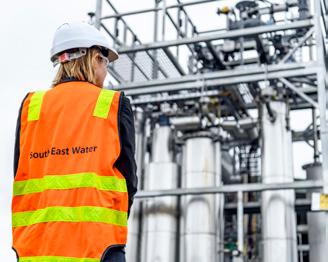
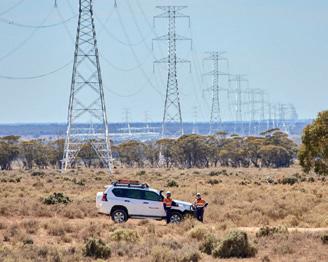
ACCELERATING ACTION
Revolutionising biochar production with new pyrolysis technology
South East Water’s Research and Development team works to identify emerging trends and technologies to help solve problems presented by wastewater management and treatment, particularly in relation to sustainability and the circular economy.
Working together for better drinking water in the bush .......... 30 Facility upgrade turning wastewater into a sustainable resource 34
Circularity in water – people are your greatest asset 36
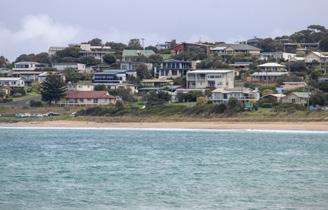
SMART METERS
Stanthorpe's Smart Water Network: a blueprint for water security ............................... 86
Gas will continue to play an important role in Australia’s journey to net zero –but how will gas supply and consumption change in the transition to clean energy? Project EnergyConnect: successfully delivering
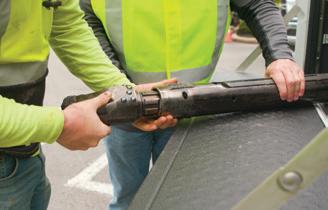
UTILITY • MAY 2024 WWW.UTILITYMAGAZINE.COM.AU 2 CONTENTS
Smarter
Leeton 92 EQUIPMENT Creating the ultimate AVK valve solution ............................... 94 Optimising small-volume chemical handling 96 Tackling challenges during wastewater pressure main realignment 98 HDD tooling changing the game 100 Innovative centralisers elevate industry standards ...................... 102 Durable drainage systems for utility demands 104 80 86 94
MANAGEMENT Making sure every heat pump hot water system is safe ............. 38 Participants, not recipients: consumers hold the key to Australia’s renewable power 40 AEMO GSOO:
.............. 44
leak detection: saving Apollo Bay’s water 88 Saving the day (and the beer) in
DEMAND
preventing gas shortfall
transmission project
ElectraNet’s largest
.................... 48
28
38 28 20


SUSTAINABILITY

The foundation days of NULCA
As the major representative body for locators in Australia, NULCA today provides essential leadership and support to its members and works to eliminate network damages, personal injury and costs to the community during excavation and construction activities.
Delivering a historic desalination upgrade for outback SA community 60
For the first time, residents and businesses in Marla can access safe and clean drinking water directly from their taps, with SA Water’s new desalination plant now operating in the Far North South Australian town.
Innovative solutions for hydrogen electrolysis 62 Interflow’s sustainability strategy: for climate, communities and our kids 64
Pioneering the global energy transition for a connected and sustainable future ........................ 66
Having the right equipment can make all the difference in the success of pipe maintenance. This article looks at how water jetting technology can both optimise operations and reduce the costs of maintaining these assets.
UTILITY • MAY 2024 WWW.UTILITYMAGAZINE.COM.AU 3 May 2024 ISSUE 42 In each issue Welcome from the Editor ������������������������������������������������������������������������������������������������������������� 1 A word from Energy Networks Australia ���������������������������������������������������������������������������������� 4 A word from WSAA ����������������������������������������������������������������������������������������������������������������������� 6 News briefs ������������������������������������������������������������������������������������������������������������������������������������ 8 Advertisers’ index �������������������������������������������������������������������������������������������������������������������� 108 Editorial schedule �������������������������������������������������������������������������������������������������������������������� 108 54 72 60
UTILITY LOCATION
Australia .......................... 52
Delivering smarter professional locating services with new technology ................... 55 Unified Utility Models helping engineers to trust underground data 56 CYBER SECURITY Cybersecurity challenges in the water and wastewater industries 58 INSPECTION, CCTV & CONDITION ASSESSMENT Enhancing visibility over operations at Endeavour Energy 68 Handling the pressures of water treatment with process automation ..................... 70 What is non-destructive testing and what are its advantages? 72 Revolutionising remote monitoring 74 The future of pipeline condition assessment................... 76 The
power of water jetting .......... 78
106
CHARTING THE COURSE – A SNAPSHOT OF THE ENERGY NETWORKS 2024 CONFERENCE
In the glass-panelled halls of the Adelaide Convention Centre, the future of energy took centre stage at the Energy Networks 2024 Conference, a convergence of industry experts and innovative thinkers. The jam-packed event left attendees with insights into the world's ever-evolving energy landscape.
The conference centred on the urgent need for energy transition, and amid the backdrop of global momentum towards net zero emission, the discussions ranged from the practical to the visionary.
A SEISMIC SHIFT
Throughout the conference several key themes emerged, shedding light on the change underway within the industry. Participants emphasised the need for a transformational, rather than merely transitional, leap in energy generation, networks and investments to meet Australia’s net zero commitments.
The conference location also showcased exemplary progress in renewable energy adoption, with South Australia poised to reach 100 per cent renewable electricity by 2027.
Insights from diverse perspectives outside the Australian energy sector offered fresh insights. Keynote speaker Laura Sandys CBE advocated for a deeper understanding of consumer needs, while Tim Jarvis AM highlighted the role of adventure in fostering commitment to the cause. Moreover, contributions from First Nations’ voices served as reminders of the just and holistic approach needed to navigate Australia’s energy transition.
The takeaway for energy professionals was clear – stay agile and informed to navigate the technological, regulatory and community acceptance path ahead.
INNOVATION SPARKS CONVERSATIONS
Technological strides shared the spotlight, particularly the development of smart grids and AI. A hands-on exhibit allowed attendees to interact with the next generation of energy tech, from drone-assisted maintenance to cutting edge engineering and consulting.
Machine learning algorithms, which predict potential system failures and weather-related disruptions, were a key talking point, emphasising the importance of preventative measures in minimizing outages and maintaining system integrity.
A shared resolution throughout the event was that our grids must continue to evolve – at pace – to support our transition. As they evolve to accommodate bi-directional flows and renewable sources, digitisation emerges as a crucial tool.
A COLLECTIVE STRIDE TOWARDS CHANGE
One of the most potent messages from the conference was the sheer necessity of cross-sectoral collaboration. These partnerships are vital cogs in the wheel of progress, enabling shared expertise and resources in the pursuit of a common goal – a robust energy system.
From the bustling exhibition floor to the deep-dive concurrent sessions, it was evident that networking was not just a by-product, but a crucial objective of the conference.
UTILITY • MAY 2024 WWW.UTILITYMAGAZINE.COM.AU 4 A WORD FROM ENERGY NETWORKS AUSTRALIA
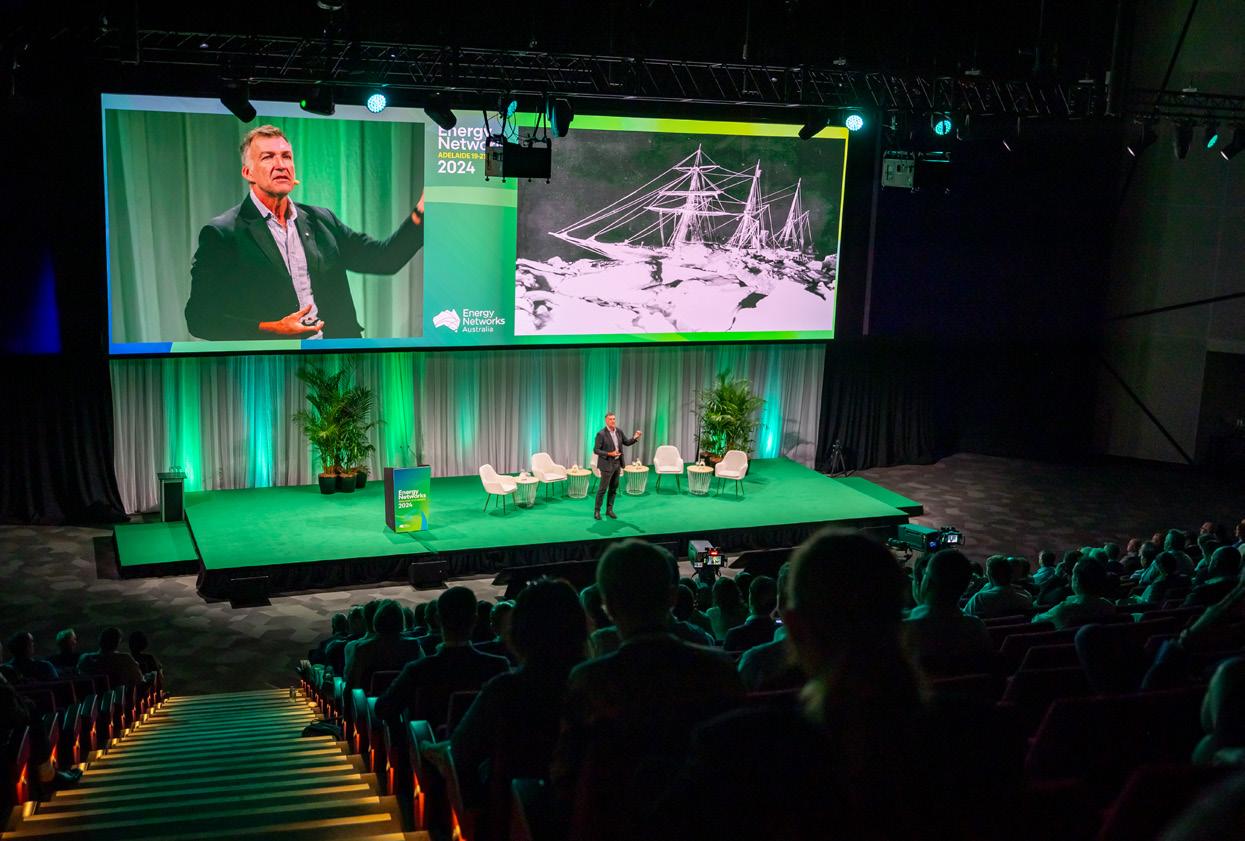

The connections made here, the case studies shared, and the strategies debated will undoubtedly ripple out into the real world, influencing decisions and pushing the boundaries of what's possible.
In the plenary hall and concurrent sessions, speakers acknowledged the significance of consumer engagement and the need to bridge the gap between industry initiatives and consumer expectations. Furthermore, the notion of energy justice emerged as a central tenet of the discussions, emphasising the need for a just transition that ensures equitable distribution of benefits and burdens.
POWERING THROUGH CHALLENGES
Yet, the conference wasn't just a showcase of triumphs; it was a platform for acknowledging ongoing and upcoming challenges. Discussions on cybersecurity stressed the importance of fortifying the grid against increasing threats, a concern for all given the rise in cyber-attacks on critical infrastructure in recent years.
The issue of equitable access to clean energy also spurred earnest conversations. As an industry, we must address the persistent energy divide; thus conference attendees considered the socio-economic implications of their business models and innovations.
THE FUTURE IS NOW
While the challenges that lie ahead are undoubtedly complex, the mood at the Energy Networks 2024 (EN2024) Conference was optimistic. The diverse perspectives and experiences that converged cast a light on all facets of energy networks – from transmission and distribution to regulation and consumer engagement.
For energy professionals, the conference delivered a clear message: the road to our energy future is paved with innovation, collaboration, and an unwavering commitment to transition.
The outcomes of the EN2024 conference have set the stage for an incredibly dynamic period. In the energy sector, change is the only constant and events like EN2024 are significant beacons, charting the course for industry evolution and the quest for a more affordable, sustainable, and resilient energy framework. The future of our energy systems hangs in a delicate balance, and it lies within the hands of those who dare to innovate and imagine a brighter, cleaner tomorrow.
A future fuelled by clean, efficient, and reliable energy is not just a distant dream – it's a vision that's being meticulously charted by industry professionals today. And with initiatives like EN2024 charting the course, the outcomes of this collective quest are as promising as they are imperative.
5 UTILITY • MAY 2024 WWW.UTILITYMAGAZINE.COM.AU
ENA CEO DOM VAN DEN BERG MODERATING A PANEL SESSION.
ADVENTURER TIM JARVIS AM DELIVERS A KEYNOTE.
A WORD FROM WSAA
ELEVATED INVESTMENT ENVIRONMENT
REINFORCES NEED FOR A NATIONAL AGREEMENT
As the Productivity Commission completes its inquiry on the progress of all Australian governments in achieving the objectives, outcomes and timelines anticipated under the 2004 Intergovernmental Agreement on a National Water Initiative (NWI), it is time to reflect on the heightened need for a new national agreement.
The drivers of change are well known. They centre on maintaining ageing assets and service levels, servicing rapid population growth and responding to climate change. Each of these challenges are now forcefully driving necessary investment to record levels. The water industry is expanding. The scale of changes across the industry could place pressure on existing pricing and institutional governance arrangements.

However, these assets need higher levels of maintenance and upgrade if they are to continue to provide services for future generations.
In turn, rapid population growth means that we need to provide further capacity. This is required in both our underground pipes and in our sources of water. We need to provide higher levels of treatment to used water to protect our precious inland waterways and beaches.
With record levels of investment required (WSAA’s forward looking data on capital expenditure shows a doubling of investment by 2027 to more than $10 billion annually) the era of flat prices is over in many jurisdictions and the future will be one of managed price increases.
There are short term and long-term factors that impact upon water prices. In the short term, inflation and rising costs are affecting water as these pressures affect all industries. But the long-term factors will increasingly be the most important. These are:
• The need to maintain and upgrade an ageing asset base
• The need to provide services to a rapidly growing population, and critically,
• The need to be resilient in the face of climate change. The dams, pipes, and treatment plants used to provide water and treat and manage wastewater last a long time. Many of these assets were built, and paid for, by generations past. These assets have lasted well and have not required a significant contribution from the current generation.
These issues are compounded by the impact of climate change. We need to provide water supplies in an increasingly uncertain climatic outlook. There is a need to diversify our sources of water to incorporate non-rainfall dependent sources of supply including further desalination, recycling for industry and purified recycled water for drinking.
The elevated investment environment and associated price impacts in Australia reinforces the need for national reform. Rising prices will directly and indirectly affect many elements of a new agreement. Directly they will test the full cost recovery model across jurisdictions, and it is important that these existing elements of the NWI be reinforced. Utility balance sheets will also come under pressure and it will be important that all governments commit to maintaining an investment grade credit rating for water utilities. Under all circumstances, unless we have a strong water industry, water security, regional water services and closing the First Nations water gap will all be significantly harder.
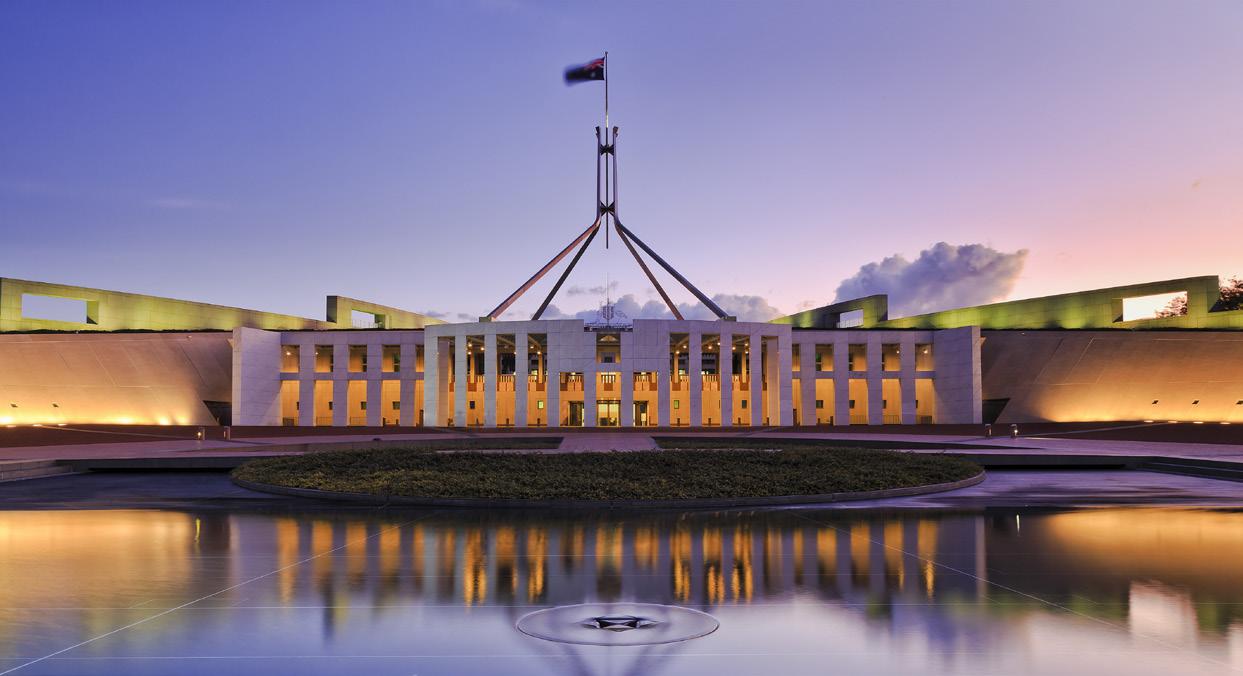
SECTION
Read WSAA’s submission to the Productivity Commission’s Inquiry into National Water Reform at www.wsaa.asn.au/publication/submission-productivity-commission-inquiry-national-water-reform-2024
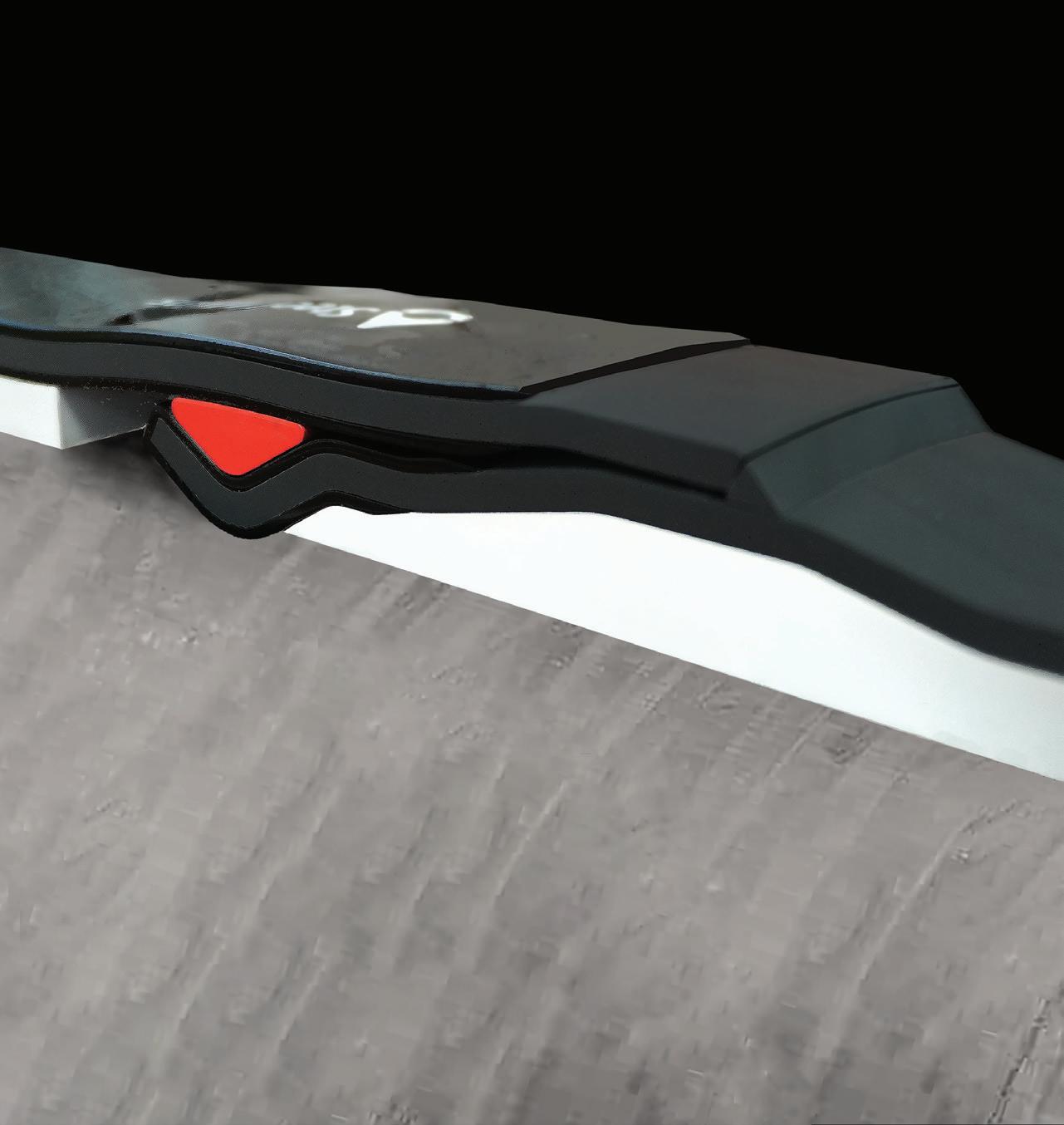

SINTALOCK® II - A REVOLUTIONARY JOINT DESIGN FOR AN EVER-EVOLVING WATER PIPELINE INDUSTRY
A step forward into the future of the water industry, Steel Mains’ Sintalock® Type II Rubber Ring Joint is an Australian-made fully restrained joint for high pressure water pipelines that goes further beyond today’s standards than any other joint in the market.
With no need to enter the pipe for welding or lining reinstatement, safety is optimised while corrosion protection is fully enhanced and laying rates are maximised.


www.steelmains.com



QLD GOV TO DOUBLE SIZE OF WAMBO WIND FARM
The Queensland Government has announced plans to almost double the capacity of Wambo Wind Farm in the state’s southwest, adding an extra 41 turbines to the project.
The Queensland Government had previously committed to a 42 turbine wind farm in Jandowae, with an extra 41 turbines to be added to the project.
The state government said the additional turbines are expected to add enough generation to the overall project to power the equivalent of 312,000 homes with renewable energy once complete.
It also said that the Queensland Energy and Jobs Plan and renewable energy projects, including Wambo stages one and two, are expected to save households about $150 each year by 2032, while small businesses will see a reduction of around $1,495 off their annual power bills.
The government said that wholesale prices are expected to decrease by approximately 15 per cent by 2040 due to Queensland’s plan to transition to renewable energy.
Doubling the size of Wambo means the facility is predicted to generate 506MW of energy by 2026, with the 83 turbines reaching 247m up in the air.

UTILITY • MAY 2024 WWW.UTILITYMAGAZINE.COM.AU 8 NEWS Lanco Group personnel is comprised of professionally qualified engineers that receive ongoing training both externally and in-house to continually develop a strong understanding of design and construction principles. Providing strategic and significant civil engineering services since 1998. Level 2, Suite 26/20 Enterprise Drive, Bundoora, Victoria, 3083 1300 1 LANCO (52626) / tenders@lancogroup.com.au lancogroup.com.au
The wind farm, which will feature some of the largest onshore wind turbines in the nation, will contribute to Queensland’s target of 70 per cent renewables by 2032.
The government said the project will boost the local economy, with about 200 direct construction jobs and up to 500 more indirect jobs during the multi-year build.
Foundations for the first wind turbines on stage one are underway with construction of stage two expected to commence in mid-2024.
Commercial operation of stage one is projected for 2025, while stage two is projected for 2026.
The project is expected to create an additional eight ongoing jobs.
The project is being delivered in partnership between publicly owned energy company, Stanwell Corporation, and global sustainable developers, Cubico.
Under the venture, Stanwell will own 50 per cent of the energy produced, and will purchase the rest of the power from Cubico under a 15-year agreement.
Wambo Wind Farm stages one and two are backed by a $455 million investment from the Queensland Government’s Queensland Renewable Energy and Hydrogen Jobs Fund for Stanwell’s share in the project.
Queensland Minister for Energy and Clean Economy Jobs, Mick de Brenni, said, ”Queensland has the cheapest power of any state in Australia thanks to our nation-leading cost of living relief support and growing renewables base.
“Queensland has been the world leader in rooftop solar, and now we are building world-class wind power thanks to
partnerships between publicly owned energy companies like Stanwell, and world-renowned clean energy company Cubico Sustainable Investments.
“Queensland’s abundant wind resources are attracting growing global interest, creating jobs and economic opportunity for Queensland,” Mr de Brenni said.
Stanwell CEO, Michael O’Rourke, said, “Wambo Wind Farm is one piece of Stanwell Corporation’s rapidly advancing portfolio of renewable energy assets. It is the 14th renewable energy project in which we have an interest or offtake and moves us one step – or 41 turbines – closer to our target of nine to 10GW of clean energy by 2025.
“We are thrilled to partner with global clean energy leader, Cubico Sustainable Investments on the next stage of Wambo Wind Farm,” Mr O’Rourke said.
Cubico Head of Country, David Smith, said, “As a world leading renewable energy company, Cubico is proud of our role assisting Queensland to achieve its ambitious renewables goals, with more than 500MW achieving construction to date.
“Cubico’s pipeline of development projects is at 2GW and growing, signalling our commitment to being a key partner in the decarbonization of Queensland’s and Australia’s energy landscape and a long-term partner for local communities.
“Cubico is proud to be partnering with Stanwell with the expansion of Wambo Wind Farm to further deliver upon the Queensland Government’s Energy and Jobs Plan,” Mr Smith said.
No time to waste!
Explore Grundfos Wastewater Pumps for Municipal and Industrial Use
SCAN TO LEARN MORE




UTILITY • MAY 2024 WWW.UTILITYMAGAZINE.COM.AU 9 NEWS www.grundfos.com/au
SCAN HERE
YARRA VALLEY WATER CROWNED VIC’S BEST TASTING TAP WATER
The Water Industry Operators Association (WIOA) has announced the Victorian winner of the 2024 Ixom Best Tasting Tap Water in Australia competition.
Yarra Valley Water took out the top prize over finalists Barwon Water, North East Water and Central Highlands Water at WIOA’s 85th Victorian Water Industry Operations Conference and Exhibition.
Competition judges included De.mem-Stevco Director, Steve Russell, Albury City Council Team Leader Treatment Services (Water and Wastewater), Heidi Josipovic, and IXOM representative Zarif Yazid.
The judges were in agreement that all the samples were of a very high standard across the three categories, odour, taste and clarity.
Yarra Valley Water will now go on to battle it out against the best from other states for the Australian title in November 2024.
The 2024 national competition will be hosted in Tasmania, after TasWater’s Fern Tree water treatment plant took out the Australian title in 2023.
Water samples are subjected to a blind taste test and rated according to the Water Tasting Wheel, which










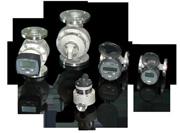


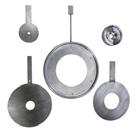


UTILITY • MAY 2024 WWW.UTILITYMAGAZINE.COM.AU INSTRUMENTATION & CALIBRATION PTY LTD SPECIALISTS AMS have been suppliers of instrumentation and calibration equipment to all industries since 1973 representing some of the world’s leading manufacturers of the equipment in their field. www.ams-ic.com.au Flow Measurement Specialists www.ams-ic.com.au sales@ams-ic.com.au NEWS 10
outlines some of the attributes that water professionals use when judging water such as colour, clarity, odour and taste – think wine tasting without needing to spit out the samples and you won’t be far wrong.
The winner of the IXOM 2024 Best Tasting Tap Water in Australia competition will have the opportunity to represent Australia at the annual Berkeley Springs International Water Tasting Competition in West Virginia, US.

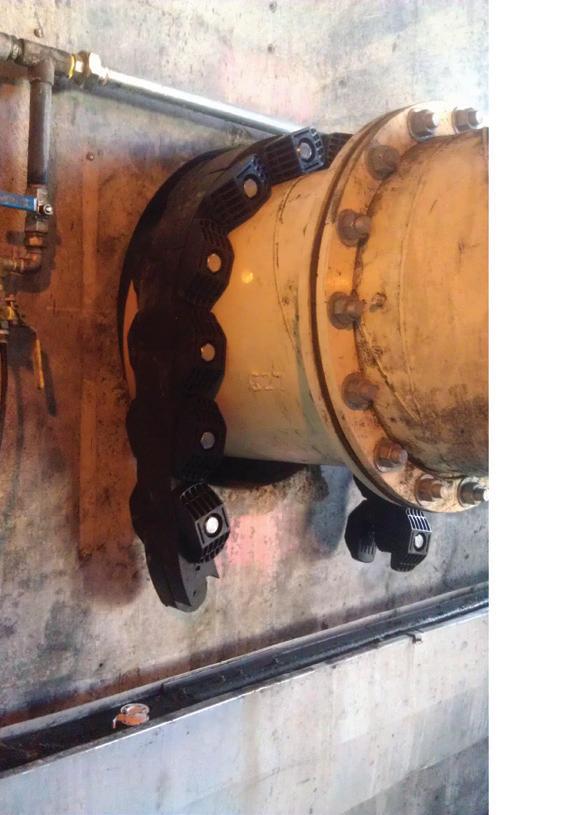

Pipe Penetration Seal Solutions
Link-Seals offer hundreds of solutions to seal pipe penetrations ranging in size from 10mm to 3.6 metres diameter.
Link-Seals are suitable for most types of pipes including PVC, HDPE, Copper and Steel.
Resistant to water, oil, gas, aggressive chemicals and fire.
Projex Group helps calculate the right Link-Seal size and model for your application.
Link-Seal
mail@projex.com.au


Link-Seal
1800 001 114 11 NEWS
UTILITY • MAY 2024 WWW.UTILITYMAGAZINE.COM.AU
FED GOV INVESTING IN FIBRE INTERNET UPGRADES FOR NSW AND VIC HOUSEHOLDS
Two million households and businesses in New South Wales and Victoria will now be able to upgrade to fibre-to-the-premises (FTTP) internet from slower, less reliable copper connections.
The Federal Government said FTTP is capable of delivering speeds 18 times faster than the average broadband connection over copper, and is less likely to drop out or degrade.
The milestone means more people than ever before across both states will be able to access faster speeds while streaming, gaming and working from home.
Following NBN Co’s initial construction work, fibre upgrades are available on-demand at no installation cost when an eligible household or small business takes out an eligible higher-speed plan.
Average data usage in Australia has increased ten times over the past ten years, with the average home now hosting 21 internet-connected or smart devices.
NBN Co is currently consulting with industry on a new plan to turbocharge speeds available over the network. The plan

would give customers who upgrade to full-fibre speeds of up to 500Mbps, at no extra wholesale cost.
Upgrades to full fibre access will continue across the country, with the Federal Government investing $2.4 billion to expand full-fibre access to an additional 1.5 million premises, including more than 660,000 in regional communities.
Upgrades to the network are designed to enable more than ten million homes and businesses to access NBN Co’s fastest residential speed plan by the end of 2025.
Federal Minister for Communications, Michelle Rowland, said, “Fast and reliable full-fibre broadband unlocks greater social inclusion and economic productivity. It’s essential infrastructure in 2024.
“This is a fantastic milestone for two million households in New South Wales and Victoria who have been saddled with slow and unreliable copper technology.
“Access to this technology is a gamechanger for families who have had to struggle with drop outs and slow speeds over copper,” Ms Rowland said.

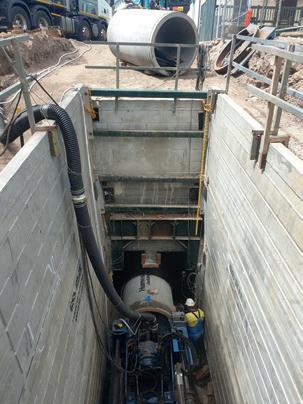

UTILITY • MAY 2024 WWW.UTILITYMAGAZINE.COM.AU Unit 2 / 85 Heatherdale Road, Ringwood Vic 3134 PO Box 2500, North Ringwood Vic 3134 P: (03) 9872 4596 | F: (03) 9872 3293 | E: info@pezztrenchless.com.au | W: pezztrenchless.com.au Still the
up to
Used for gravity sewers, water mains, storm water, gas
electrical conduits. Specialists
all sizes The
NEWS 12
market leaders in laser guided microtunnelling Bore diameters from 325mm
2800mm
and
in “free bore”, sleeve boring and pipe jacking in
Next Generation in Trenchless Technology



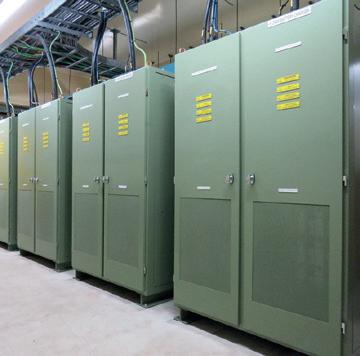







Protect your critical assets with the most reliable systems made in Australia.

Century Yuasa has been protecting critical power assets for 30 years with our local design, construct and onsite teams. Our DC systems are built with the best of global technologies and supported with the globally recognised Yuasa VRLA batteries which are the only batteries you can genuinely rely on to protect your critical assets and business services year after year.
To learn more about Australia’s own DC power systems, maintenance services, and the Yuasa range of VRLA batteries, visit our website.
For enquiries call 1300 364 877 https://cyb.com.au/industries-markets/industrial

PROJECT ENERGYCONNECT RECEIVES LEADING SUSTAINABILITY RATING
The Infrastructure Sustainability Council (ISC) has awarded Transgrid’s EnergyConnect project a design sustainability rating of ‘leading’, in recognition of industry-leading initiatives in the design and delivery of the critical interconnector.
It is the first project to receive an official sustainability rating in Australia.
Transgrid Chief Executive Officer, Brett Redman, said, “Transgrid and our construction partner Elecnor Australia are going above and beyond to set the benchmark in sustainability best practice for the future pipeline of energy transmission projects across the country.”
Key sustainability measures being implemented on EnergyConnect include:
• A 35 per cent reduction in clearing on the western alignment (South Australian border to Buronga) and eleven per cent reduction on the eastern section (Buronga to Wagga) to preserve valuable biodiversity including trees up to 1,000 years old. Hundreds of thousands of trees have been physically inspected by arborists to assess their archaeological, ecological and cultural significance. Many trees, including Aboriginal scar trees, have been retained within the transmission line easement while still complying with vegetation clearance requirements. Annual inspections will ensure the lines stay clear to prevent bushfires
• Using guyed towers that require 21 per cent less steel and 15 per cent less concrete to construct compared to conventional self-supporting structures

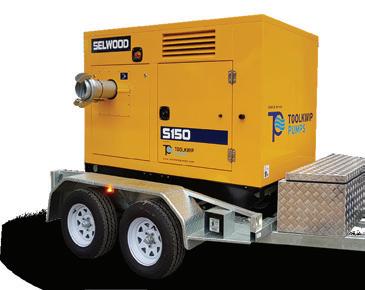


14 UTILITY • MAY 2024 WWW.UTILITYMAGAZINE.COM.AU
NEWS Visit us online for more info toolkwippumps.com.au P: +61 3 8805 0500 E: sales@toolkwippumps.com Available in: NSW • VIC • QLD • SA • TAS ECO FRIENDLY PUMPING Pumping Solutions for the Utility Sector DEWATERING • SEWER BYPASS • BULK WATER SUPPLY S RANGE FEATURES + Auto-prime to 8.8m + Vortex impeller for superior solids handling + Run dry + Eco-friendly HYDRAULIC SUBMERSIBLE PUMPS HOSES & ACCESSORIES
• Locating transmission line structures to avoid valuable biodiversity and culturally sensitive sites.
• The use of low carbon concrete in tower footings and substations. Contractors are required to use concrete with 35 per cent supplementary cementitious materials (SCMs) and 30 per cent replacement of virgin fine aggregate with manufactured sand (where available).
• Replacing tree hollows with nestboxes to provide fauna habitat for local species, with more than 1,500 installed on the western alignment, and thousands more to follow on the eastern section.
• A 31 per cent reduction in construction water use by using non-water based dust suppression alternatives and grey water from worker accommodation camps.
• A 78 per cent replacement of potable water with non-potable sources including treated grey water from worker accommodation camps.
• Enduring benefits for local communities along the project alignment including the multi-million-dollar Legacy 100 program to train Australia’s own transmission line construction workforce and a $2 million scholarship fund for engineering students at Charles Sturt University.
• Reducing waste to landfill including recycling 400 tonnes of wooden pallets and 50,000 cans and bottles from worker accommodation camps.
• Comprehensive physical climate change risk assessments to safeguard the new infrastructure against the changing climate through the introduction of treatment and mitigation strategies in the design, construction and operation of EnergyConnect.

Elecnor Australia Operations Director, Samuel Basanta Lopez, said, “This is a significant project milestone that occurred across nearly all project disciplines and in collaboration with Transgrid. We are immensely proud of the result.
“As a Project Team we strive to maximise positive environmental, social and economic outcomes throughout all stages of our design and construction activities. We value sustainable development and believe respect for the environment and the community in which we operate are fundamental to business success.”
Infrastructure Sustainability Council Acting Chief Executive Officer, Patrick Hastings, said, “Congratulations to the EnergyConnect team and Transgrid on achieving a Leading IS Design Rating. Through this project they have demonstrated their commitment to sustainability by being the first to achieve a Design Rating on a transmission project. EnergyConnect is well-positioned to deliver an asset that will provide a positive ecological benefit while also minimising its contribution to GHG emissions. This is a monumental step for transmission projects and an encouraging sign of progression in the sector.”





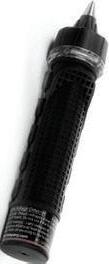
15 NEWS UTILITY • MAY 2024 WWW.UTILITYMAGAZINE.COM.AU
NT TO RECEIVE $53.1M OF WATER SUPPLY PROJECTS
In an effort to shore up water security for remote communities in the Northern Territory, the Federal and Territory Governments are investing $53.1 million in the development of a number of water supply projects.
In Maningrida, the two governments are investing $21 million for three infrastructure upgrades to increase the reliability of the local water supply network. This work will increase water storage capacity via the construction of a water tank, new pipes to move the water from the water storage to the community and upgrades to the water network.
On the Gove Peninsula $8.9 million is being invested which will upgrade a water pipeline in Yirrkala – to save water that is currently being lost –and includes a water infrastructure assessment for Gunyangara to identify water infrastructure needs.
In Numbulwar the governments are investing $3.2 million in planning and investigation work, such as investigative drilling, to identify new water supplies.
The Federal Government has said that these projects are an important step in its $150 million investment to make sure remote First Nations communities have access to clean drinking water.
It follows the $26.7 million funding previously announced for Yuendumu and Milingimbi, where work on these projects has also created numerous economic and community benefits including the ability to build much-needed new housing.
The governments have also said that reliable water is vital for tourism and economic development, which is why in Yulara they are together investing $18.2 million, along with $5 million from Voyages Indigenous Tourism Australia, to construct the Yulara Water Supply project.
The project will provide water security for what is the primary service centre for the Uluru-Kata Tjuta National Park and the wider Ngaanyatjarra Pitjantjatjara Yankunytjatjara regions.
The Federal Government is also investing $1.8 million towards science and research projects to help plan for future water management.

16 UTILITY • MAY 2024 WWW.UTILITYMAGAZINE.COM.AU NEWS
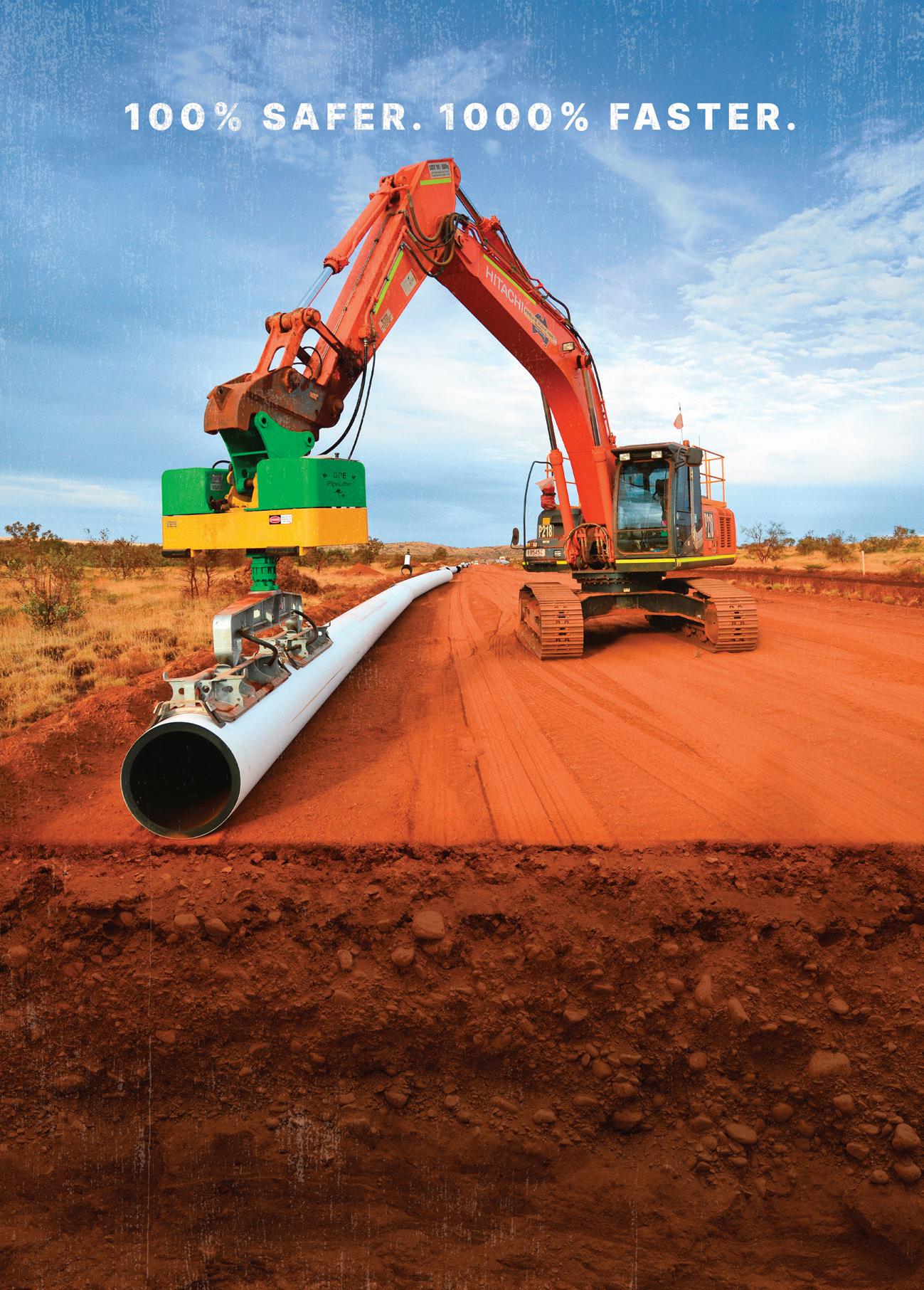
The PL1500 is a gamechanger for pipeline construction. The unique, quick-hitch, vacuum lifter attaches to your existing excavator, reducing your machine hire cost and getting things moving fast. Capable of safely lifting 15,000kg, the heavy-duty, self-contained unit can handle all types and lengths of pipe. It integrates seamlessly with the host excavator, using the main controls and hydraulics to operate the vacuum lifter. Plus, built-in smart tech ensures it’ll only pick up or put down a pipe on a solid surface. That’s safer than many other vacuum lifters on the market. To find out more, speak to the Pipeline Plant Hire team today.

ONE CALL - PROBLEM SOLVED 1300 367 046 PIPELINEPLANTHIRE.COM.AU
PIPELINE DRILLERS
With over two decades of expertise in trenchless technology, our proudly Australian-owned company has grown from strength to strength. Boasting 11 cutting-edge directional drilling rigs, 2 pneumatic pipe rammers and a skilled team of over 40, we’re your go-to for HDD projects of any scale.



795 HDD Pipelines Installed 2033m Longest HDD Installed 100-2050m Bore Lengths 25-1500mm Hole Diameters
450-1520mm Steel Casing Ramming 10 Ocean Outfalls Installed
UNEARTHING EXCELLENCE
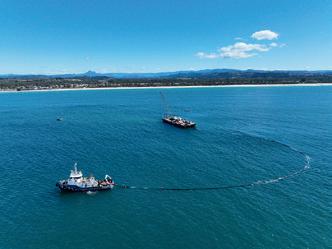



sales@pdgroup.com.au www.pdgroup.com.au 07 3390 4740

YOUR TRUSTED VEGETATION EXPERTS! YOUR TRUSTED VEGETATION EXPERTS!
Vegetation Management (power line, gas pipeline, land and easement clearance)
Tree Lopping and Weed Control
Environmental Services
Mulching Machine and Equipment Hire

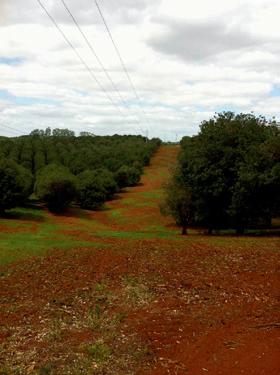
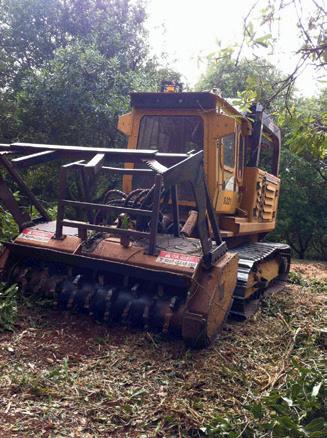
P | 07 3288 8800 W | www.savco.com.au E | info@savco.com.au
SAVCO SAVCO SERVICES SERVICES
ACCELERATING
THE DELIVERY PATH FOR RENEWABLE ENERGY ZONES
 By Terry Chapman, APA General Manager, Project Delivery
By Terry Chapman, APA General Manager, Project Delivery

The development of renewable energy infrastructure alone is an enormous task, made all the more challenging by labour and supply chain shortages, planning delays and community pushback. Here, APA General Manager, Terry Chapman, shares some insight into how governments can tackle these challenges and fasttrack the delivery of renewable energy zones.
UTILITY • MAY 2024 WWW.UTILITYMAGAZINE.COM.AU 20
INDUSTRY INSIGHTS

The withdrawal of coal from our energy system and the concurrent build-out of renewable energy zones (REZs) across the country is a monumental undertaking.
Australia currently generates approximately 35 per cent of its power from renewables and this journey has taken the best part of two decades.
If the Federal Government is to meet its target of 82 per cent renewables by 2030, we need to deliver in six years more than one and a half times what has been delivered in the last 20.
And we are facing this challenge against a backdrop of significant global competition for skilled labour and critical minerals, along with rising costs, environmental concerns, planning delays and increased community focus on the impacts of these major projects.
As a proudly Australian-owned and listed energy infrastructure business, APA sees several opportunities for governments to address these issues and accelerate the delivery of infrastructure for REZs.
STREAMLINING PROJECT APPROVAL
First, the process of selecting a preferred consortium to deliver these projects could be simplified. The rising cost of capital and a tight domestic employment market means governments can’t afford to have multiple organisations tied up in a tender process for up to 12 months before work commences.
At present, there is more work to do than resources to deliver it. While commercial processes need to remain transparent and competitive, contractual frameworks need to pivot to address current market constraints and to ensure projects can move to delivery sooner.
UPSKILLING THE WORKFORCE
Second, we must continue to build technical skills and capabilities in the domestic market.
Australia is currently in deficit when it comes to the skilled labour capacity required to deliver high voltage substation and transmission line projects at the scale required. And these challenges are more acute given skills and resources will be needed in regional areas. Upskilling the existing workforce from adjacent infrastructure projects is one opportunity. We must also accelerate investment in apprenticeship programs to develop a pipeline of the right trades.
Federal Skills Minister Brendan O’Connor recently noted the slow uptake of spaces in the New Energy Apprenticeships Program launched in 2023. The Federal Government needs to balance attracting more young Australians into the energy sector with the opportunity for skilled migration to help us fill the gaps.
Global partnerships also have a role to play. International know-how and best practice needs to be linked with Australian organisations to deliver this huge program of work.
For example, APA has partnered with leading global energy infrastructure organisation EDF Group to leverage their leading global experience in electricity transmission infrastructure delivery with APA’s strong local experience in the construction and operation of critical energy infrastructure. This will ensure we are well positioned to deliver emerging projects in what is a highly competitive environment.
BUILDING AN EXTENSIVE SUPPLY CHAIN NETWORK
Third, we must look to our past to help secure our future. New South Wales, Victoria and Queensland have all delivered major transport and infrastructure projects over the last decade that have created a valuable skills legacy and extensive supply chain network.
I was proud to be the Project Director of Australia’s largest ever road infrastructure project – the recently completed WestConnex in New South Wales.
The scale and complexity of WestConnex has accelerated the experience of a large cohort of contract administrators, commercial analysts, planners and community engagement specialists. The project has also built significant expertise in engineering and design, construction management, commissioning and operation along with skills in critical trades.
We must now move quickly to attract these people to the energy sector, with many of the skills needed for electricity transmission projects being transferrable.
We must also leverage the learnings around community engagement from these mega transport projects. While the infrastructure might be different, the reality is the issues faced are much the same.
The significant landholder and community opposition to REZs is not unlike that faced during the delivery of WestConnex. It wasn’t so long ago that this project was subject to community protests and local councils preventing road access and refusing to grant construction permits.
But with a clear process for engagement and ongoing efforts to listen and build community trust, the infrastructure was delivered responsibly.
At APA, as we consider future REZ projects, we are already thinking about how we can best engage with the community, how we can minimise impact, and importantly, what legacy we can leave.
Governments and successful consortia must clearly communicate these short and long-term benefits. Employment and skills development, investment in regional businesses, positive engagement with communities are just some examples.
That's not to say these challenges will be easy to overcome. However, thinking innovatively and leveraging the significant knowledge and expertise across the infrastructure sector will give us a great chance of meeting our renewable energy targets.
21 UTILITY • MAY 2024 WWW.UTILITYMAGAZINE.COM.AU
INDUSTRY INSIGHTS
OF LONG-TERM, TANK BASE CORROSION PROTECTION The Next Generation
If left untreated tank base corrosion is a serious risk that will compromise the integrity of water storage systems, resulting in leaks, contamination and structure failure. Here, Denso Australia discusses the importance of implementing long-term corrosion prevention solutions, and answers some questions about its innovative visco-elastic coating system.
Since the beginning of 2024, the team at Denso Australia have been hard at work training applicators nationwide on the ins and outs of its latest innovation – the Viscotaq™ Tank Chime Sealing System.
Here, the team have compiled the questions most commonly raised at these training sessions and shared some insights into what the system offers, how it can be applied and how long users can expect the corrosion protection to last.
WHY IS TANK BASE/CHIME CORROSION PROTECTION AN IMPORTANT CONSIDERATION?
Water industry decision-makers understand that the repercussions of neglecting tank base corrosion are farreaching. Compromised tank integrity can lead to issues including contamination, leaks, and eventual structural failures – all of these outcomes are usually both costly and hazardous.
As such, long-term corrosion prevention solutions are not merely beneficial, they’re essential for ensuring the safe and reliable operation of water storage systems as well as for safeguarding the environment from potential contamination.
Denso’s Viscotaq™ Tank Chime Sealing System has been designed to combat the issues listed above by preventing water infiltration at the concrete ring wall interface of a tank; the area of a tank where corrosion is most likely to occur.
WHAT IS VISCOTAQ™?
Viscotaq™ are Denso Australia’s next generation of truly surface tolerant, visco-elastic coating systems which can be applied to pipelines (straight run pipe, t-sections, field joints, soil to air transitions), structural steel and tank bases/chimes.
WHAT ARE THE COMPONENTS OF THIS NEXT GENERATION SYSTEM?
The Viscotaq Tank Chime Sealing System consists of a suitable concrete coating, the use of a sealant, a mastic, a visco-elastic coating system and a UV topcoat. We’ve summarised each component below:
1. Concrete Coating
A Denso-approved coating such as Protal™ ST Epoxy or SeaShield™ 550 Epoxy to ensure a sound substrate for the other system components to adhere to.

2. Sealant
In cases where an annulus or void between the annular ring and the tank base exceeds 0.5 inches, Viscotaq ViscoSealant is used to fill these gaps, ensuring a uniform and secure base for the sealing system.

UTILITY • MAY 2024 WWW.UTILITYMAGAZINE.COM.AU 22
INDUSTRY INSIGHTS | Sponsored editorial
3. Mastic
Viscotaq ViscoMastic is used both in instances where the sealant is required and also when it is not required. ViscoMastic is used to seal all voids, gaps, and cracks between the base of the tank and the ring wall.

4. Visco-elastic coating system
Viscotaq EZ Wrap is applied over the mastic. This wrap is designed with a paintable backing to assist with the application of the topcoat.

5. UV Topcoat
A Denso approved topcoat is used to paint over the Viscotaq™ EZ Wrap (which has a paintable backing) to add strength to the system and prevent any breakdown due to possible UV rays.
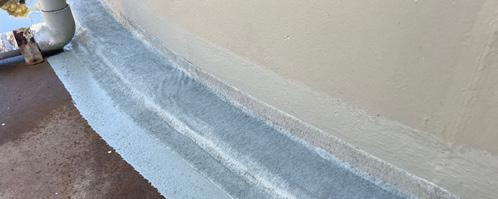
A VISCOTAQ PEEL TEST REVEALING 100 PER CENT ADHESION OF THE MATERIAL TO THE SUBSTRATE AND CORRECT SURFACE PREPARATION.
WHAT ABOUT SURFACE PREPARATION?
The minimal surface preparation required for the system is St2/SP2. Applicators are required to remove all oil, grease and other contaminants from the surface of the substrate using an approved solvent. Following this, the use of a wire brush is required. It is essential for the surface of the substrate to be dry and free from rust, scale and other foreign matter. In order to evaluate the effectiveness of your surface preparation, you’ll need to conduct a ‘peel test’, a process that the Denso team covers in its training sessions.
WHAT IS THE EXPECTED SERVICE LIFE OF THIS SYSTEM?
As is the case with all applications, a system’s service life is reliant on the quality of the materials applied and the way in which they have been applied. For this reason, Denso ensures that its applicators are highly trained and have an intimate understanding of the system before going on site. If applied correctly, Viscotaq systems should have a service life exceeding 20 years. This figure is based on many Viscotaq applications from around the world that have been applied more than 20 years ago and are still in excellent condition.

HOW CAN I BOOK TRAINING AND LEARN MORE?
To request a training session, please contact National Viscotaq™ Manager, Adam Matthews at adam@densoaustralia.com.au or call +61 458 837 300.
To view and download all current literature on the Viscotaq Tank Chime Sealing System, please visit: densoaustralia.com.au/products/viscotaq-tank-chime-sealing-system/
UTILITY • MAY 2024 WWW.UTILITYMAGAZINE.COM.AU 23 Sponsored editorial | INDUSTRY INSIGHTS
SECURING A SUSTAINABLE WATER FUTURE
As climate change and population growth continue to put drinking water supplies under pressure, water utilities are exploring all options to ensure a secure and diverse water supply for generations to come.

In South East Queensland, the population is expected to grow by two million people over the next 25 years. Ensuring a plentiful, safe, reliable, affordable and sustainable water future for the communities in our service region is a big job – and one that will require multiple solutions.
Non-potable recycled water is one such solution. By increasing our use of recycled water for industry, agriculture and irrigation, we’re easing pressure on our drinking water supplies and reducing nutrients to waterways. Using recycled water can also help lower an organisation’s carbon footprint and achieve ESG objectives.
HOW RECYCLED WATER WORKS
Recycled water means turning wastewater into a non-potable but usable water product. This water can be used for irrigation, cooling or other uses that don’t involve consumption or contact.
Existing wastewater treatment plants can be upgraded to create recycled water. Plants that can create recycled water are known as Resource Recovery Centres (not to be confused with plants that can create Purified Recycled Water which is suitable for drinking – those are known as Advanced Water Treatment Plants).
The process follows on from traditional wastewater treatment, which takes influent flow (the undiluted wastewater that flows to the treatment plant for processing) and processes it into effluent, which is normally released safely back to the environment. Resource recovery centres turn this effluent into recycled water via treatment, and export it to customers via a dedicated network of pipes.
HOW RECYCLED WATER IS USED
Here’s a look at how much recycled water is produced at Resource Recovery Centres across Urban Utilities’ service regions of Brisbane, Ipswich, Lockyer Valley, Scenic Rim and Somerset.
FY22
• 8,877ML of recycled water (RW) was produced from 149,223ML of effluent, indicating that 5.94 per cent of the effluent was utilised as recycled water
FY23
• 10,443ML of RW was produced from 116,415ML of effluent, indicating that 8.97 per cent of the effluent was supplied as recycled water
• Out of 10,443ML, 35 per cent of RW was supplied for industrial purposes, 44.7 per cent was used for irrigating sporting fields and parks, and 19.6 per cent was used for agriculture and 0.7 per cent was used onsite for irrigation or other purposes
1ST JULY TO 31ST DECEMBER 2023
• 56,472ML of effluent was produced from 60,630ML of influent, out of which 3,856ML of RW was exported and supplied to various customers
• 31 per cent of RW was used for industrial purposes, 9 per cent was utilised for institutional purposes, and 41 per cent was used for irrigating parks and gardens. 0.8 per cent was used for site irrigation and other purposes
WHO IS USING RECYCLED WATER?
Recycled water can meet all kinds of industry, agriculture and irrigation needs.
For example, Urban Utilities supplies recycled water to the Kilcoy Race Club to keep the track lush and green all year-round, no matter the rainfall.
The utility is also using recycled water for its own environmental initiatives. Urban Utilities has planted 1,600 native trees at the Helidon Wastewater Treatment Plant to create a new local koala habitat. The blue gum plantation is irrigated with recycled water.
At the Toogoolawah and Boonah Wastewater Treatment Plants, the utility is growing five hectares of vetiver grass and irrigating it with recycled water. The grass is regularly harvested and donated to farmers for use as livestock fodder.
Urban Utilities has also supplied recycled water to Brisbane Airport Corporation to support the construction of Brisbane’s new runway, saving more than 500 Olympic-sized swimming pools of drinking water.



UTILITY • MAY 2024 WWW.UTILITYMAGAZINE.COM.AU 24
INDUSTRY INSIGHTS | Sponsored editorial
For more information on recycled water in South East Queensland, visit urbanutilities.com.au/business/business-services/recycled-water
ULTRA STRONG. FAST. VERSATILE.


A VERMEER EXCLUSIVE. CHANGING THE DRILLING GAME FOREVER.
The Ultra X3 drilling system is designed for utility-sized rigs (up to 40,000-lb) digging in most ground conditions. Equipped with a unique, non-torqued spline connection system, it offers compatibility with a wide range of pilot bit and pullback configurations. This enhances the operator’s ability to move from one drill to another and maintain familiarity with the HDD tooling, and eliminates the need for starter rods and adapters in select applications. Contact your local HDD specialists today.


VERMEERAUSTRALIA.COM.AU | 1300 VERMEER Vermeer and the Vermeer logo are trademarks of Vermeer Manufacturing Company in the United States and /or other countries. Product specifications are subject to change by OEM. © 2024 RDO Equipment Pty Ltd (trading as Vermeer Australia). All Rights Reserved.
JEMENA’S NEW MANAGING DIRECTOR PREPARING OUR NETWORK FOR THE FUTURE:
Appointed Managing Director of Jemena in late 2023, after 17 years with the business, David Gillespie’s wealth of leadership experience and long history in the industry made him an obvious choice for the role. He sat down with Utility Magazine to discuss the challenges currently facing the sector and the work that Jemena is undertaking to tackle them.
Jemena owns and operates a large and diverse portfolio of energy assets including gas and electricity distribution networks, gas transmission pipelines and gas processing facilities across the eastern coast of Australia and is responsible for connecting millions of homes and businesses to electricity and gas every day.
For almost two decades David Gillespie has been with the business in various roles, starting in finance and moving up to the Chief Financial Officer position before December 2023. Prior to joining the team at Jemena, Mr Gillespie worked for Alinta Energy – which later became Jemena and Deloitte.
“I have been in the role a little over nine months now; it has been a busy start to the year and I don’t think it’s going to slow down,” Mr Gillespie said.
“The culture at Jemena is a great one, and I plan to continue and build on that culture to ensure our people are supported in the work they need to achieve.
“Leadership is just that: leading. And you need a team to do that. COVID definitely taught us that as executives and people in leadership roles, we need to step out from behind the desk and that people have families and homes and things important outside of
work and you can’t just put a wall up and say, this is work and this is home.
“We’ve fostered a great culture of supporting our people to lead meaningful lives professionally and personally, and this has not been by accident; I’m very proud of the work we’ve done to set up a framework that encourages all of our people to come to work as their authentic selves.”
DELIVERING A SAFE, AFFORDABLE AND RELIABLE TRANSITION
The transition to renewables is undoubtedly a hot topic in every corner of the industry, and while having the right conversations is a pivotal part of ensuring the success of this transition, the next and most important step is turning those plans into actions.
“The biggest challenge facing the industry is the transition. Anyone who is in the industry or adjacent to it knows that delivering on our net zero targets and decarbonising our energy system is the thing on everyone’s lips,” Mr Gillespie said.
“We’ve spent quite a few years, a decade really, talking about the problem. Now we are well and truly on the road to putting those discussions into actions. It's incredibly important work, but what we also need to ensure, particularly as a distributor,

is how do we deliver that transition safely, reliably, and at the least cost to the customer. And that’s where the challenge is.
“Jemena is certainly on that journey, along with the rest of the energy industry. In some ways, we are leading that journey. From the installation of community batteries across the network, to ensuring consumer energy resources (CER) such as electric vehicles (EVs) and solar panels are plugged into the grid in a safe and reliable way to finding new and innovative partnerships with other industries to ensure we are all on the same pathway and helping one another achieve net zero.”
To that aim, Mr Gillespie explains that the introduction of EVs is a major focus for Jemena.
“In the electricity system EVs and the introduction of them on our roads is a big focus at Jemena. As they become more commonplace and more families are drawing off the grid to power their cars, Jemena needs to ensure we have
UTILITY • MAY 2024 WWW.UTILITYMAGAZINE.COM.AU 26
INDUSTRY INSIGHTS
enough energy in the system for when it’s needed.
“We spent a lot of last year engaged in trials that helped us better understand how people use their EVs. This year we’ll be focused on working with governments to ensure that we have the right policy settings in place and the flexible services available to ensure people can charge their cars when they need to.
“EVs are just one piece of the puzzle and we are also exploring things like Community Batteries, and taking steps to ensure our network can handle increases in things like rooftop solar. At the same time, we need to ensure that our customers are at the heart of all of these changes, that their needs, preferences, and vision for the future inform the work we do. To this end, we will continue to spend a lot of time engaging with and listening to our customers – particularly as we start developing our future pricing and services plans,” Mr Gillespie said.
FORGING AHEAD WITH RENEWABLE GAS
Decarbonising the grid and reducing carbon emissions are also key focuses for Jemena when it comes to meeting net zero goals. Investment in renewable gas is pivotal to achieving these targets, and Mr Gillespie is proud to share that Jemena is leading the way in this area, particularly in biomethane production.
“The Malabar Biomethane Injection Plant is co-located next to Sydney Water's Malabar Water Resource Recovery Facility. Jemena has partnered with Sydney Water to create basically a circular economy where biogas is produced from organic waste at the Resource Recovery Facility and turned into biomethane.
“At the facility, about 95TJ of energy is produced annually which is the equivalent of 6,300 household’s yearly energy needs. By repurposing waste that otherwise would end up being emitted into the atmosphere, we can create a product which can be used in the same way natural gas currently is.
“In addition, participating in Channel 10’s MasterChef has been a real opportunity to demonstrate how renewable gas, in particular that
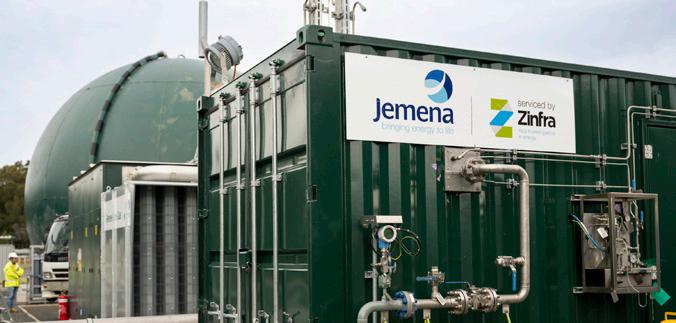
biomethane can be used in a very practical and tangible way.
“It’s been a great undertaking between the entire industry, including AGIG, TasGas, ATCO, the team at the Malabar site who had to get the biomethane to Melbourne. It was a real group effort. And as a result, biomethane that has come from the Malabar Biomethene Plant is being used in the MasterChef Kitchen. This means viewers at home can see that renewable gas is here, it’s ready and it looks and works just like natural gas,” Mr Gillespie said.
WHAT’S IN THE PIPELINE FOR JEMENA?
Gas shortfall is also a pressing issue for all utilities and their communities, and Victoria has been flagged as particularly high risk for shortages in the near future.
“Last month we announced the reversal of the Eastern Gas Pipeline, which could see up to 300TJ/d of gas being sent south from New South Wales into Victoria. Given forecast gas shortages in Victoria, this is an innovative solution designed to ensure customers in Victoria have access to natural gas during winter when they really need it,” Mr Gillespie said
“We will also be finalising our pricing and services plans for our electricity and gas distribution networks in Victoria and New South Wales respectively, before submitting the plans to the Australian Energy Regulator (AER) for review and endorsement.
“We’ve spent the best part of 18 months developing the plans in consultation with our customers across our electricity and gas networks. Their feedback has proven crucial in shaping things like how much we invest in new energy services, such as renewable
gas, as well as how we best navigate the transition while keeping energy affordable and reliable.”
On the electricity front, Mr Gillespie explains that Jemena is continuing to prepare its network for the future, noting that the way in which customers use the electricity grid is continuing to evolve.
“For our residential customers this means ensuring we’re prepared for things like an increase in rooftop solar installations and greater uptake of EVs. For our large customers this means working collaboratively to ensure we’re designing bespoke solutions that meet their needs,” Mr Gillespie said.
“As a case in point, we’re working with a number of data centres who can, in some instances, use as much electricity as a small town. Data centres are a crucial part of modern life and contain the physical infrastructure which make things like the internet, AI, cloud computing and a host of other applications possible.
“For these customers we are continuing to develop solutions that make available not only the large amount of energy they need, but do it in a way that ensures they can be confident it will be there when needed, and that the system is reliable.
“While it certainly is a challenging time for our sector, I’m really excited by the once in a lifetime opportunities the energy transition presents. The transition demands that we work collaboratively towards a shared goal for the benefit of current and future generations – something we can all be proud of,” Mr Gillespie said.
“I look forward to meeting new people over the year and reconnecting with long-standing colleagues and friends!”
UTILITY • MAY 2024 WWW.UTILITYMAGAZINE.COM.AU 27
INDUSTRY INSIGHTS
REVOLUTIONISING BIOCHAR PRODUCTION
WITH NEW PYROLYSIS TECHNOLOGY
South East Water’s Research and Development team works to identify emerging trends and technologies to help solve problems presented by wastewater management and treatment, particularly in relation to sustainability and the circular economy. In this interest, South East Water has partnered with engineers from RMIT University and Manipal University, India, to trial pyrolysis, a groundbreaking technology that revolutionises how the biosolids produced through wastewater treatment be reused and recycled.

Wastewater offers huge potential for renewable initiatives. With Australians producing over 300,000t of wastewater every year, there is no shortage of material to work with. Treated wastewater produces two materials: treated water and biosolids. Treated water is reused and recycled in a number of ways – but reusing biosolids is a more difficult task.
A pioneering technology, pyrolysis, opens up a whole new world of uses for biosolids by turning the material into biochar. Biochar is a solid carbonaceous material of organic feedstock, which contains stable and porous structures, and possesses desirable physicochemical and morphological attributes for many applications.
INTRODUCING PYROCO
RMIT University Professor and Group Leader for Innovative Resource and Waste Conversion Technologies, Kalpit Shah, has developed a specific pyrolysis technique, called PYROCO, which uses a process called fluidised bed pyrolysis. Fluidised bed pyrolysis heats biosolids to a high temperature (approximately 500–700°C), keeping the temperature stable to ensure high quality product. Fluidised bed pyrolysis can be used for sustainable and cost-effective upcycling of contaminated wastes, with a reactor used to convert biosolids to biochar.
Professor Shah explained that, “PYROCO is a first-of-itskind fluidised bed pyrolysis technology that can be used for
UTILITY • MAY 2024 WWW.UTILITYMAGAZINE.COM.AU 28 ACCELERATING ACTION
sustainable upcycling of waste into energy and high-value products. PYROCO is essentially a fluidised bed heat exchanger device that significantly improves heat and mass transfer in the process, resulting in huge savings in capital and operating costs as well as generating the highest quality biochar product.
“We believe that PYROCO can achieve the high throughput per unit cost compared to other technologies. Unlike other technologies such as auger or rotary kiln-based systems, PYROCO (a fluidised bed heat exchanger) is simply made up of tubes and pipes, which is far easier to fabricate and maintain. Also, unlike other technologies, PYROCO has minimal moving parts and, therefore should achieve the high plant availability. PYROCO’s innovative process design also offers flexibility to deal with feedstocks with varied quality, where other technologies will struggle,” Professor Shah said.
TRIALLING THE TECHNOLOGY
The fluidised bed pyrolysis technique is currently being trialled by South East Water, Intelligent Water Networks and Greater Western Water at the Melton Recycled Water Plant.
South East Water Research, Development and Innovation Manager, David Bergmann, said, “The key is in the absence of oxygen. You take whatever you started with, and you turn it largely into forms of carbon. And it turns out carbon actually has a lot of uses. If we can take that from a waste product that otherwise has no value, then that's a great outcome.”
The circularity concept is to keep valuable nutrients in biosolids – such as carbon, nitrogen and phosphorous for reuse in applications such as agriculture, construction, energy, batteries etc.
For South East Water, the potential benefits are significant. Mr Bergmann explained that, “The volume reduction for
us, distribution cost reduction, creating material of value, destruction of contaminants are the core benefits for us. We believe this technology is going to be able to make that conversion with lower carbon emissions, lower greenhouse gas emissions, than our traditional processes would. So it's going to help us achieve our greenhouse gas emissions targets as well.
“Further to that is carbon in its most basic form, so effectively, it's inert. It can no longer have any greenhouse gas emissions, so by then using it in agriculture or construction, we are locking it down. We're taking it out of that carbon emission cycle. And so that's a great thing for our climate targets that we're all trying to achieve,” Mr Bergmann said.
Mr Bergmann believes one of the key factors to increasing uptake of this technology in water utilities is changing the way we see wastewater treatment facilities.
“We really need to start seeing our water recycling plants, not as waste processing facilities but as manufacturing facilities. A facility that manufactures, yes, water, but also a quality sludge or biosolids product that we then convert into a quality carbon product. It's a manufacturing production plant that produces consistent materials for an end user that can put it into batteries, electronics and other high end applications.
“That's quite a shift in how we're running. When you're running a waste treatment plant, it's about focussing on volume throughput. When you run a factory for carbon, it needs to be an optimised operation focussed on tight end user specification and requirements, it's a mindset change, and you're thinking about producing good quality products at the end of the day. I think that's the shift that we need actually in the way we run our operations and our treatment plants.”

UTILITY • MAY 2024 WWW.UTILITYMAGAZINE.COM.AU 29 ACCELERATING ACTION
Working together FOR BETTER DRINKING WATER IN THE BUSH
The Goyder Institute for Water Research has released a comprehensive report outlining the outcomes of the national Working together for better drinking water in the bush forum, which brought together diverse participants from across Australia – from First Nations groups to utility companies – to discuss the issues restricting drinking water supply in remote regions. Here, we take a look at the 12 key action areas identified by the forum that are expected to support the development of better water quality for Australia’s remote communities.
The collaborative Working together for better drinking water in the bush forum, held in Mparntwe (Alice Springs) from 27–29 June 2023, highlighted the significance of working together to support safe and reliable access to drinking water for remote First Nations communities. A key aim of the forum was to prioritise First Nations voices to ensure that they are incorporated in decision making going forward.
The forum was delivered in partnership with the Federal Government through the Department of Climate Change, Energy, the Environment and Water (DCCEEW) and Desert Knowledge Australia (DKA), and brought together representatives from South Australia, the Northern Territory, Queensland and Western Australia – including First Nations community members, state and territory water utilities, state and territory policy makers, land councils, health regulators, and service providers, as well as national, state and territory, and local government agencies.
The forum gathered knowledge through workshops encouraging small group interactions of attendees merging different backgrounds, individual informal interviews, and one-on-one sharing. The goal was to capture the challenges currently halting progress and the enabling actions required to achieve resolutions and ultimately to determine key items which should be prioritised to address better drinking water in the bush.
Consensus was achieved on many challenges that need to be addressed, along with a list of 12 key focus items for action, which, if implemented in combination, could assist in delivering better water quality for the bush communities.
THE KEY FOCUS ITEMS
PRIORITISED:
• Resolution of social challenges such as trust and empowerment
• Engagement in truly integrated partnership
• Governance, including a focus on self-determination for sustainability and building respect
• Education to build skills and capacities of local communities
• Methods for information sharing to overcome perceived silos associated with multiple levels of government and challenges of remoteness from metropolitan centres
The outcomes of the forum were presented in a report for consideration as areas for immediate and future action. While leadership to address various responses for each key action item is suggested, all of the key focus items are cross-jurisdictional in nature, and a shared, multi-jurisdictional approach to these items will create opportunity for partnership, cost sharing, knowledge sharing and collaborative action.
THE
12 KEY ACTION AREAS
The report outlines 12 key items for action which were identified
by extracting and matching up themes that arose throughout the forum’s workshops.
Attendees were also asked to indicate whether they felt each of the 12 items were important and/or urgent. Attendees were almost unanimous in determining that each of the 12 key items were important and many of the items were seen as both important and urgent.
The areas for action are:
National principles on safe drinking water
Setting national principles on safe drinking water for remote communities including to prioritise drinking water and source protection, and incorporating cultural knowledge, Indigenous-led and localised community engagement.
Prioritising health
Addressing national health targets through better understanding of water quantity and quality issues.
Local First Nations water authority with First Nations voices
Creating a localised First Nations water authority which includes First Nations voices and provides expertise on water in remote communities.
Community education
Community education through a coordinated education program to empower the whole community to understand their own water supply
UTILITY • MAY 2024 WWW.UTILITYMAGAZINE.COM.AU 30
ACCELERATING ACTION
delivered through schools and community engagement processes.
Guidance on appropriate technology
An option list of water treatment systems that includes information about the systems’ suitability or reliability as an approach to de-risk the choice of technologies for communities.
Community water rangers
Indigenous-led program for local community water rangers that act as the connection between governing agencies, utilities and the community.
Joined up planning approach to water
Working together to integrate planning for water supply across all services such as health, housing and energy.
National standards for water security
National standards for water security infrastructure and levels of service including water quality, quantity and supply.
Data dashboard
A national data platform, with understandable, easily accessible, and up-to-date water quality information presented in culturally appropriate formats.
National commitment to action (national action plan)
A national commitment to ongoing action on water issues in remote communities and homelands incorporating all states and territories.
Community workforce
The building of a community workforce to support operation and maintenance of water infrastructure in the community.
Community of practice
A collective of water professionals, both industry and government, with input from water rangers, to share information and knowledge on a regular basis.
CHALLENGES PREVENTING IMPROVED WATER QUALITY
The forum also identified nine areas that presented major challenges to efforts to improve water quality, which were examined to determine solutions and to identify which of the key action areas might assist in resolving the challenges.
The challenge areas and their associated key actions are:
Truth-telling
The notion of ‘truth-telling’ as encompassing challenges around sharing of knowledge and information, specifically localised data, communication, transparency and developing trust and respect was strongly advocated by all attendees, in particular the First Nations community members.
Attendees of the forum said that currently there is no two-way sharing of information with the community.
“Communities can see the water is being sampled but they don’t get the results – but they could jointly solve the problems.”
One attendee said that all stakeholders need to be on the same
page regarding water knowledge and data.
“Communities would like to get information through meetings and a traffic light system online showing water quality and availability information.”
Governance
Areas of challenge for governance identified in the forum included responsibility, accountability, complexity, transparency and lack of consistency across jurisdictions.
Attendees agreed that there needs to be one body that takes responsibility for water quality and is the point of contact for communities.
“Long-term strategic planning is required – including support for programs rather than projects – and providing adequate time to complete, e.g. six to eight years rather than two to three years.”
Education, training and skills development for employment in communities
The challenges of employment, skills, education and training for water management were identified under headings concerning: the need for regular, ongoing employment of water resource management staff in remote areas, skills, and education and training.

Discussion was also had on the enabling opportunities for broader economic uplift of employing locals in the community.
The attendees identified four prioritised actions which would assist in resolving the challenges of education, training and employment by employing local community members.
31
ACCELERATING ACTION

Infrastructure
Challenges around the ongoing reliable provision of water infrastructure in remote communities, which require complex interactions between physical resources, institutions and endusers, often across governance and cultural boundaries.
The complexity of resolving infrastructure challenges was seen in attendees’ responses to key actions for prioritisation. Aspects of infrastructural challenge were identified as maintenance, ownership, replacement of assets, reliance on band-aid solutions, funding capital as well as operational expenditure and identifying appropriate technologies which were fit-for-purpose in the local environment.
Planning
Challenges in planning for safe drinking water covered lack of integration, lack of engagement, funding allocations and an emphasis on ‘short-term’ solutions.
Attendees found that, currently, there is a lack of integrated planning – especially long term planning – and
that climate tools and indigenous knowledge are major boons to the planning process that are currently not being taken advantage of.
“Planning needs to consider future needs and requirements of communities and should consider impacts of climate change,” one attendee said.
Social
Social challenges and solutions were identified by forum attendees under broad headings of health-determining, inequity, cultural, cost-benefits provided and prioritisation of liveability.
Due to the breadth and complexity of this area, no one key action stood out as being identified to resolve all these issues.
Uniqueness of place and people (different communities)
During the forum a range of challenges and solutions were identified, relating to the uniqueness of places and people across all states and territories of remote Australia.
These were categorised under four areas, the type of community (such as homeland, outstation, or remote community), the size of the population linked to the scale of solution required, the needs of specific communities, and the opportunities and aspirations of different communities.
Water quality
Challenges and solutions to water quality in First Nations communities are clearly of critical importance as safe and reliable water supplies will be integral to the achievement of many of the health targets in the National Agreement on Closing the Gap.
Issues raised by attendees were categorised under health, taste/ aesthetics, and source protection.
Water security
Forum participants identified challenges and solutions around water security which were categorised under four headings: volume of water; demand for water; competing users; and risks associated with climate change.
UTILITY • MAY 2024 WWW.UTILITYMAGAZINE.COM.AU 32
ACCELERATING ACTION

NATIONAL STANDARDS FOR INFRASTRUCTURE, LEVELS OF SERVICE AND TECHNOLOGIES
The majority of attendees identified national standards for water security in the bush as important. Incorporating both infrastructure needs and basic levels of service with expansion to ensure health-based targets are met, standards could be designed with codes incorporating guidance on installation of appropriate technologies for supply and demand management at each location, along with a joint approach to planning, ensuring that water supply, energy and housing are all considered in any existing or new development.
In this regard, attendees from utilities commented on the value of reinstating a revised community Water Planner. In 2021, the Productivity Commission recommended that subsidies may be required to ensure safe, reliable and affordable access to a ‘basic level of service’ for water supplies in high-cost locations.
While funding was not identified as a key action per se during the forum, a number of attendees commented on the need for any funding allocation to drive desired outcomes such as ensuring sustainability of solutions by factoring in long-term maintenance
plans in any operational costings and funding these alongside capital costs associated with any project.
Funds were also requested to achieve specific goals such as for bigger community-led programs and for long-term support for ‘champions’, selected by communities to drive forward a change agenda.
CONCLUSIONS
The report recognised that while the sample size of First Nations community members at the forum was small, it was clear that those present wanted to see national leadership on the development of principles to ensure source protection and prioritise safe drinking water for good health, which incorporate cultural knowledge and are driven by engagement and leadership from Indigenous peoples at the local level, ensuring ‘two-way in’ and ‘two-way out’ knowledge transfer.
Several major items were identified as worthy of prioritisation, with many creating significant synergies in combination. These items are:
The creation of national principles, standards, targets and an action plan which all prioritise the health of First Nations people living in communities, outstations and homelands.
Encouraging partnerships between different sectors such as health, water, energy, planning and development to plan collaboratively and to access data and information at the regional level, including relevant guidance on appropriate technology for local solutions in demand and supply. This would support an interest in transforming government organisations to do things differently, in alignment with the National Agreement on Closing the Gap and the Priority Reforms.
Finally, creating a First Nations water authority, building a data dashboard, and organising Communities of Practice, which would allow shared access to data and information and could create shared learnings for management of water supplies in a more climate challenged future. At the same time, creating relevant community education programs, using culturally relevant knowledge to generate localised workforce development including community water rangers, which would build the community-controlled sector, share decision making and allow governments to partner with First Nations communities to achieve better drinking water in the bush.
To read the full report, visit, goyderinstitute.org/project/working-together-for-better-drinking-water-in-the-bush/
ACCELERATING ACTION UTILITY • MAY 2024 WWW.UTILITYMAGAZINE.COM.AU 33
FACILITY UPGRADE TURNING WASTEWATER INTO A SUSTAINABLE RESOURCE
Western Australia’s largest water resource recovery facility (WRRF), Woodman Point, is undergoing an upgrade which is set to greatly increase the facility’s capacity and its sustainability. Here, we delve further into the upgrade and take a closer look at the pumps and equipment that support the WRRF.
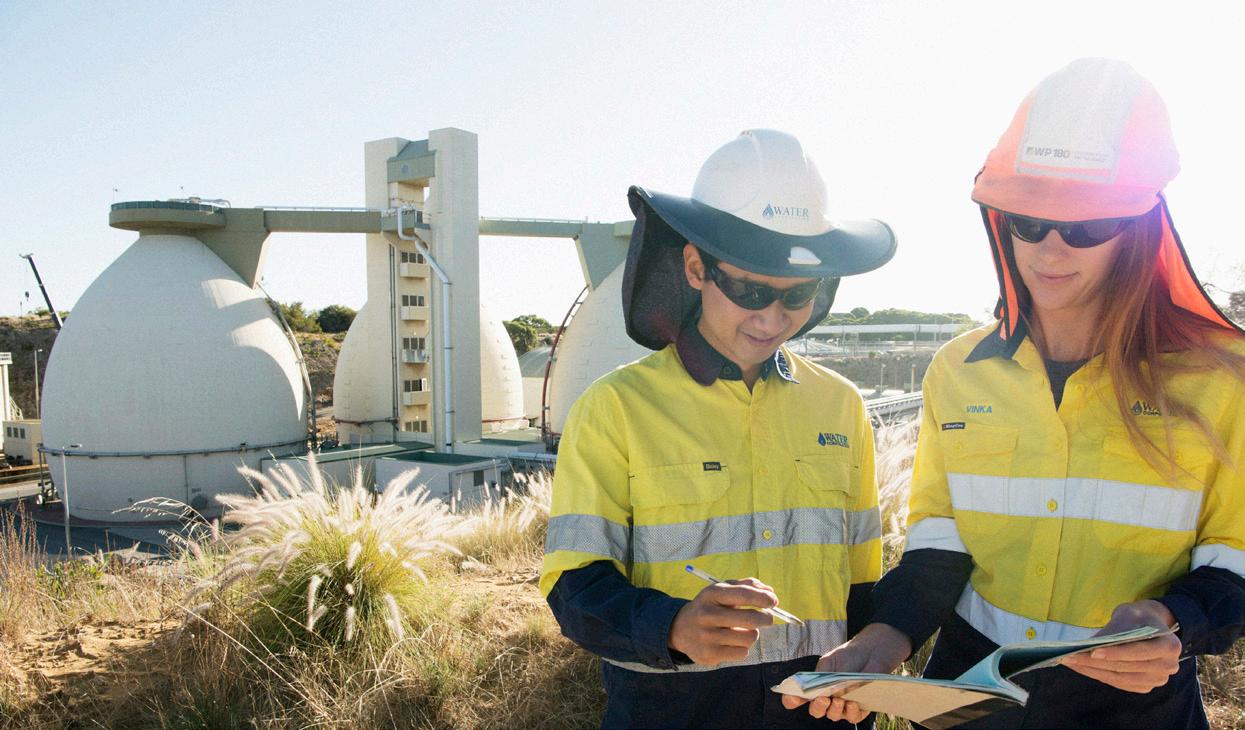
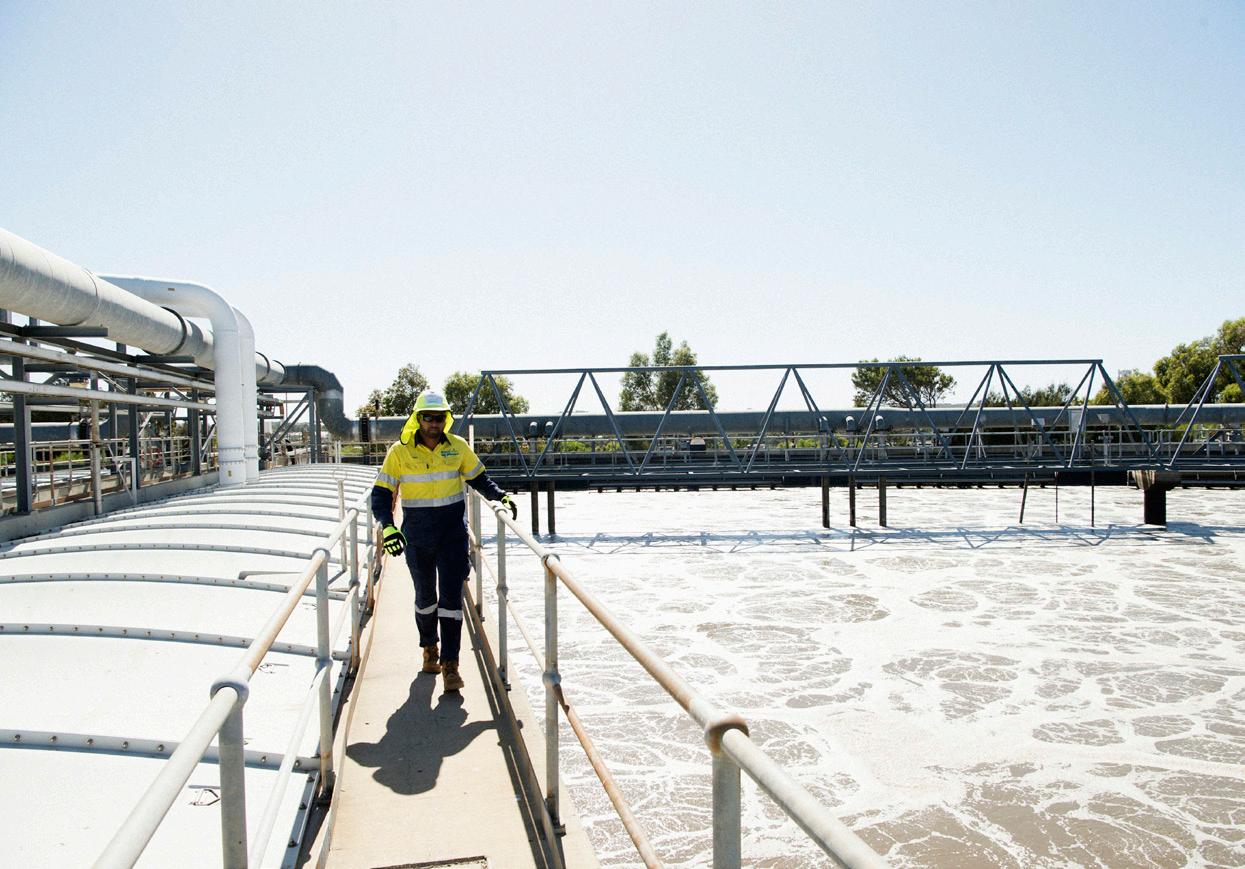
34
ACCELERATING ACTION
Water Corporation’s Woodman Point WRRF treats wastewater generated in Perth’s largest catchment area. In an effort to ensure the facility will continue to serve the area’s rising population in the years to come, works have already begun on a $238.5 million upgrade that will see the facility’s capabilities increase from its current 78t of dry solids per day (tDS/d) sludge treatment capacity.
Additionally, the upgrade seeks to enhance the facility’s sustainability credentials, with the addition of more onsite renewable energy generation.
PREPARING FOR THE FUTURE
According to Water Corporation’s General Manager — Assets Planning and Delivery, Evan Hambleton, sludge volumes were increased significantly by converting the facility from a batch treatment process to a continuous stream treatment process through an 180ML/d upgrade that occurred in 2019.
“To maintain the existing quality of treated wastewater and to cater for future growth within the catchment area, upgrades are required to ensure sludge treatment continues to meet biosolids classification standards for beneficial reuse,” Mr Hambleton said.
“This project will increase the existing solids load capacity of 78tDS/d to 120 tDS/d, which will provide capacity until 2040 and match the capacity of the liquid stream of 180ML/d.”
Work on this latest upgrade kicked off in mid-January 2024 and Mr Hambleton said that the design is 50 per cent complete and procurement is 35 per cent complete.
“Construction work to date includes bulk earthworks and service relocation. Preliminary work on the Dissolved Air Floatation Thickeners (DAFT) has also commenced.”
HOW DOES THE FACILITY WORK?
Mr Hambleton explained that wastewater is pumped into Woodman Point WRRF from Munster Terminal Pump Station.
“Wastewater from the catchment collects at this station and pumps to the ‘head of the works’. The wastewater stream is generally a gravity process through screens and various stages of settlement and aeration.
“The new upgrade consists of two streams of treatment for the solids stream, the Primary Sludge Stream, and the Excess Activated Sludge (EAS) stream.
“Pumps on the Primary Sludge Stream are generally of the Progressive Cavity/Helical Rotor design. These provide a measured consistent flow. The gentle nature of the pumping method ensures more efficient sludge thickening and dewatering.”
Mr Hambleton said that pumps on the EAS stream are usually dry mounted immersible pumps or end suction centrifugal pumps up to the DAFTs.
“Up to this point, the stream has a low solids content and behaves in a similar fashion to water – beyond the DAFT pumps is similar to the primary stream and will be progressive cavity pumps.
“Pumps on the EAS stream will be pumping sludge up to 16.5 per cent dry solids content. This presents some challenges, requiring methods to reduce friction losses
in-line, including the use of injection rings to create a boundary layer along the pipe wall of either reclaimed wastewater, or polymer and injection of air pockets into the line to break the sludge cake into plugs along the transfer line.
“The heart of the new process is a Thermal Hydrolysis Plant (THP) on the EAS stream which processes sludge at high temperatures, providing the added benefit of a better rheology for pumping (a thicker hydrolysed sludge behaves like a thinner conventional sludge) and boosts residence time in the downstream digesters.
“The remainder of the process is conventional thickening and dewatering technology commonly used in the water industry (DAFT, Inclined Screw Thickening and Centrifuge Dewatering).”
EXPECTED OUTCOMES OF THE UPGRADE
Water Corporation said that the project will support the organisation's target of achieving net zero emissions by 2035. The upgrade is expected to do this by:
• Increasing the Woodman Point WRRF’s ability to treat organic matter by 54 per cent, allowing Water Corporation to produce higher quality biosolids in a more efficient way
• Allowing the continued recovery of solid waste which supports Water Corporation’s state-wide target of 74 per cent solid waste recovered for reuse, as stated in its Waste Recovery Strategy
• Allowing nearly 50 per cent of the facility’s energy requirements to be produced onsite through the capture and reuse of biogas
• Reducing greenhouse gas emissions by around 5,600t CO2-e annually as less grid power will be needed to run the plant
• Contributing to a reduction in greenhouse gases by decreasing flaring, which will see the plant go from 54 per cent flaring to only flaring in emergency circumstances
“Now seen as a source of valuable resources, wastewater is treated and recycled as a fit-for-purpose resource to alleviate pressure on valuable scheme water supplies. This project will ensure we continue to maintain water supply to the Kwinana Water Recycling Plant which provides 16ML/d of high-quality recycled water to customers within the Kwinana Industrial Precinct,” Mr Hambleton said.
“This is especially important in Western Australia where the impacts of the climate are placing increasing pressure on drinking water supplies.
“In 2002–23, Water Corporation recycled 20 per cent of all wastewater treated across Western Australia. Water Corporation aims to recycle up to 35 per cent of all wastewater in the metropolitan area by 2035.”
Mr Hambleton said that this project demonstrates how a growth mindset and whole-of-business support can lead to positive outcomes in recycling a waste product into multiple sustainable resources and deliver a world-class Resource Recovery Facility to create a positive legacy for the broader community.
“This project is setting a new benchmark in the recovery of sustainable resources from wastewater.”
UTILITY • MAY 2024 WWW.UTILITYMAGAZINE.COM.AU
35 ACCELERATING ACTION
Circularity in water –
PEOPLE ARE YOUR GREATEST ASSET
By Donna Shiel, Senior Circular Economy Consultant, and Caroline Turnbull, Environmental Engineer, Tonkin + Taylor


The water sector in Australia is well-positioned to become a leader in the transition to a circular economy. Here, we explore steps utilities can take to embed circular economy principles within their organisations through enabling their people.
As stewards of regional water cycles, water utilities have been embracing many circular practices as business-as-usual for many years, evidenced by their dedication of resources to water recycling and through the recovery and beneficial reuse of biosolids. What is sometimes overlooked, however, is water utilities’ role as constructors and managers of operational assets.
This role is now increasing in importance as infrastructure installed in the post-World War II boom is reaching end-of-life. This presents a significant opportunity to invest in long-life, high-cost upgrades in the near-term, and which can have a substantial impact.
Water utilities can position themselves to recognise this opportunity by finding ways to:
• Repurpose or sell end-of-life equipment– including via internal refurbishment programs
• Adopt a circular mindset in navigating the transition to digital water meters, including evaluating the lifecycle impacts of procurement of the millions of required meters
• Plan now for the end-of-life of equipment, for example redundant meters
• Implement a Sustainable Design Framework and assess lifecycle costs and benefits (social, financial, and environmental) during asset management planning and procurement
Challenges commonly encountered by water utilities looking to implement such initiatives include funding the necessary initial investments, managing changes to operational processes, and implementing the cultural transformations required to integrate lifecycle thinking. Overcoming these obstacles generally involves developing a clear strategy, obtaining buy-in from all levels of the company, investing in necessary infrastructure and providing ongoing training and education.
LEARNINGS SO FAR
Tonkin + Taylor's learnings from recent work with water utilities on planning for circularity has identified the following:
1. Upskilling your staff to understand the principles of the circular economy is critical. This will help them identify where their ideas or work they are already doing reflects a circular approach. Great ideas are there, but are clouded by views such as “but often hampered by the view that "it's not technically circular." Often, however, it is! Upskilling will help them identify where their ideas or work they are already doing reflects a circular approach, even if it doesn't fall under traditional labels like "reduce scope 3 emissions" or "material use efficiency." Be prepared to translate the concept of circularity into the language relevant to each team (e.g., lifecycle impacts, waste reduction, sustainable procurement, smart engineering).
2. Empowering staff to adopt lifecycle thinking is key to the transition to a circular economy. This requires procurement and construction to consider not just the operational phase, but also the environmental impacts of manufacturing and end-of-life stages. Empowerment can take various forms, including training, access to relevant tools, and even internal or external technical support to assist with research and analysis – a crucial aid for busy staff.
3. To support a smooth transition, business systems and policies need to evolve alongside day-to-day processes. These processes should integrate circular economy principles. By updating the tools and operating procedures employees interact with daily, we can reflect this transition. Similarly, if initiatives require capital the organisation will need a transparent means of collecting, evaluating and prioritising capital investment for circular projects.
Engaging with and empowering your greatest assets – your people – brings benefits: cost savings, enhanced resource efficiency, improved resilience, increased employee satisfaction, and suitability for long-term sustainability.
In other words, investing in your people as part of the circular economy transition for your organisation is simply a smart investment in your business.
UTILITY • MAY 2024 WWW.UTILITYMAGAZINE.COM.AU 36
For more information about Tonkin + Taylor’s circular economy capabilities visit www.tonkintaylor.com.au
ACCELERATING ACTION | Sponsored editorial



challenges into sustainable solutions Find out more at... www.tonkintaylor.com.au
a specialist provider of engineering and environmental services, Tonkin + Taylor brings your project ambitions to life. We unlock the potential of your land with innovative solutions for renewable energy, commercial developments, and more. Our expertise covers everything from geotechnical assessments to aftercare management, ensuring sustainable outcomes for communities and the environment. Together we create and sustain a better world.
Complex
As
MAKING SURE EVERY HEAT PUMP HOT WATER SYSTEM IS SAFE
By Stan Krpan PSM, Chief Executive Officer, Solar Victoria
Phasing out gas in favour of electric domestic hot water systems is an essential step in Australia’s pathway to net zero. Not only do electric water heating technologies offer greater efficiency , they also provide significant demand flexibility to better suit renewable generation. However, as this industry grows, it’s important that safety and quality standards for systems and installations are maintained.

Across Victoria, tens of thousands of households are swapping out gas and saving on their energy bills by installing heat pump hot water systems. Every week, more than 700 Victorians apply for Solar Victoria’s $1,000 hot water rebate, which helps cover the upfront cost of installation. In March 2024, we celebrated reaching the milestone of 20,000 hot water systems installed through our Solar Homes Program.
We are excited by the uptake and interest in hot water systems across the state, not only for the benefits for consumers, but also for our growing clean energy industry. As more and more installers and retailers join the clean energy transition, I am mindful that we need to ensure that the heat pump industry is growing safely, and that system and install quality does not suffer as a result of the industry’s fast-paced growth.
PRIORITISING SAFETY
Since our inception in 2018, Solar Victoria has prioritised safety, making accreditation of installers a mandatory requirement. Installer accreditation has been a critical contributor to the success of our programs in setting standards and continuously lifting them.
As part of our commitment to safety and quality, we audit five per cent of all Solar Homes Program installations every
year. While very few hot water installations audited over the last 12 months were found to be unsafe, there are still persistent issues being detected.
Common issues identified relate to inadequate installations, which can ultimately impact the effectiveness or safe functioning of the system. Compliance issues identified in audits include:
• Inadequate insulation to protect systems from freezing
• Switchboard wiring
• Unsafe termination points for pressure relief valves
• Inappropriately secured water tanks
Confidence in heat pumps as a newer technology and in this growing industry will require a collective effort to ensure safety, quality and standards are maintained. We have been working with retailers and providers to better understand the compliance issues and risks associated with heat pumps.
IMPROVING COMPLIANCE THROUGH COLLABORATION
We have joined forces with our fellow Victorian regulators and agencies to improve compliance of heat pump hot water systems installations across the state.
Over the past few months, Solar Victoria has been working with Essential Services Commission, the Victorian Building
UTILITY • MAY 2024 WWW.UTILITYMAGAZINE.COM.AU 38
DEMAND MANAGEMENT

Authority, Energy Safe Victoria and WorkSafe Victoria on a Heat Pump Hot Water Systems Compliance Plan.
With the respective regulators, we will have joint inspections and compliance activities to ensure heat pump hot water systems are being installed safely and without fault. We will continue to share information to ensure compliance and higher standards in the growing heat pump market.
An important aspect of this plan is engaging with our providers, installers and the broader industry to work collaboratively on raising compliance. We will provide updated resources to support compliance and continue to provide training to ensure demands can be met safely.
The Victorian Government provides a wide range of support to installers and retailers to assist in maintaining safety standards, to help customers identify reputable, government-approved suppliers. We will continue working with industry groups and representatives on education, guidance and standards.
As we move closer to Victoria being net zero, we need to ensure that all heat pump hot water systems are installed in line with industry and safety standards. This is critical as we continue to support Victorian households to effectively electrify their homes and reduce their emissions.
Collectively we can make efforts to continuously raise the bar in the interests of our community.

UTILITY • MAY 2024 WWW.UTILITYMAGAZINE.COM.AU 39
DEMAND MANAGEMENT
PARTICIPANTS, NOT RECIPIENTS: consumers hold the key to renewableAustralia’s power
Energy Networks Australia’s Energy Network Conference and Exhibition is a biannual event that brings together leading experts, members and stakeholders from within the energy industry. Held in Adelaide in late March, this year’s conference discussed the transformation of the energy grid to provide services and value that the consumers of the 21st century demand. One of the conference’s keynote speakers was Laura Sandys, Chair of the UK Government’s Energy Data and Digitalisation Taskforces and a renowned expert in energy and sustainability.
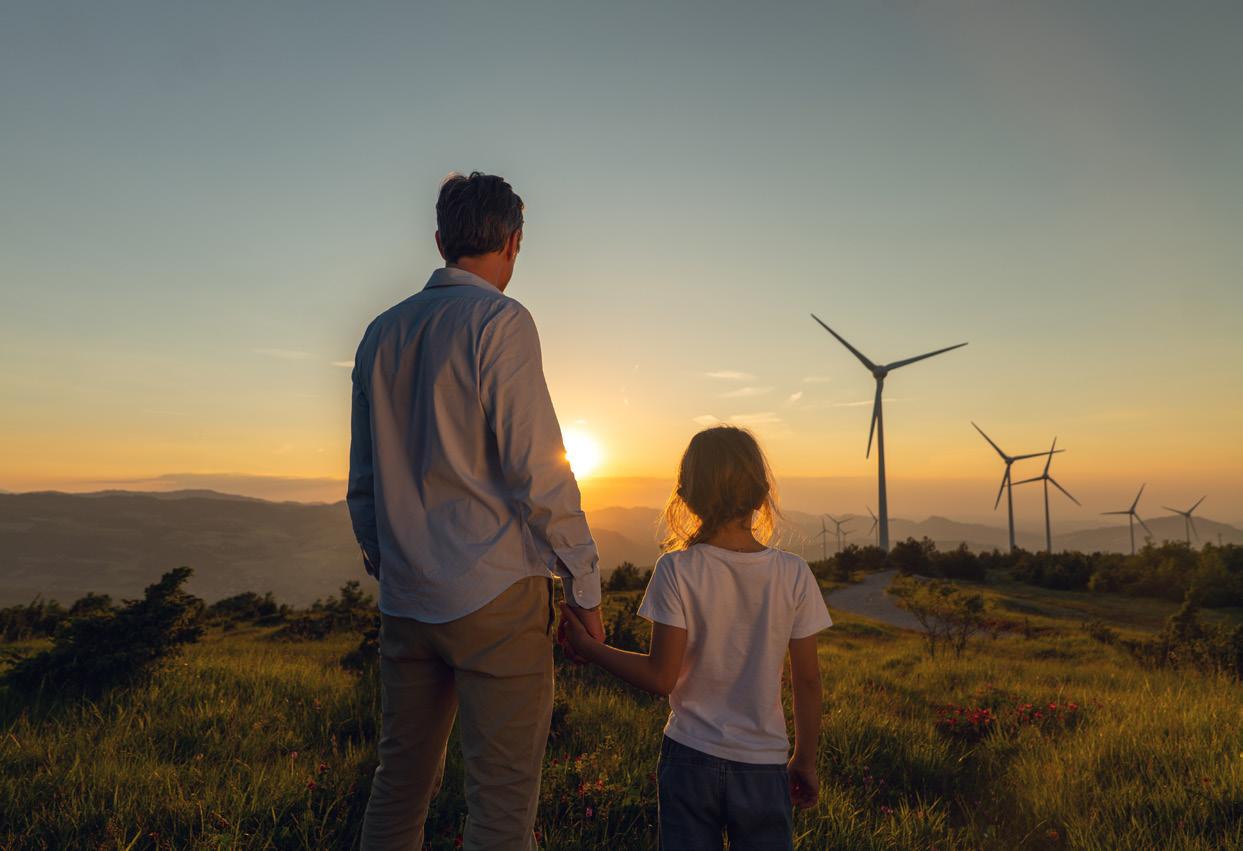
UTILITY • MAY 2024 WWW.UTILITYMAGAZINE.COM.AU 40
DEMAND MANAGEMENT
Ms Sandys’ illustrious career has led her to become a celebrated figure within the energy industry for her influential role in shaping sustainability and energy policy. As well as her work with the UK Government, Ms Sandys is the Chair of the Green Alliance and has served as a non-executive director at SSE Transmission, Highview Power and more.
Her keynote address at the conference, From brawn to brains: planning from the future, looked at redesigning the energy system with a focus on customer engagement. The energy system is changing from a top-down model to something much more complex, demand-led and digitalised, with new assets and actors that will drive change and networks at its heart. Ms Sandys believes that Australia has an opportunity to take the lead in this new world of energy – but action must be taken if this position is to be realised.
TRANSFORMATION OVER TRANSITION
“I'm going to give you a little perspective about how one might want to look at the energy transformation. I prefer the word transformation to transition. And I talk about planning from the future. You guys in the networks world are absolutely crucial to this transformation. But you're also in the world of quite long-term
investments, of long-term strategies. In many ways, I would urge you to be less incremental and much more transformational in all your thinking.
“We have, in many ways, the old system, the politicians, the regulation… some of the industry sits in the middle, trying to manage, and in some ways, its mindset is sat in the past, but knowing that the future is almost here. I would say to South Australia, and other parts of Australia, tomorrow happens very, very quickly. It is a hockey stick, and it starts to emerge before you even see it. And you guys in the networks world, you're going to have to manage it. You've been below the surface. Nobody's really heard about you, but they're starting to. Politicians are starting to take notice. Customers want connections. There's a whole dynamic here which is putting you really in the spotlight,” Ms Sandys said in the opening of her keynote address.
A key point in Ms Sandys’ speech was the polarity between traditional ways of managing energy and what is needed for modern network transformation. Looking at Australia, the UK and other parts of the world, Ms Sandys dissected the current energy climate and shed light on the shortfalls of current systems, particularly in relation to consumers.
Ms Sandys referred to a quote from Octopus Energy Managing Director, Ari Sargent, who said, “Designed and
built by engineers, bastardised by economists and marketers, the power industry continues to deliver one of the most successful consumer confusion programmes of all time.”
“Now, let's try and rid ourselves of this confusion as we go forward. Everything is location-based. Thinking about Western Australia in comparison to what's going on in Melbourne –there are particular, tailored, answers. No silver bullet is going to deliver you the one set answer. It is all about blending and system design.
“This is the new world of the consumer, the customer. And in particular, think about commercial and industrial consumers as well. Look at our regulator – moving from a very linear, a vanilla system design, to having to manage all these different moving parts. This is a very, very big culture change. And in the UK, we are moving from 400 people in the energy sector. I know there are 1,200 here today. This is a much bigger cohort. 400 people run the energy sector in the UK today. They all know each other's golf handicap. What a surprise. And we are moving to 100 million actions and assets.
“If you think that every EV car can do three things, this is a massive change in complexity, in interrelationship, in segmentation. And customers are going to want to be serviced across this complexity,” Ms Sandys explained.

UTILITY • MAY 2024 WWW.UTILITYMAGAZINE.COM.AU 41
DEMAND MANAGEMENT
DEMAND MANAGEMENT
ENCOURAGING CONSUMER PARTICIPATION
Ms Sandys spoke to the challenges of trying to squeeze a new energy system designed around renewables into a paradigm designed for fossil fuels. Noting the difference between a system designed for commodities and a system designed for capital assets, Ms Sandys said energy customers need to stop being seen as simply a meter point.
“Blending assets is the future. You've got to start blending your electrons with long duration storage with batteries. You’ve got to start to deliver solutions, rather than commodities. In the UK, we’ve got massive problems with balancing rocketing. Distributed assets are undervalued in the sense of the whole system value. Demand is where the action is going to be in a renewable, weather-based system.”
Ms Sandys identified key drivers of change in the industry, including system gaps, new market players, new business models and processes, and new people and skills.
“When we look at the optimization of the energy sector, we need to understand that we need different vectors, different timescales and different technologies. There isn't one solution. There's lots of them, and they need to be blended. Efficiency in the system is also important. The new market player, customers, demand is equal to supply. The physics tells us in electricity that that's the case, markets tell us, but certainly in the UK, and I'm sure in Australia, customers have
been more or less ignored. They are not an important part of the system, they are recipients. They're now going to be participants.
“We are still obsessed with the levelised cost of electricity. And when one starts to look at that, it really isn't reflective of this capital-based asset system that we're moving to. Every time you put a demand option on the system, you reduce costs for everybody, not just for those people with those assets. And there are models for optimization. We think we're going through this extraordinary transformation as if it has never been done before. If we look beyond energy, we start to see that it has been done before,” Ms Sandys said.
NETWORK INTERDEPENDENCE
Ms Sandys used electric vehicles (EVs) as an example of how energy consumers have become active participants in energy networks. She spoke of the need to adapt with these renewable technologies and to integrate them into the network, rather than seeing them as a threat to the system – because they’re only going to increase.
“In the UK, by 2035, the number of EVs on the system will be the equivalent of three nuclear power stations. So either those EVs could be a parasite on the system and we will have to build three nuclear power stations, or we have to integrate them into the energy sector and they become an asset. These are choices we've got to start making today.
And like you've seen in South Australia, in terms of solar PV, you're not going to stop these customers buying this stuff. You cannot tell people that they can't have an EV car.
“I love the ideas that you're doing in Western Australia, where you're creating micro grids, independence and interdependence. Those are quite important balancing acts that are going to be really exciting. Are we rewarding customers appropriately? Customers are not getting that value of the displaced reinforcement, they're not getting the value of the reduced curtailment costs. They are just getting a wholesale value. And that's not going to be good enough if we really want to encourage them.
“And this is the potential – if one starts to think from the demand side, from the customer side, this could be a domestic customer, an industrial customer, you've got a whole range of different options. We need business models, we need retailers who actually understand how to unlock that and work with you as networks to build those propositions. It will optimise the system, but importantly, it will give you a social licence to spend money, because customers have actually become part of the system and are benefiting from it,” Ms Sandys said.
It’s clear that consumers will be an important part of transforming Australia’s energy sector, and have lots to offer energy networks and companies. Encouraging network interdependence strengthens energy for all, whilst balancing costs and achieving renewable energy targets.
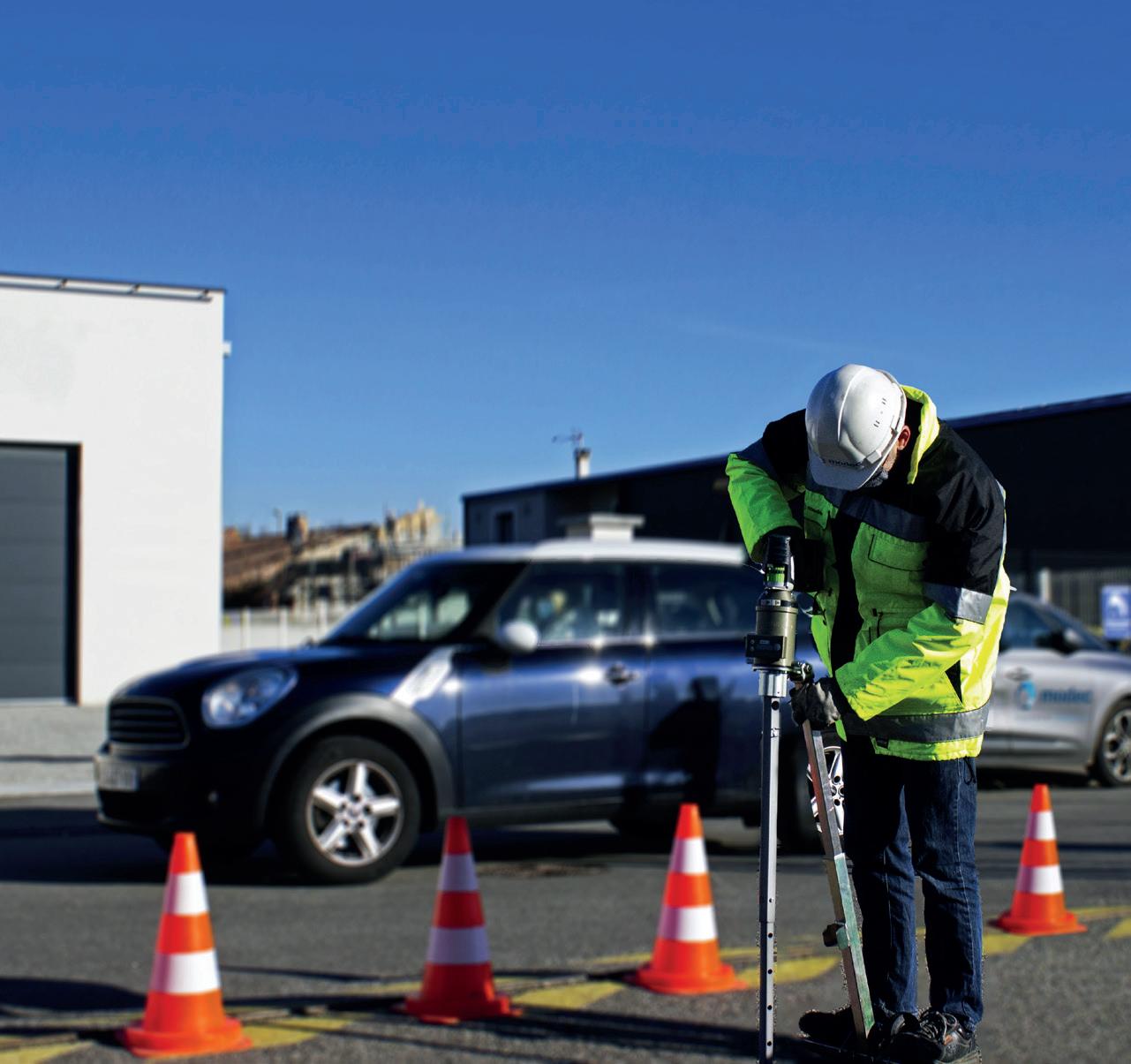

42




43 Easy transportation Simple implementation Operator and equipment safety 1300 FMT FMT (368 368) Melbourne 1/53-57 Rimfire Drive Hallam VIC 3803 Brisbane 2/5 Percy Drive Brendale QLD 4500 Perth 3/48 Hardey Road Belmont WA 6104 The water supply operator’s kit H2O WATER KIT
AEMO GSOO: preventing gas shortfall
Gas will continue to play an important role in Australia’s journey to net zero – but how will gas supply and consumption change in the transition to clean energy?
With the expected dependency and demand for gas in Australia’s energy transition, it’s important to understand and acknowledge the potential shortfalls of an energy source that remains essential yet may eventually be phased out.
Every year, the Australian Energy Market Operator (AEMO) releases its Gas Statement of Opportunities (GSOO) report, which uses information from gas industry participants to forecast whether gas supplies in central and eastern Australia will sufficiently meet the changing energy needs of households and businesses between now and 2043.
The 2024 GSOO was released in March 2024 and continues to predict shortfall risks on extreme peak demand days from 2025, with the potential for small seasonal supply gaps from 2026, expected to be experienced primarily in southern Australia.
DOWNWARD TREND IN GAS CONSUMPTION
The latest instalment of the report notes that gas consumption has declined significantly across all sectors since the publication of 2023’s GSOO, with emerging indications of fuel-switching from gas to electricity. This has coincided with noticeably higher retail gas prices than previous years, in addition to record-breaking warm winter temperatures.

Gas consumption for commercial, residential and industrial users is forecast to decline over the outlook period to 2043, however, southern gas production is expected to decline at a much faster rate of an almost 40 per cent decrease over the next five years, driven by the rapidly depleting gas fields in Victoria’s Gippsland region.
44
DEMAND MANAGEMENT
The GSOO contends that the projected gap in supply and demand highlights the urgent need for new investment to ensure that gas supply from 2028 can keep pace with demand from homes and businesses, and for gas-powered energy generation.
INADEQUACY RISKS
A critical undertaking of the report was assessing the risks associated with gas inadequacies over the short, medium and long term, and there were five risks of particular concern identified.
1. Shortfall during peak demand
From 2025, the risks of shortfalls on certain days in winter are forecast under extreme peak demand conditions in southern Australia, if extreme weather conditions drive high demand for heating, coincident with high demand for gas-powered electricity generation (GPG). The report posits that deep and shallow gas storages remain vital to peak demands being met whilst simultaneously providing seasonal flexibility. The ongoing availability of stored gas ahead of winter conditions continues to be important to mitigate adequacy risks.
2. Meeting domestic requirements
Producers in Northern Australia will need to deliver anticipated supplies and from 2026, the GSOO maintains that investment in supply that is currently uncertain will be required to ensure domestic requirements and export positions are met.
3. Seasonal supply gaps
The report predicts that there is the potential for small seasonal supply gaps in winter in southern Australia in both 2026 and 2027 under sustained high gas usage conditions.
4. Annual supply gaps
The forecast annual supply gaps are expected to increase in magnitude from 2028 as southern production declines. This will result in the development of a more structural need for anticipated and currently uncertain new supply, despite the decline in residential, commercial and industrial gas consumption across the nation.
5. GPG through the retirement of coal generators
The forecast level of GPG is expected to increase from
the mid-2030s as coal generators continue to retire through Australia’s energy transition – as outlined in the Draft 2024 Integrated System Plan (ISP).
The GSOO recommends further consideration of these forecasts, along with market and policy settings to ensure demand is able to be met.
SOLUTIONS CONSIDERED BY INDUSTRY
The GSOO outlines various solutions that are being considered by industry to address gas inadequacy risks over the coming years and suggests that a portfolio of solutions will most likely be required, including:
• Upgrades to and the expansion of existing pipelines that may delay annual gaps to 2029, but will require additional solutions to increase supply and provide peak day flexibility.
• Uncertain 2C southern supply and renewable gas projects that may delay annual supply gaps to 2033 and help mitigate peak day shortfall risks.
• LNG terminal(s) which may require associated pipeline infrastructure depending on the terminal may delay supply gaps until 2033 and help mitigate peak day shortfall risks, depending on the availability of LNG cargoes.

• Increased storage to cater for peak seasonal loads is likely a good complement to all other developments. Demand response mechanisms may also mitigate peak supply shortfall risks.
SUPPLY CHALLENGES
As demand changes, the GSOO summarises three key supply challenges and potential solutions.
Annual supply gaps
To address annual supply gaps and provide sufficient volumes of gas both domestically and for export, new supply must be developed.
Options for southern supply include LNG import terminals, increased southern supply, infrastructure to transport gas produced in northern regions, or renewable gas projects.
Northern supply options include expansions or new supply from fields in the Surat and Bowen basins, or from new basins such as the Beetaloo sub-basin, the South Galilee or North Bowen basins, or from renewable gas projects.
45
DEMAND MANAGEMENT

Seasonal supply gaps
New flexible capacity to support increased southern winter demand for heating and GPG are required to address seasonal supply gaps. Options to address this includes:
• New deep storage(s) in the south
• Upgrades to existing southern storage(s)
• Import termina(s) operated during winter months
• Increased north to south pipeline capacity
Daily or multi-day peak day shortfalls
The GSOO notes that daily peaks in demand, which is most prominent in southern regions, will require increased injection capacity.
Supply to southern customers may be improved with the provision of a new southern supply and/or increased capacity in the north to south pipeline capacity. An effective pipeline solution would require progressively higher northern supply.
Depending on the capacity for injection from either solution and the magnitude of gas demand peaks, southern storages may still be required to adequately resolve peak day shortfall risks. Thus, options include:
• New or expanded existing storage(s), including shallow and deep facilities
• Onsite storage at gas generators to reduce withdrawal rates from the gas system at peak times
• Pipeline augmentations, including reversals of existing infrastructure to increase flexibility of transportation
• Import terminal(s) to provide both additional supply and injection capacity
• Demand-side management mechanisms to reduce peak day demand
POTENTIAL SUPPLY, STORAGE AND TRANSPORTATION PROJECTS
The 2024 GSOO also outlines a number of uncertain projects that may have an impact on the risks of gas inadequacy identified across the GSOO horizon, including supply, storage and transportation options.
Northern supply
The most substantial reserves and resources are found in the northern regions. New northern supply from projects currently classified as uncertain would be required in all options assessed by AEMO, and may include expansions within existing basins, or developments in new basins.
The level of regional infrastructure investment required would depend on the proximity of the developments to existing processing and transportation infrastructure. The capacity to bring this gas south would also become more constrained by the capacity available along existing pipeline corridors.
North to south pipeline capacity
Increased north to south pipeline capacity provides southern demand centres with improved access to northern gas production, including existing, committed, anticipated and as yet undeveloped uncertain production.
Additional pipeline capacity would provide improved capability to transport gas south throughout the year and may be complemented by reversals to the Port Campbell to Adelaide and Eastern Gas Pipelines, to provide increased peak day transportation capacity to the major load centre of Victoria.
UTILITY • MAY 2024 WWW.UTILITYMAGAZINE.COM.AU 46
DEMAND MANAGEMENT
Southern supply and renewable gas opportunities
The 2024 GSOO includes current and future supply from a small number of existing or committed renewable gas projects and opportunities for renewable gas are likely to rise in future, which may stimulate more identified resources.
State governments have developed hydrogen strategies and plans that are designed to develop the industry and encourage further investment in commercialisation.
LNG
import terminals
LNG import terminal projects are at various stages of development close to southern demand centres. LNG import terminals would provide significant peak day injection capability and could be operated seasonally during winter months when supply would be more available due to the northern hemisphere summer. During summer months when there is less demand for imported LNG, floating storage
and regasification units (FSRU) could either continue to supply domestic consumers or be relocated to service alternative worldwide locations.
Import terminals would rely on existing or new pipeline infrastructure to enable delivery of supply and injection capacity to domestic consumers, which would vary for each proposed development.
Storage
Gas storage capacity requirements are uncertain in the longer term, but AEMO’s 2024 Draft ISP forecasts that GPG will complement renewable generation sources and electricity storages to support electricity consumers during peak demand periods and when renewable resources are less available. This may lead to potentially significant peaks in gas demand, which may increase the need for some form of additional gas storage capacity.
Pipelines (via linepack) and LNG import terminals (via the FSRU)
provide storage capacity that can improve operational flexibility but do not represent a firm storage solution comparable to dedicated deep or shallow storage solutions (including onsite storage options at gas generators).
CONCLUSION
Gas consumption is a necessary part of the energy transition, especially where it is used for electricity generation.
Although the scale of gas consumption throughout the energy transition remains unknown –particularly when it comes to gas usage for electricity generation – there are supply challenges and a significant risk of gas inadequacy across the GSOO horizon.
The GSOO contends that all scenarios investigated highlight the urgent need for new investments in gas to maintain a sufficient supply now and into the future as gas supports Australia through its stride towards net zero.
To read the full GSOO report, visit aemo.com.au/energy-systems/gas/gas-forecasting-and-planning/gas-statement-of-opportunities-gsoo

47
DEMAND MANAGEMENT
PROJECT ENERGYCONNECT:
SUCCESSFULLY DELIVERING ELECTRANET’S
LARGEST TRANSMISSION PROJECT
Construction of the South Australian component of Project EnergyConnect, the new high-voltage transmission line between South Australia and New South Wales, has been completed.

UTILITY • MAY 2024 WWW.UTILITYMAGAZINE.COM.AU 48
DEMAND MANAGEMENT
Project EnergyConnect is the largest transmission project ever delivered by ElectraNet. The South Australian component of the new transmission line covers 206km from Robertstown to the South Australia/New South Wales state border and includes South Australia’s first 330kV substation at Bundey.
ENABLING A CLEAN ENERGY TRANSITION
ElectraNet CEO, Simon Emms, said Project EnergyConnect is a transformational project for South Australia and the National Electricity Market.
Project EnergyConnect is the latest in a series of major network projects delivered by ElectraNet in the past five years, essential to enabling South Australia’s clean energy transition and net zero goals. “The interconnector strengthens South Australia’s position as a leader in the transition to a low-carbon economy and enhances our ability to export our abundance of renewable energy resources,” Mr Emms said.
“As well as unlocking renewable energy developments, it strengthens South Australia’s power grid, and will deliver price savings for customers. Once in full operation the new interconnector is expected to deliver bill savings of $127 for a typical South Australian residential power customer and between $6,000 and $18,000 for business customers.
“Project EnergyConnect is already contributing to South Australia’s clean energy future through new renewable energy developments in excess of 2GW, including wind, solar and batteries that are now proposing to connect to the grid.”
The new interconnector will have a capacity of 800MW, which is the equivalent of delivering energy to 240,000 extra households. South Australian Minister for Energy and Mining, Tom Koutsantonis said, “I congratulate ElectraNet for completing the South Australian side of Project EnergyConnect.”
The South Australian Government now looks forward to final investment decisions being made by the many renewable energy companies, which intend to use this link to the New South Wales market.
“South Australia has plenty of sun and wind resources which can be harnessed as energy for sale to NSW.
“An alternative to South Australia’s transmission connection with Victoria should reduce reliability risk and price impacts that might occur if the Victorian line has operational issues,” Mr Koutsantonis said.
Neoen Australia’s CEO, Louis de Sambucy, said the new interconnector was a significant factor in their South Australian investment.
“South Australia is already a world leader in the renewable energy transition, and Project EnergyConnect will play a crucial role in enabling the state to reach its goal of net 100 per cent renewables,” Mr de Sambucy said.
“Neoen currently has over 1GW of wind generation and battery storage in South Australia in operation or under construction. As a long-term owner-operator, South Australia’s ongoing energy policy leadership and our deep partnership with ElectraNet have been major factors in our continued investments here.

UTILITY • MAY 2024 WWW.UTILITYMAGAZINE.COM.AU 49
DEMAND MANAGEMENT

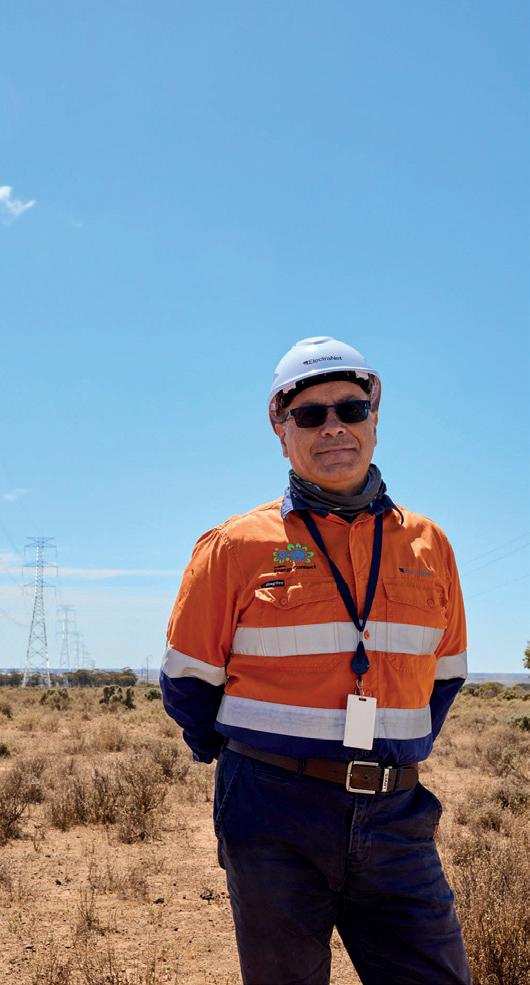
“Among its numerous other benefits to consumers, Project EnergyConnect will help provide transmission capacity for additional stages of our Goyder Renewables Zone in SA’s Mid North, leveraging the area’s world-class renewable resources and unlocking billions of dollars in investment for South Australia.”
DELIVERING ON TIME AND IN BUDGET
Mr Emms said successful delivery of the South Australian component on time and within budget was a credit to all involved. “The engagement with a large number of stakeholders throughout the project’s duration has played an important role in ensuring its successful delivery,” Mr Emms said.
“We would like to thank the Ngadjuri People, the River Murray Mallee Aboriginal Corporation (RMMAC), the First Peoples of the River Murray and Mallee Region 2, the Aboriginal Lands Trust, and the Renmark Paringa and Mid Murray councils for their assistance and support.
“I would also like to acknowledge the hard work of the ElectraNet project team and the multiple project contractors that delivered the project despite several challenges including weather, equipment and COVID-19. “Our transmission line contractor Downer delivered the 384 new transmission towers and associated stringing works, and Consolidated Power Projects delivered the new Bundey Substation.
Inter-network testing of Stage 1 of the new interconnector is scheduled to begin following construction completion of Stage 1 works on the New South Wales side by Transgrid by April 2024, with release of up to 150MW of power transfer capability by July 2024 –subject to successful testing.
Release of the full transfer capability of up to 800MW is planned for mid-2026, following Stage 2 construction completion in New South Wales by Transgrid, subject to Stage 2 internetwork testing.
“To deliver the South Australian component, about 15,000m 3 of concrete was poured, 2,500km of new conductor, 10,000t of transmission tower steel and 1,500t of reinforced steel was used,” Mr Emms said.
“The South Australian workforce had a peak of about 250 people and it’s anticipated the project will create 250 ongoing jobs in the state.
UTILITY • MAY 2024 WWW.UTILITYMAGAZINE.COM.AU 50
DEMAND MANAGEMENT
“Around 600,000 hours of labour was completed to successfully deliver the project, which was a huge effort.”
THE BUNDEY SUBSTATION
The new Bundey substation constructed in the Riverland as part of the project is also home to South Australia’s largest electricity transformers. The transformers play a critical role in enabling the flow of power across the new energy highway between South Australia and New South Wales, with each one weighing more than 250t when in operation.
Some of the other key features of the South Australian component of the interconnector includes the Special Protection Scheme, a small environmental footprint and higher towers to minimise vegetation cutting. Providing local content opportunities was an important objective with more than $45 million in contracts awarded to South Australianbased businesses.
“We had a large amount of services provided and work completed by South Australian and Riverlandbased businesses during the project including concrete, accommodation, logistics, fuel, and staff and equipment hire,” Mr Emms said.
“This was a significant investment into the regional South Australian economy and it was great to see so many local businesses involved in delivering the project.”
Positive engagement with landholders forms a critical part of ElectraNet’s high voltage transmission projects and ongoing maintenance, with an understanding of
Key management


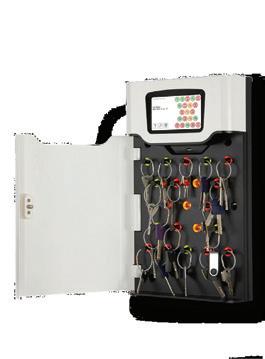


landholder’s values and requirements critical in its planning and operations.
As part of Project EnergyConnect (PEC), ElectraNet has continuously engaged with landholders from the early works right through to construction completion. This has made the project a collaborative effort, setting the benchmark for large infrastructure projects that are advancing South Australia’s transition to clean energy.
Meter security seals


UTILITY • MAY 2024 WWW.UTILITYMAGAZINE.COM.AU 51
DEMAND MANAGEMENT No. 407319937
Contact us for more information about our comprehensive range of key cabinets. Trackable Serial Numbering Expose Unauthorised Access
NULCA AUSTRALIA THE FOUNDATION DAYS OF
As the major representative body for locators in Australia, NULCA today provides essential leadership and support to its members and works to eliminate network damages, personal injury and costs to the community during excavation and construction activities. Here, we uncover the history of the association and the events that laid the foundation for the NULCA as we know it today.
NULCA Australia started in 2004 after some industry pioneers recognised the need to legitimise locating as a career and create opportunities for professional and organisational development in Australia. Following in the direction of the American brand of the same name, the Australian association was established via a formation committee and the inaugural AGM in July 2005 saw the appointment of the first voted committee.
Of course, an association needs members, however, finding them was not as easy as it is today. Using the yellow pages directory under the category “Detectors Electronic” various businesses nationwide were found and contacted by either fax or postal letter advising of the intent of this emerging Association and encouraging them to join. The new heading “Underground Service Locators” was effective in time for the 2008 issue of the Yellow Pages Metropolitan and Regional Directories after NULCA submitted a written letter of request – and what must have been a satisfactory response to a questionnaire from the Yellow pages to members to confirm that locating was a legitimate occupation.
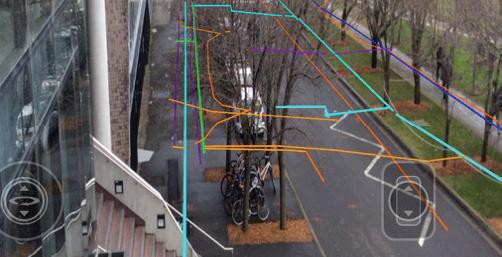
EARLY OBJECTIVES
One key objective of NULCA was to open doors and make things easier for members and ultimately the locating industry as a whole. This was done by identifying the needs of the locator; for example, educating insurers on what we do so they could create policies that cover us correctly, or giving business confidence to operators by connecting equipment suppliers who could bring the latest technologies and improve credibility of our profession. Further to this, the NULCA sought to create avenues for employers to find employees, trading posts and most importantly provide a platform for knowledge sharing. The culmination of these efforts and success of these objectives is evident by the feeling of community among members today.
EMBRACING ALL DISCIPLINES
With cross over in the spatial and mapping disciplines an attractive value add for many, the modern locator has access to a number of speciality tools, cloud-based platforms and dedicated NULCA Member Suppliers providing virtually round the clock support.
NULCA has embraced any variation to the meaning of locating and recognises that as a collective, every experience can help shape damage avoidance and safety around utilities strategies for business at all levels in the design, construction and ground disturbance sector.
Being a Locator requires one of the most important operational tools – plans. Plans are a starting point for any site investigations as they guide us to what we should be looking for. The Dial Before You Dig (DBYD) – now Before You Dig Australia – referral service was just as important then as it is now however, network operator participation was low,
UTILITY • MAY 2024 WWW.UTILITYMAGAZINE.COM.AU 52 UTILITY LOCATION
email was limited, plan rooms were manual and coordinating site works with plans in hand was far more difficult.
Trent Wray, who has been a Jemena employee of 29 years – and 20 of those working with DBYD plan distribution across 3 states and 2 territories – said that in the early days plans were distributed via fax or by posting a large mapping tile from their CAD based system. Getting information from the network operators at the speed we can is something we take for granted these days.
Aligning to the needs of industry and expectations from the Before You Dig Australia users, the more recent enhancement to its GIS automated system includes property connections to further assist in asset locating.
CURRENT DAY
Fast forward to the current day and the locating industry has greater traction than ever before. Paul Forbes, a NULCA founding member who has been in the industry since 2000, notes how much has changed in the attitude of his customers over the last two decades “We worked hard to build a client base that valued our contributions to their activities. Previously we could not be so picky, there was definitely a ‘tick and flick’ culture where getting a locate done was because they were told to not because they valued it,” Mr Forbes said.
Since its inception, NULCA has had six presidents and one chairman – following the change in 2020 from an incorporated association to a not for profit, ASIC registered public company limited. This change enabled NUCA to future proof its operational plans and increase its ability to operate at a national level eliminating state law restrictions.
Former NUCLA president and incumbent Chair, Ian Lambert, has led the way in a number of significant milestones. In 2010 he saw the creation of Australian Standard 5488 Subsurface Utility Information (SUI), now
currently in its third iteration. This standard provided an avenue for locators, surveyors, engineers and designers to understand expectations on scope of work and deliverables. Adopting AS5488 quality levels on field markings as well as the colour system assigned to specific utility types is now very common practice.
In 2015, NULCA supported the introduction of a certified locator program. The locating industry is still lacking governance in training and qualification, NULCA worked closely with then DBYD QLD to develop an assessment criterion that was endorsed by utility owners.


UTILITY • MAY 2024 WWW.UTILITYMAGAZINE.COM.AU 53 UTILITY LOCATION
The network operators themselves didn’t – and generally still don’t – provide rules or guidelines on who has permission to access their networks.
For a customer in need of a locate there was no way to differentiate the experience and therefore quality of a locating professional. NULCA influenced the RIICCM202 training course, delivered through JB Hunter Technology, and continues to provide training materials to registered training organisations to increase the skills and understanding of locators.
TAFE NSW has since incorporated an elective module of SUI into its Surveying Associate Diploma. TAFE Teacher and long-term locator/ surveyor within the Roads Department of Transport for NSW, Vito Zec, said that “there are many choices for surveyors, making our students aware of the opportunities as a Locator supports business’s whom otherwise need to train [graduates] from scratch.”
NULCA is exploring ways to support TAFE NSW students, such as a student membership so they get more exposure to this world.
NULCA has a membership base of more than 260 member, however that number can be deceiving when it comes to ascertaining just how many locators are out there. An NULCA member is a nominated representative of an organisation and there could be 20 employees of that same organisation listed as associate members.
NULCA founding member, former President and current administrative officer, Shirlee Cook, said “This model was adopted because we are not for profit and wanted to keep costs down. Further to this, most member benefits are for the organisation or business not the individual.”
Not all members are locators, and NULCA also extends its acceptance to the non destructive digging, under boring, plumbing and electrical trades.
DIGITAL RELIABILITY
Looking to the future, NULCA has exciting plans and partnerships to further build its community and raise the profile of locating within industry.
The board looks to continue its quarterly member meetings and newsletters, seek and provide opportunities in advocacy, training and awareness as well as build on NULCA’s portfolio of member benefits.
The age of augmented reality, digital engineering and digital twins has arrived and their quality is dependent on reliable information feeding them. NULCA’s meetings allow a platform of discussion on techniques, avenues to resolve concerns and continue the Locating and damage avoidance learning curve by sharing experiences. Providing these forums is an important part of creating this reliability.
NULCA Australia has and will continue to work for its members.


UTILITY • MAY 2024 WWW.UTILITYMAGAZINE.COM.AU 54 UTILITY LOCATION
Delivering smarter
PROFESSIONAL LOCATING SERVICES WITH NEW TECHNOLOGY
As the locating industry develops and customers require more advanced services, there is an increasing need for locators to become smarter and deliver better accuracy and better reporting.
The advent of more competitive GPS/GNSS antennas – such as the EMLID RX and Trimble DA2 – now allows locators the ability to precisely pinpoint position. In addition, easier reporting software like TerraFlow and PointMan as well as some excellent free to use GIS programs like QGIS all help professional locators to offer a higher standard of service to their customers.
To accommodate this shift in technology, the newly released Pathfinder Pro+ V4 now comes standard with a Bluetooth connection
that facilitates connection to these low-cost external GPS antennas. An external antenna opens better flexibility than inbuilt GPS antennas on locators. As most professional locate companies have both Ground Penetrating Radar (GPR_ and EMF locators, having inbuilt GPS antennas restricts what can be done when mapping and reporting. A separate external GPS antenna allows the operator to move the antenna for example the Pathfinder Pro+ V4 EMF Locator to a ImpulseRadar PinPointR GPR seamlessly.

It is easy to get caught up with marketing and the massive number of features available to the locator professional. Let Access Detection help by giving you the right advice for your needs.
Access Detection specialises in pipe and cable locators (EMF), GPR, water leak detection and specialised detection equipment.
For more information, visit


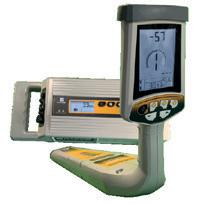
• NEW BLUETOOTH CAPABILITY FOR MAPPING
• COMPATIBLE WITH TRIMBLE DA2 GPS ANTENNA IMPROVED PERFORMANCE ON WEAKER SIGNALS
• STANDARD LITHIUM BATTERIES FOR RX & TX
• TRANSMITTER TO RECEIVER COMS PASSIVE POWER HARMONICS MODES
• BEST VALUE PROFESSIONAL LOCATOR


NEXT GENERATION DUAL FREQUENCY
• COMPACT, LIGHTWEIGHT DURABLE DESIGN
• ROUGH TERRAIN ABILITIES WITH LARGER WHEELS
• VIEWPOINT AND EXTERNAL GNNS/GPS FOR ACCURATE MAPPING ABILITIES
• SEE WHY SO MANY PROFESSIONAL LOCATORS USE THE PINPOINTR


• INNOVATIVE PRODUCT FOR LOCATING CABLES.
• POWERFUL INBUILT TRANSMITTER
• 33, 65 & 131 KHZ STANDARD FREQUENCIES
• PHONE APP CAPABLE ALLOWS YOU TO CHANGE POWER AND FREQUENCY FROM YOUR PHONE.
• AVAILABLE IN 150MM 100MM AND SOON 50MM SIZE

NEW Rycom Pathfinder PRO+ V4 Rycom ClampMitter
Sponsored editorial | UTILITY LOCATION
www.accessdetection.com.au
Unified Utility Models HELPING ENGINEERS TO TRUST UNDERGROUND DATA
Reveal has launched a new Unified Utility Model to help engineers understand the murky world of underground utility information and deliver their projects on-time and on-budget.

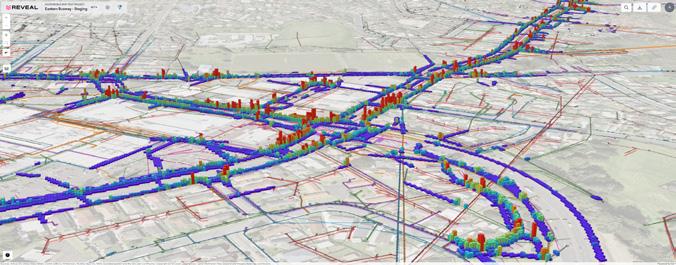
Most infrastructure construction projects begin with an engineer or CAD designer compiling maps from asset owners of all the existing utilities in a project scope area. It’s a painstaking and time-consuming exercise and, as many project managers will know, it can also be fruitless; existing utility plans are often incomplete and inaccurate, leading to inevitable design rework and delays on the ground as contractors uncover unknown utilities.
Slot trenches and trial holes can be dug to verify existing plans, but these low-coverage necessary investigations often impact larger areas and cost more than required; causing major disruption to the public and the community through traffic closures, noise, pollution and carbon emissions.
The field of utility locating has emerged over the past few decades to fill the gap in providing accurate data
on the location of underground utilities. However, typically this information is only gathered by contractors prior to starting construction. Vital information about anomalies or undocumented utilities that could help inform design decisions goes unrecorded or remains as paint marks on the ground to be washed away over time.
DRIVING SAFETY AND EFFICIENCY IN CONSTRUCTION
To improve project outcomes and drive safer, more efficient infrastructure construction, Reveal has developed the concept of a Unified Utility Model – a 3D utility map that combines all sources of data on the underground in a framework that can be accessed and understood by engineers at the concept and design phases of a project.
The Unified Utility Model takes existing utility plans and informs
them with the results of geophysical investigations and visual verifications to produce accurate, comprehensive models of the underground that are compatible with BIM and CAD design environments.
The Unified Utility Model applies internationally supported utility detection and mapping standards such as PAS-128 and AS-5488. Engineers can easily interpret and rely on the intuitive visualisations that accurately describe both the underground detections and the risks associated with them.
The Unified Utility Model depicts the existing utility record, the results of the utility investigation and the updated 3D visualisation of the asset, with a chain of evidence showing how the model has been derived.
Armed with the Unified Utility Model findings, engineers can design with confidence, knowing they are minimising the risks of project delay and cost overrun that affect most infrastructure construction in Australia.
Contact Reveal today to learn more about how your engineering consultancy can deploy Unified Utility Models on your next project.

UTILITY • MAY 2024 WWW.UTILITYMAGAZINE.COM.AU 56
UTILITY LOCATION | Sponsored editorial
For more
visit www.reveal.nz
information,


With Reveal, you can eliminate subsurface risks, deliver infrastructure projects faster and minimise cost blow-outs and variations.
If you need to understand your underground, get in touch with the world’s leading subsurface experts.
WWW.REVEAL.NZ
REVEAL ARE AUSTRALASIA’S INNOVATIVE SUBSURFACE EXPERTS.

CYBERSECURITY CHALLENGES in the water and wastewater industries
Water and wastewater companies are undergoing digital transformation, digitising processes, adopting the Internet of Things and Artificial Intelligence technologies to improve efficiency and reliability. The connectivity of operational technology to the internet and the convergence between operational technology and IT have created extreme efficiencies, new vulnerabilities and exposure to cybersecurity threats.
Some of the cybersecurity challenges faced in the water industry are related to legacy technologies, lack of awareness, interconnectivity, insider threats and budget allocation.
The main question utilities need to answer is how could the water and wastewater industry be affected by cyber-attacks?
According to the US Cybersecurity and Infrastructure Security Agency, these are the challenges to keeping this critical infrastructure operating safely.
OPERATIONAL TECHNOLOGY
Network complexity: water operational networks may contain hundreds of diverse components that can be difficult to map and update properly. This complexity may lead to operators not having complete visibility into their networks, which in turn may contribute to misconfigurations and continued usage of components not included in a utility’s network mapping.
System maintenance: improperly maintained custom and commercial off-the-shelf components, particularly those not updated on security patches or operating beyond end-of-life, can leave operational technology (OT) systems vulnerable to attack. Managed service providers may be used within critical infrastructure to support both IT and OT networks and, if compromised, could provide adversaries with remote access to customers’ OT systems. Successful exploitation of an OT system can give the attackers a direct means of manipulating systems that support the management of water systems.
IT/OT CONVERGENCE
Network segmentation: malicious actors may use IT networks as a vector to target non-segmented OT networks and systems. Proper network segmentation is the most effective way to prevent cyberattacks against OT networks and IT systems.
Data: malicious actors may attempt to access IT systems to steal sensitive data, turn off network components and move laterally within a network to access other, more sensitive systems. They may also attempt to use stolen information to move laterally within the network and access other more sensitive areas.
Ransomware: ransomware attacks can disrupt operations within a facility until systems are restored. While disruptions
in office-based systems are most common, ransomware can also infect connected OT systems, particularly if there is not adequate segmentation between IT and OT systems.
While not a risk assessment standard per se, the National Institute of Standards and Technology (NIST) Cybersecurity Framework is one of the foremost resources for informing risk assessments. In addition, the Australian Security of Critical Infrastructure Act 2018 (the SOCI Act) highlights the NIST framework as guidance for critical infrastructure sectors – including water – to write the Critical Infrastructure Risk Management Program (CIRMP) (which has a deadline of August 2024).
Organisations with critical infrastructure, such as those operating in the water and wastewater sectors, must act quickly. Based on these findings and aligned with the NIST framework, NHP and Rockwell Automation’s cybersecurity professionals recommend these core steps:
• Undertake asset inventories
• Perform accurate risk and vulnerability assessments to locate the areas of greatest weakness
• Develop a cybersecurity plan based on assessment results
• Segment and harden networks with an industrial demilitarised zone and firewalls
• Implement threat monitoring
• Prepare and rehearse incident response plans
Although many water and wastewater utilities have invested the necessary time and resources in cybersecurity, the sector needs to make more progress in securing IT and OT systems.
NHP collaborates closely with partner Rockwell Automation to deliver all-inclusive cybersecurity solutions that go beyond network security. Our range of services, hardware and software is certified and aligned with the industry's most robust standards and frameworks, such as ISA/IEC 62443 and the National Institute of Standards and Technology Cybersecurity Framework. Our solutions can assist clients in evaluating, executing and maintaining ICS security within operations and enabling transformational technologies that depend on enterprise connectivity.
For more information, please call your local NHP Account Representative on 1300 NHP NHP or go to nhp.com.au/cybersecurity
UTILITY • MAY 2024 WWW.UTILITYMAGAZINE.COM.AU 58
CYBER SECURITY | Sponsored editorial
Now designed and built for outdoors
■ Maximum durability in outdoor environments with corrosion protected surface
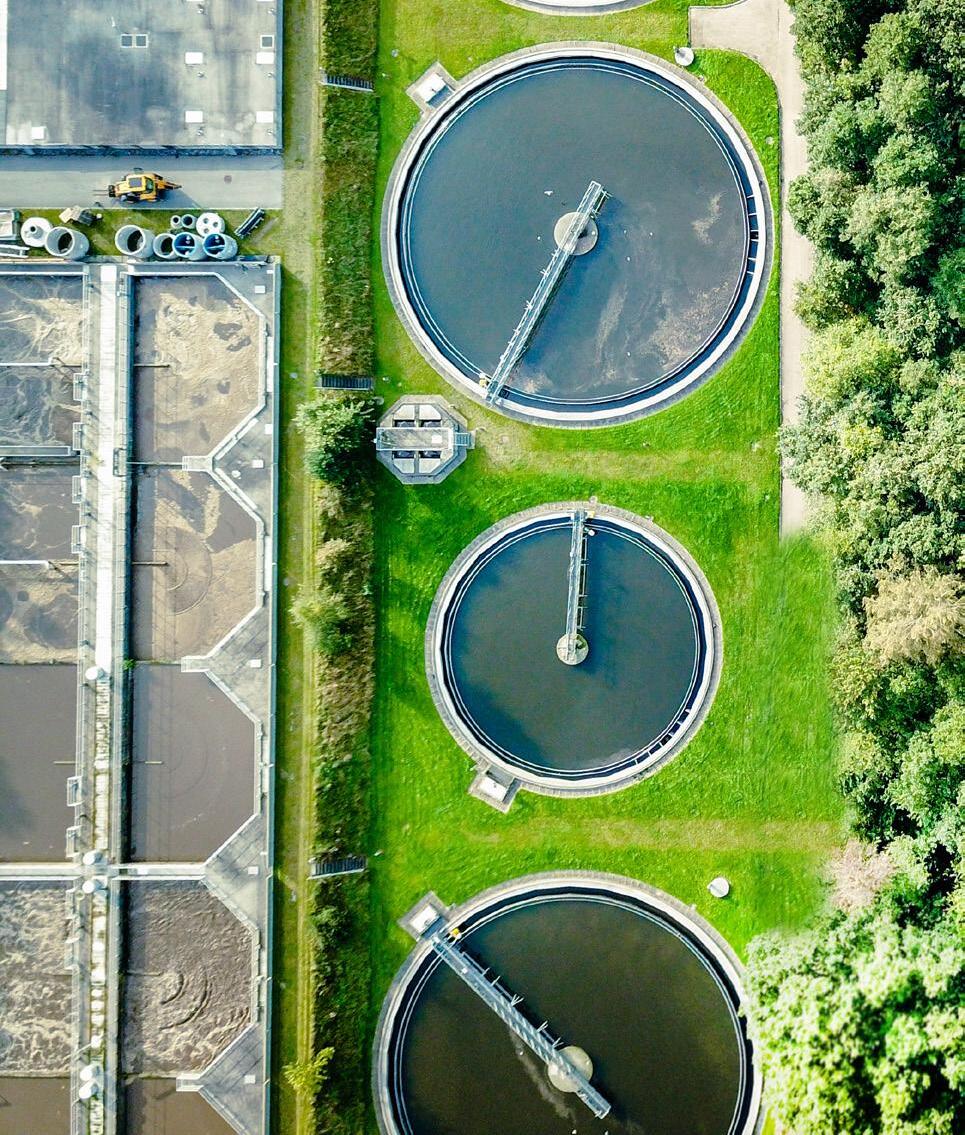
■ Tested under UV radiation according to IEC 61439-2:2020, with roof and side covers protecting approximately 95% from sun
■ Ingress protection IP56
■ Toe-out plinth enabling easy outside mounting
■ Freedom to choose electrical components and switchgear from your component manufacturer.
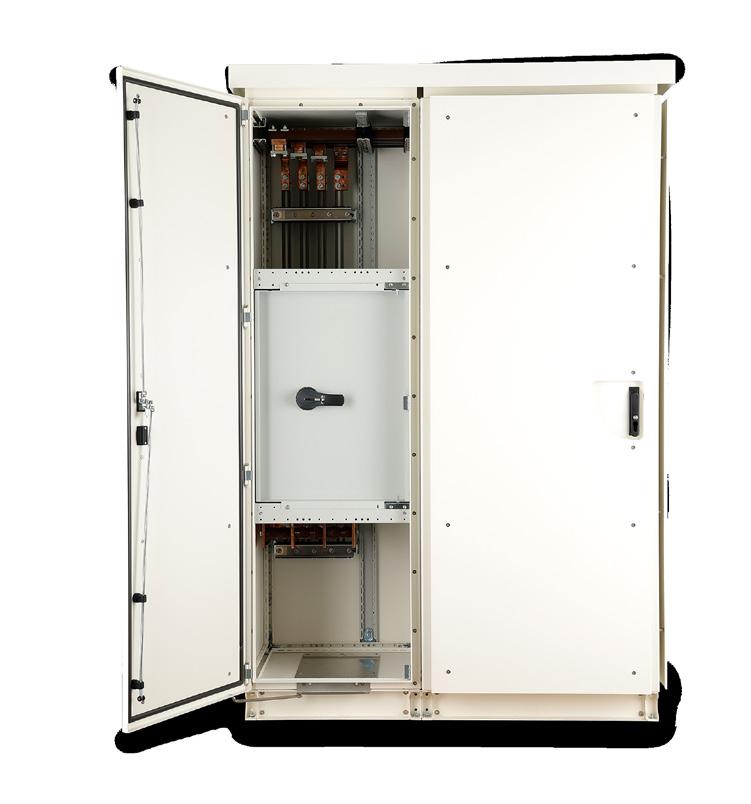

NEW Outdoor Modular switchboard system
Scan here to register nhp.com.au 1300 647 647 nhpsales@nhp.com.au
A HISTORIC DESALINATION UPGRADE FOR OUTBACK SA COMMUNITY Delivering
For the first time, residents and businesses in Marla can access safe and clean drinking water directly from their taps, with SA Water’s new desalination plant now operating in the Far North South Australian town.
Located just over 1,000km north-west of Adelaide, Marla is at the junction of the Oodnadatta Track and the Stuart Highway, with around 70 people calling it home.
The community’s water supply has historically been designated as non-drinking, with residents previously sourcing their own drinking water from private rainwater tanks, water carting or bottled products.
The town’s small-scale desalination plant is now producing drinking-quality water for locals to use in their kitchens, bathrooms, laundries and gardens.
SA Water’s General Manager of Sustainable Infrastructure Amanda Lewry said this is the utility’s second drinking water upgrade for a remote town in the past 12 months.
“Having delivered a new desalination plant for our customers in nearby Oodnadatta last August, it’s exciting to see yet another of the state’s iconic outback towns enjoying safe, clean drinking water flowing through their pipes for the first time,” Ms Lewry said.
“Whether it’s greening the garden or topping up the kettle straight from the tap, we recognise the significance this upgrade is already having on promoting health and hydration, along with the positive social and economic opportunities it’s providing.
“Marla’s desalination plant – constructed inside a shipping container to help protect the infrastructure from the sometimes harsh weather experienced in the area – can produce up to 87,000L of water each day.
“Drawing water supply from the largest groundwater basin in Australia, the Great Artesian Basin, the plant’s reverse osmosis technology pushes the sourced supply through a semipermeable membrane designed to separate the water and salt molecules.

“The purified water continues through the membrane for further cleaning and treatment to make sure it meets the requirements under the Australian Drinking Water Guidelines (2011), before being stored inside an on-site 539,000L capacity tank, for distribution through a network of pipes to the town.
“The brine by-product created in the desalination process is diverted in the other direction, to be stored in the large on-site large evaporation basin.”
According to Ms Lewry, it took an extensive planning and delivery process to reach the plant’s first water milestone.
“Delivering a remote facility of this size and scope is a sizeable task, including the necessary design, procurement, community engagement, construction and testing required to ensure our customers’ supply meets the requirements of the Safe Drinking Water Act (2011) and the Safe Drinking Water Regulations (2012),” Ms Lewry said.
“Adding into this complexity are the challenges that come with distance, with Marla’s far north location more than 1000km north of Adelaide’s CBD.
“Having delivered a total of 12 desalination plants across the state – five of which service remote Aboriginal communities in the state’s Anangu Pitjantjatjara Yankunytjatjara Lands and Far West Coast – we are well experienced in the requirements to not just deliver plants such as this, but sustainably operate them for decades to come.
“We’ve worked closely with the Marla community to get to this historic point throughout the important project, and we encourage locals and tourists passing through the South Australian outback to give Marla’s new desalinated tap water a try!”
UTILITY • MAY 2024 WWW.UTILITYMAGAZINE.COM.AU 60
SUSTAINABILITY

MORE OUTBACK UPGRADES ON THE WAY
In the face of climate change, SA Water recognises the importance of delivering resilient and secure drinking water sources, including desalination.
Marla is one of three outback communities confirmed for an upgrade to their non-drinking water supply during SA Water’s 2020–24 regulatory period, with the township of Oodnadatta’s new desalination plant producing its first flush of drinking water for around 200 residents last year.
While both town’s new facilities harness ultrafiltration feed pumps, dosing pumps and systems, and reverse osmosis pumps with production levels ranging from 1.5 to 4L per second, each site is individually designed to reflect the location’s unique conditions.
“Having seen the positive benefits Oodnadatta’s upgrade has delivered for the town, including the iconic Pink Roadhouse, we are incredibly excited to see the same outcomes reaped by our customers in Marla,” Ms Lewry said.
“We’re not done either, with a small-scale desalination plant set to be producing safe and clean tap water in coming months for the Marree in South Australia’s Far North.
“We recognise the important role a sustainable drinking water source plays in maintaining health, supporting hydration and facilitating future growth and development, and we look forward to delivering these important initiatives for our remote customers.”
Additionally, progress is continuing on water quality upgrades to existing water supply systems in the regional
towns of Yunta, Manna Hill and Terowie in the state’s north-east, with each set to be completed by mid 2024.
“These important upgrades will improve both the quality and reliability of supply for our local customers through the construction of new storage tanks and disinfection treatment stations to better maintain water quality throughout the local pipe networks.
“Yunta, for example, is currently supplied by water carters drawing from our existing water network in Peterborough –approximately 80km south of the town,” Ms Lewry said.
“The new disinfection unit will add another point of water treatment, helping to maintain a more consistent quality of supply from when the water is first treated at the Morgan Water Treatment Plant to our customers’ taps.”

UTILITY • MAY 2024 WWW.UTILITYMAGAZINE.COM.AU 61
SUSTAINABILITY For further information contact SA Water’s media team on 08 7424 2477

Innovative solutions FOR HYDROGEN ELECTROLYSIS
Electrolyser systems for green hydrogen production in Australia need to be as efficient as possible, in order to generate hydrogen with the smallest possible quantity of renewable primary energy, while at the same time being able to be deployed in areas of varying water quality.
Hydrogen is the most common chemical element in the universe and when it is produced using renewable energy or processes, is an emissions-free fuel and becomes a way of storing renewable energy for use when it is needed.
While there are a number of traditional methods of producing hydrogen, interest has now firmly shifted towards so-called green hydrogen production utilising electrolysis of water, with the electricity generated from renewable sources.
In Australia, the government, industry and researchers have undertaken a substantial amount of work to quantify the opportunities of renewable hydrogen production. The Federal Government has also established a $2 billion Hydrogen Headstart initiative, which will aim to scale up large green hydrogen projects in Australia.
CONTROLLING THE PROCESS
Like any industrial process, electrolysis needs to be as efficient as possible, in order to generate clean hydrogen with the smallest possible quantity of primary energy. To do this demands exact and reliable control of all important parameters, such as flow rates and pressures on both the anode and the cathode side.
Bürkert offers valve and sensor solutions that can ensure that the electrolysis process is low-loss and lowmaintenance, and will be operated safely, including:
• Direct-acting motor valves that can reliably and safely control the flow of cooling water, with minimal energy demand through low power consumption in holding mode
• Reliable flowmeters to continuously determine the quantity of the deionised water supplied, as well as the cold-water supply for the cooling circuit
• Innovative process control valves to precisely and dynamically control the outlet back pressure on the anode and cathode side of the electrolyser
• Precise pressure sensors to determine the pressure of the oxygen discharged at the stack with high accuracy, as well as the hydrogen supplied to the dryer, in corrosion-proof stainless steel
• Solenoid safety shut-off valves for safe shut-off of the deionised water supply when powered off, as well as the oxygen and hydrogen gases
• Digital networking components and gateways for simplified wiring and higher-level control system communications
HYDROGEN PRODUCTION NEEDS CLEAN WATER
The water used to fuel a hydrogen electrolyser must be pure deionised water, so the source of the water and its purification is a serious consideration in the design of the plant.
Australia is however the driest inhabited continent – something which may present challenges for the development of green hydrogen production. The development of hydrogen production facilities will therefore depend on utilising various sources of water (including nonpotable sources) that may require additional pre-processing, particularly if the hydrogen production is to be located in an inland regional area.
Any given hydrogen generation facility will therefore need to be designed with appropriate water purification and recycling facilities, making each facility a potentially unique design.
BÜRKERT: HERE TO HELP
The field of water treatment demands the best instrument performance and networkability. For 40 years Bürkert Australia has become a preferred supplier for innovative digitalised fluid control solutions to the water industries, and though Bürkert’s systemhaus, a forward thinking and innovative team can help support hydrogen generation facilities in solving the unique challenges of their application, utilising the latest advanced digital process control technologies.
UTILITY • MAY 2024 WWW.UTILITYMAGAZINE.COM.AU 62
SUSTAINABILITY | Sponsored editorial
For more information on how Bürkert Australia can help your business, head to www.burkert.com.au/en

Innovative Solutions
for Hydrogen Electrolysis: Optimal Electrolyte & Water Supply
// Discover our Precise Pressure Control Solutions >

INTERFLOW’S SUSTAINABILITY STRATEGY: for climate, communities and our kids
The longevity of a business depends on its ability to meet the needs of both current and future generations, and right now that requires an all-encompassing sustainability strategy. Here, Interflow’s Executive General Manager Southern Region, Richard McCarthy, discusses Interflow’s unique and diverse approach to sustainability and longevity.

As one of the longestserving private businesses in Australia, Interflow has always appreciated the necessity of shaping the business around the needs and expectations of current and future generations.
Sometimes that forwardthinking involves innovation and professionalism, and it is always related to good commercial decision making. But today, there’s another vital ingredient in the recipe for success – ESG, or environmental, social and governance – and for many people, this is personal.
“I’ve got three kids, all at university age and older,” Mr McCarthy said.
“Your own kids make you realise it’s not just about your time here. It’s about what you’re leaving behind.”
Interflow’s customers also have expectations of the contractors they bring on board. But Interflow doesn’t want that to be the driver of its core ESG priorities.
“We’re building an ESG strategy because it makes sense in every way,” Mr McCarthy said.
“Our ESG strategy is looking at what we can add in next. What can we do
well that will make a real difference to the business, to our customers and to our community?”
ESG IS MUCH MORE THAN NET ZERO
A key focus area of interflow’s ESG strategy is inclusion and diversity. This is driven by the overwhelming evidence around the phenomenal power of a workforce that has diverse perspectives, backgrounds, experiences and ways of thinking.
“We’re creating an all-encompassing ESG framework for three reasons,” Mr McCarthy said.
“One is that it’s so clearly aligned to Interflow’s purpose. So if we don’t do it, we’re not delivering on our purpose.
“The second is that it just makes good business sense. Sustainability is going to save the business money, open new opportunities and enhance our reputation.
“Finally, we’re doing it because it’s the right thing for us to do.”
Mr McCarthy explained that this strategy is enhancing the work that Interflow is already doing.
“Once we put a framework in place that allowed us to measure our
own performance, we recognised that we were doing quite well," Mr McCarthy said.
“It then becomes about enhancing this across the business.
“We’re taking quite a methodical approach to our path to net zero.
“We don’t know exactly what it looks like yet, but we do know we want to do this as a coordinated unit.”
INTERFLOW’S PEOPLE EXPECT NOTHING LESS
A clear ESG strategy is not negotiable for the Interflow team, and Mr McCarthy explained that people want to work for an organisation that aligns to their own values and beliefs.
“What’s important is that we’re constantly developing our ESG strategy. But, it’s also important that we’re open and honest about what we can do and where we don’t yet have the answers,” Mr McCarthy said.
“Our people want their employer to work with purpose. Our community expects and requires our care and attention in everything we do. That’s why we’re putting so much effort into it, right now.”
UTILITY • MAY 2024 WWW.UTILITYMAGAZINE.COM.AU 64
SUSTAINABILITY | Sponsored editorial
For more information, visit www.interflow.com.au








We’re Creating the Future of Water for climate, communities and our kids

Pioneering the global energy transition
FOR A CONNECTED AND SUSTAINABLE FUTURE
Australia has some of the best wind resources in the world, and the establishment of wind farms plays a pivotal role in both the transition towards renewable energy and reducing Australia’s CO2 emissions. Here, we explore how tailored cable solutions improved the efficiency and reduced installation waste during construction of the Stockyard Hill Wind Farm.
Wind energy stands as a cornerstone of sustainable power generation, harnessing natural air currents to produce electricity. Australia, with its expansive territories and consistent winds, presents a prime landscape for wind energy development.
The combination of abundant wind resources and advanced turbine technology has facilitated the establishment of wind farms, marking a significant shift away from fossil fuel-based electricity generation. This transition not only reduces Australia's carbon dioxide emissions but also plays a pivotal role in mitigating the impacts of climate change.
In alignment with the vision for a sustainable future, Marais Laying Technologies Australia – a subsidiary of the Tesmec Group – partnered with Nexans to design, manufacture, supply, install, and test 275km of 33kV collector cables for what became the largest wind farm in the Southern Hemisphere – the Stockyard Hill Wind Farm.
A LANDMARK PROJECT
Stockyard Hill Wind Farm is situated 35km to the west of Ballarat, features 149 turbines with a capacity to power
390,000 homes and reduce CO2 emissions by approximately two million tonnes annually. Nexans' involvement in this landmark project was instrumental in reducing the levelised cost of electricity (LCOE), thereby advancing the scalability of wind farms and facilitating the attainment of a 50 per cent renewable energy target by 2025.
TAILORED AND SUSTAINABLE SOLUTIONS
To address the unique challenges posed by large-scale wind projects, Nexans leveraged its expertise to deliver tailored solutions, optimising cable configurations and energy transmission systems. In this project, Nexans's WINDLINK cable solutions, characterised by continuous manufacturing processes, facilitated an efficient cable network layout with minimal joints, thereby reducing labour and installation waste.
In addition to providing cables, Nexans offered comprehensive end-to-end services, including underground junction chambers (UJC’s), indoor terminations for substation connections, and tower end ring main unit (RMU) connections, further streamlining wind installations
and reinforcing its commitment to sustainable energy transition.
By delivering high-quality cables and components for the Stockyard Hill Wind Farm, Nexans ensured maximised the project’s operational efficiency, averting power losses and minimising costly shutdowns. With a track record of reliability and technical expertise, coupled with substantial production capacity, Nexans continues to solidify its position as a leader in Australia's renewable energy transition through this project.
Since 2018, Nexans has undergone a transformative journey, placing energy transition at the core of its strategy, with a focus on sustainable electrification. As a key player and strategic partner in wind energy, Nexans has a proven reputation for cable reliability and technical expertise, with substantial production capacity, which features Nexans always standing at the forefront of powering Australia's energy transition towards a more connected and sustainable future.
UTILITY • MAY 2024 WWW.UTILITYMAGAZINE.COM.AU 66
SUSTAINABILITY | Sponsored editorial
For more information, visit nexans.com.au
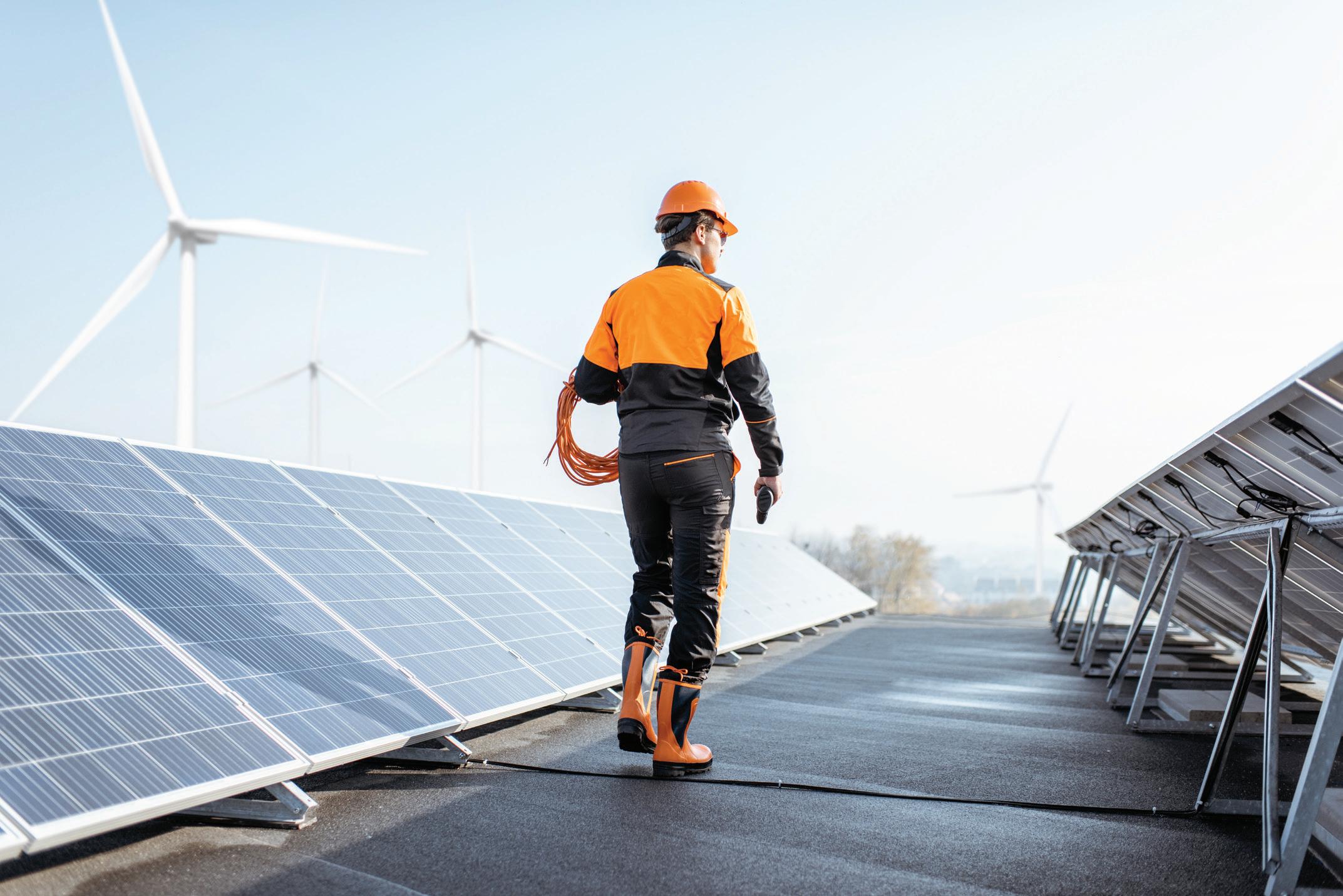
With an unwavering commitment to empowering Australia's journey towards a more sustainable future, your local manufacturer, Nexans Australia, delivers comprehensive and sustainable electrification solutions to meet the country's network requirements and the growing energy demands of the modern world. Our dedicated efforts drive us forward, fostering a more sustainable future for all.
RELIABLE SOLUTIONS for power distribution
generation Contact us to discover our renewable solutions. nexans.com.au
& renewable
ENHANCING VISIBILITY OVER OPERATIONS AT ENDEAVOUR ENERGY
Endeavour Energy is one of Australia’s biggest electricity distributors, and the task of managing its assets is large and complex. The utility recently undertook the task of upgrading their vegetation management system, and has implemented a software platform that has significantly simplified a once complicated part of its overall asset management program.
Endeavour Energy is a leading electricity distribution company operating in New South Wales, servicing over 2.7 million people living and working across Sydney’s Greater West, the Blue Mountains, the Southern Highlands, Illawarra and the South Coast. With an estimated value of $6.7 billion, the network supplies 1,034,215 customers spanning over 25,000 square kilometres.
Endeavour Energy’s vast network is made up of more than 430,000 power poles and streetlight columns, 202 major substations and 32,600 distribution substations connected by nearly 60,600 kilometres of underground and overhead cables. It also integrates with renewable energy sources including 200,000 residential solar connections, industrial solar and embedded large-scale batteries.
Endeavour Energy was experiencing a number of challenges in managing data and data accuracy around its vegetation management processes. With their system, they were finding it difficult to integrate different programs and techniques within vegetation management. There was also a lack of transparency of contractor works both operationally and commercially and the company lacked the capability to make data-driven decisions.
Knowing they needed to update their vegetation management system, Endeavour Energy set out to find a platform that would:
• Increase transparency on contractor works
• Provide easy access to live data
• Offer greater control over program costs
• Lead to improved data quality
• Act as a single source of truth for all facets of vegetation management
THE XUGO SOLUTION
After assessing the solutions on the market, Endeavour Energy opted to implement Xugo, a powerful work management software solution that can be used for vegetation management.
Since migrating over to the Xugo platform, Endeavour Energy is now able to monitor all facets of its vegetation management program, with the ability to segregate individual work programs. This has resulted in increased control over the service/performance management of the overall program.
Xugo facilitates instantaneous reporting on all aspects of the contract, ensuring timely and accurate monitoring of operations. The platform allows for live changes of tasks and hazards, ensuring productivity counts are correct and up-to-date. Additionally, Xugo has provided increased visibility of the audit trail for operational, financial and commercial outcomes.
Overall, Xugo has enabled Endeavour Energy to have better control over its information and workflows, resulting in more confidence in the process and the data. The platform provides real-time visibility when it comes to the completion of works and improved abilities for data standardisation, summary and statistical reporting and trend analysis.
“Xugo is a ready-to-go solution backed by a strong team of analysts and developers at SFI. They understand the nuances of our business operations and organisation data and the Xugo mobile application and work management software is configured to effectively support those specific needs,” said Sagar Lamba, Manager – Major Contracts, Endeavour Energy.
“The responsive support post-deployment, for both field staff and back-end users has ensured a successful transition to Xugo at Endeavour Energy.”
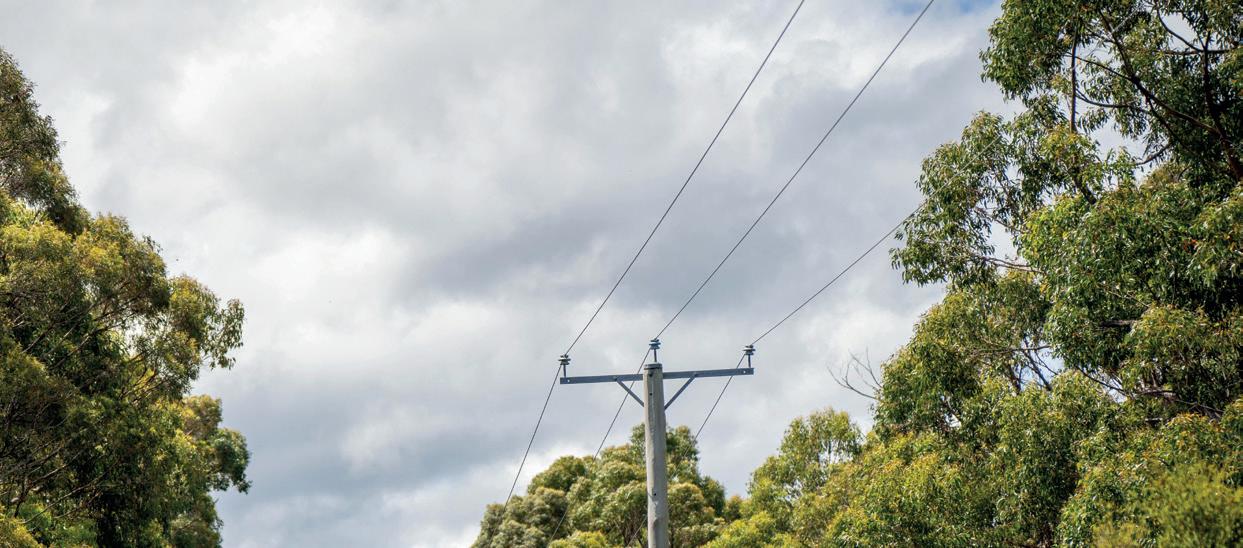
To learn more about how Xugo can simplify vegetation management processes for your business, head to https://www.xugo.com.au
68
INSPECTION, CCTV & CONDITION ASSESSMENT | Sponsored editorial


HANDLING THE PRESSURES OF WATER TREATMENT WITH PROCESS AUTOMATION
Managing a water treatment system for a major metropolitan network requires careful monitoring and streamlined processes to ensure that operations are not interrupted. Here, we take a look at how a United States water utility implemented pressure transmitters to automate their processes and deliver precise and reliable data.
Operating a massive metropolitan water treatment system is a mammoth task that demands careful monitoring and management of intricate processes across a sprawling network.
In order to streamline this system and free up personnel for more pressing matters, a water company in the United States made the decision to automate its processes through the installation of pressure sensors across its network.
LEFT TO THEIR OWN DEVICES
The first unexpected hurdle the company faced was the challenge of using sensors from many different manufacturers. While this worked on a technical level, in practice it proved to be a headache for water company personnel. Chief amongst these issues was the overall end user experience; the devices were difficult to configure and operate, and with many different devices at play, the knowledge gained by learning to operate one sensor typically wasn’t transferable to another.
The other major hurdle was in obtaining support for these devices. According to company personnel, years would pass without seeing anyone from some of the device manufacturers, therefore the team just had to do their best to configure and troubleshoot dozens of devices.
DISCOVERING THE VEGA EXPERIENCE
The water company’s search for a new instrument supplier led it to the process measurement experts at VEGA, and over the course of multiple
days the VEGA team toured the utility’s facilities and met the people involved in their instrumentation and automation decisions to better understand its needs.
From there, VEGA provided trial units to be tested on multiple applications, allowing the team to see firsthand what set VEGA pressure instrumentation apart. The water company was impressed by the precision and reliability of the measurements, and the sensors were easy to set up and configure – some even offered features like Bluetooth connectivity that allowed operators to wirelessly monitor, set up, and adjust them through the VEGA Tools app.
After exploring VEGA’s solutions, the water company decided that it had found the instrumentation partner it was looking for. VEGA personnel worked closely with the utility to not only install and commission VEGA sensors across the entire system, but also to train operators on how to use the sensors and best leverage them to reach process automation goals.
PRECISE AND RELIABLE MEASUREMENTS ACROSS THE SYSTEM
Today, the water company utilises VEGADIF 85 pressure transmitters to handle influent and effluent flow metering in numerous locations throughout its system. Its high-precision measured value detection makes this sensor capable of measuring very low differential pressures, meaning the water company obtains precise and reliable data.

VEGABAR 38 pressure sensors measure the level on tanks as well as chemical fill and feed systems – and the sensor’s configurable colour LED light ring allows system operators to clearly view the pressure status.
VEGABAR 82 pressure transmitters measure at inlets and outlets on vaults. This transmitter sports an abrasion-resistant ceramic measuring cell, ensuring reliable operation in the toughest of process conditions, in turn saving the company on maintenance costs.
The company also added another VEGA instrument to its system: the VEGAWELL 52, which is optimised for measuring the level of the utility’s deep wells and the local river. The VEGAWELL 52’s robust ceramic measuring cell offers maximum overload and vacuum resistance, making it a highly reliable addition to the water company’s process automation arsenal.
VEGA’s proven mix of precise, reliable instruments and commitment to customer support means that the water company operators are now empowered by process automation instead of struggling with usability or maintenance issues – freeing valuable personnel to focus on other responsibilities and taking the pressure out of pressure measurement.
For more information, contact VEGA Australia or visit www.vega.com/en-au/industries/ water-wastewater
UTILITY • MAY 2024 WWW.UTILITYMAGAZINE.COM.AU 70 INSPECTION, CCTV & CONDITION ASSESSMENT | Sponsored editorial

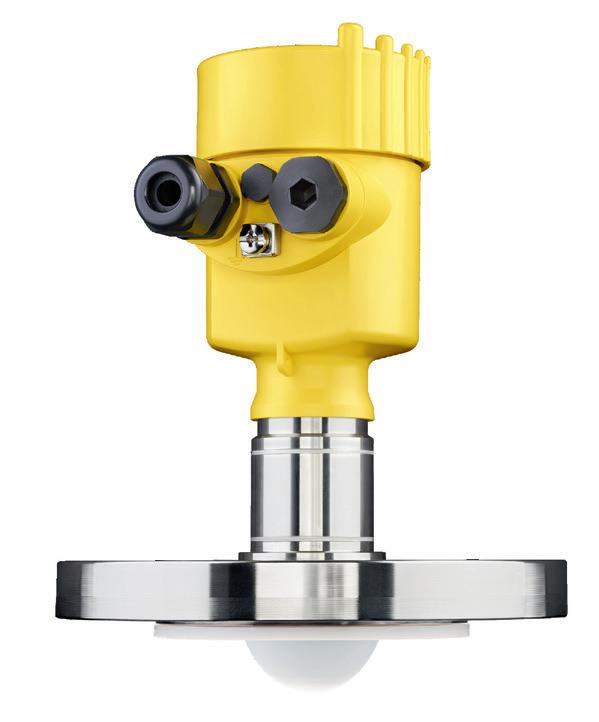
PRECISION, SIMPLICITY, COMPATIBILITY. THE 6X ® The new 6X radar level sensor is so easy to use, it’s simply a pleasure. Because we know customers value not just ‘perfect technology’, but also making everyday life better and less complicated. We wouldn’t be VEGA if measurement technology was our only value. VEGA. HOME OF VALUES. www.vega.com/radar
WHAT IS NON-DESTRUCTIVE TESTING AND WHAT ARE ITS ADVANTAGES?
Non-Destructive Testing is any of a wide group of analysis techniques used in science and technology to evaluate the properties of a material, component or system without causing damage. Here, we look at the different types of Non-Destructive Testing and the advantages the different techniques offer.
Non-Destructive Testing (NDT), also known as Non-Destructive Inspection or Non-Destructive Examination, offers a number of distinct advantages.

The most obvious of these is the fact that the items being inspected are left undamaged and usable. Because NDT does not permanently alter the article being inspected, it is a highly valuable technique that can save both money and time in product evaluation.
WHAT ARE THE TYPES OF NDT?
NDT falls into six main categories: visual, ultrasonic, magnetic particle, liquid penetrant, radiographic and eddy current inspections.
Visual and optical testing
The most basic NDT method is visual examination. Visual examiners follow procedures that range from simply looking at a part to see if surface imperfections are visible, to using computer controlled camera systems to automatically recognize and measure features of a component.
Remote visual inspection uses a borescope with a rigid or flexible probe to look into components, pipes or tanks.
Ultrasonic inspection
In ultrasonic testing, an inspector will use a probe or transducer to send sound waves through the material. If there are no defects in the material, the sound waves will pass through it, but if the sound waves hit a defect, they will bounce off of it, indicating their presence.
Ultrasonic thickness testing measures the time for a sound wave to travel through to the back wall of a component or pipe and return to the transducer. This time is used based on the sound velocity of the material to calculate thickness.
Magnetic particle testing
This NDT method is accomplished by inducing a magnetic field in a ferromagnetic material and then dusting the surface with iron particles (either dry or suspended in liquid). Surface and near-surface flaws disrupt the flow of the magnetic field
within the part and force some of the field to leak out at the surface. Iron particles are attracted and concentrated at sites of the magnetic flux leakages producing a visible indication of defect on the surface of the material.
Penetrant testing
With this testing method, the test object is coated with a visible or fluorescent dye with exceptionally low surface tension. This is allowed to dwell on the surface to allow penetration into fine defects or cracks. Excess solution is removed from the surface of the object but remains in surface breaking defects. A developer is then applied to draw the penetrant out of the defects. With fluorescent dyes, ultraviolet light is used to make the bleed-out fluoresce brighter, allowing imperfections to be readily seen. With visible dyes, a vivid colour contrast between the penetrant and developer makes the bleed-out easy to see.
Radiography
This involves using penetrating gamma or X-radiation on materials and products to look for defects or examine internal or hidden features. An X-ray generator or radioactive isotope is used as the source of radiation. Radiation is directed through a part and onto film or detector. The resulting shadowgraph shows the internal features and soundness of the part. Material thickness and density changes are indicated as lighter or darker areas on the film or detector in a similar manner to medical X-rays.
Eddy current testing
In eddy current testing, electrical currents (eddy currents) are generated in a conductive material by a changing magnetic field. The strength of these eddy currents can be measured. Material defects cause interruptions in the flow of the eddy currents which alert the inspector to the presence of a defect or other change in the material. Eddy currents are also affected by the electrical conductivity and magnetic permeability of a material, which makes it possible to sort some materials based on these properties. For over 30 years Russell Fraser Sales Pty Ltd has been supplying NDT inspection and testing equipment to industry, mining, marine and aviation industries in Australia, New Zealand and the Pacific. For more information, head to www.rfsales.com.au
UTILITY • MAY 2024 WWW.UTILITYMAGAZINE.COM.AU 72 INSPECTION, CCTV & CONDITION ASSESSMENT | Sponsored editorial



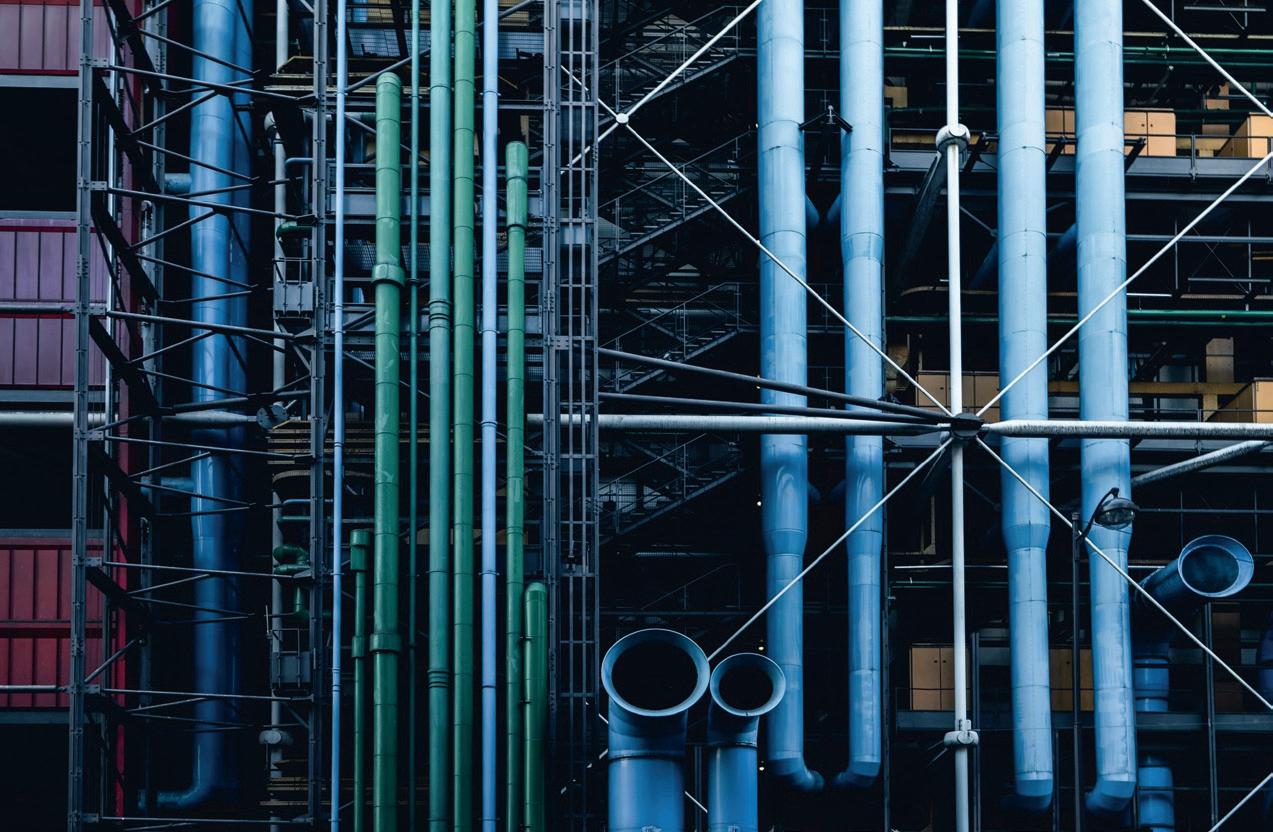


NDT 02 9545 4433 | rfs@rfsales.com.au | www.rfsales.com.au Serving the Industry Since 1993 Inspection, Testing & NDT Equipment Sales VISIOPROBE Remote Visual Inspection with Pan & Tilt Camera PORTASONIC PLUS FLOWMETER HIKMICRO M30 Thermal Camera HIKMICRO SP60 Professional Thermal Camera HIKMICRO Pocket 2 Thermal Camera
REVOLUTIONISING REMOTE MONITORING
The landscape of utility management is witnessing a significant shift with the introduction of Captis S2, a pioneering development set to redefine remote monitoring. This innovation heralds a new era for utilities, promising a solution to the longstanding challenge of battery longevity in IoT devices.
With an impressive 20year lifespan, the Captis Series 2 Battery is not just enhancing the operational efficiency of remote monitoring systems, but is also steering the utility industry towards a more sustainable and resilient future.
In the complex ecosystem of utility management, reliable and continuous remote monitoring is paramount. These systems are crucial for tasks like sewer level monitoring, tank monitoring, smart metering and smart irrigation. Historically, the effectiveness of such monitoring efforts was hindered by the frequent need for battery replacements, an issue that not only incurs significant costs but also demands extensive manpower and poses environmental concerns.

significantly reduces downtime and maintenance efforts, while extending the device life by decades.
The Captis Series 2 Battery emerges as a game-changer in this context, offering a set-and-forget solution that promises to eliminate the hassle of periodic battery changes. This is particularly transformative for devices deployed in remote or challenging environments, where maintenance poses logistical nightmares and financial burdens.
Beyond its remarkable longevity, the Captis Series 2 Battery incorporates several features that contribute to its uniqueness and effectiveness.
World-first battery technology: in a world-first, the battery can be swapped in the field (in less than 30 seconds) without the need for specific tools and without breaking the device’s IP68 rating. This unparalleled feature
Versatile swappable battery packs: catering to diverse operational needs, the battery packs come in various configurations, including 1 cell, 2 cell, 4 cell, or rechargeable options. This versatility ensures that the device can be tailored to meet the specific demands of different utility monitoring scenarios.
Unmatched durability: boasting an IP68 rating, the device guarantees functionality up to five metres underwater. Such robustness is critical for ensuring that the devices can withstand extreme weather conditions and environmental challenges, making it an ideal choice for the utility industry.
Efficiency optimised design: the device leverages advanced technologies such as edge computing, data provenance, and AI to minimise battery load. Furthermore, it employs low-power communication protocols to ensure efficient operation, thereby extending the battery life even further.
This technological breakthrough addresses the utility industry's pressing need for durable, lowmaintenance remote monitoring solutions. By significantly reducing the frequency of battery replacements, the Captis Series 2 Battery not only cuts down operational costs but also contributes to environmental sustainability by decreasing electronic waste.
The foresight in its design, which anticipates future advancements in battery technology, positions Captis S2 as a forward-thinking solution. It ensures that utility providers can confidently invest in remote monitoring technologies without the concern of obsolescence, thereby future-proofing their infrastructure.
Adding to the technological innovation of the Captis Series 2, it also boasts flexible connectivity options to ensure seamless integration into various utility management systems. Whether through LoRaWAN, NB-IoT, or 4G LTE, the Captis S2 can adapt to diverse communication needs, enabling robust and efficient data transmission even in the most remote locations.
The introduction of Captis S2 marks a pivotal moment for the utility industry, offering a blend of reliability, sustainability, and technological innovation. As utilities worldwide strive towards more efficient and environmentally responsible operations, solutions like the Captis Series 2 Battery play a crucial role in facilitating this transition, setting new standards for the future of remote monitoring.
UTILITY • MAY 2024 WWW.UTILITYMAGAZINE.COM.AU 74 INSPECTION, CCTV & CONDITION ASSESSMENT | Sponsored editorial

kallipr.com.au
The future of PIPELINE CONDITION ASSESSMENT
Without proper assessment and maintenance, ageing pipelines present a significant risk and if left unattended failure of these assets can shut down supply and have a serious impact on customers and communities. This article looks at how innovative condition assessment technology can help utilities tackle these challenges and keep disaster at bay.
Australia and New Zealand's water utilities face the shared challenge of ageing buried infrastructure. Traditional pipeline condition assessment methods can be costly, invasive and disruptive, hindering proactive maintenance strategies. Fortunately, KenWave's Dynamic Response Imaging™ (DRI), available through Aqua Analytics, offers a revolutionary solution.
DRI uses advanced acoustics and vibration analysis to assess the integrity of in-service pipelines noninvasively. This means no shutdowns, service interruptions or customer impact.
WHY AUSTRALIAN AND NEW ZEALAND UTILITIES CHOOSE KENWAVE DRI
• Proven success: Aqua Analytics has partnered with KenWave to deliver successful DRI™ projects for leading asset owners like Yarra Valley Water, Unitywater, Gippsland Water, and others in the industrial sector.
• Pinpoint accuracy: DRI delivers high-resolution data (2-8m linear resolution), allowing utilities to precisely target repairs and replacements, maximising investment returns and deferring the costs associated with vast capital projects.
• Wide application: The technology works on various pipe materials and sizes, making it a versatile solution for diverse water networks.
• Efficiency and cost savings: DRI streamlines the assessment process, generating substantial cost savings compared to traditional methods.
WHAT ARE THE BENEFITS?
• Strategic asset management: Utilities gain actionable insights to inform long-term infrastructure planning and optimise the allocation of maintenance budgets.
• Reduced risk: Early detection of potential failure points and vulnerabilities minimises the risk of catastrophic failures and their associated costs.
• Enhanced public safety: By identifying vulnerable sections, DRI helps prevent unexpected pipe failures, safeguarding public infrastructure and minimising the risk of service disruptions in communities.
• Operational resilience: DRI supports utilities in maintaining reliable water supply networks, enhancing their overall operational resilience and responsiveness to infrastructure challenges.
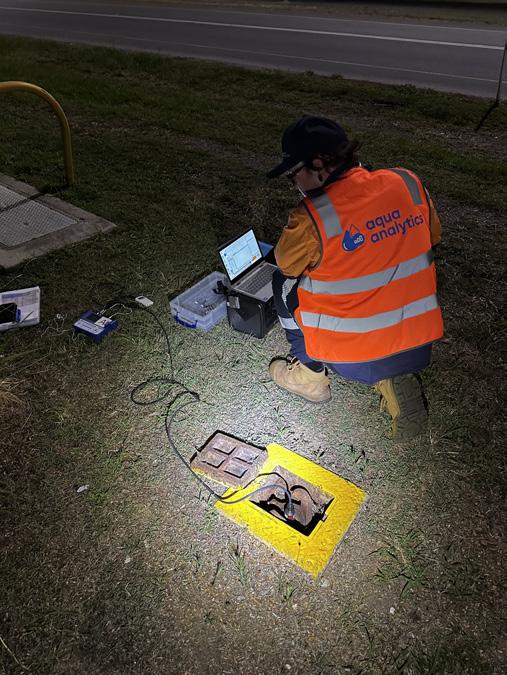
EXPERIENCE THE DIFFERENCE
Aqua Analytics, as the trusted partner for KenWave's Dynamic Response Imaging in the region, brings local teams and expertise to ensure the success of your pipeline condition assessment projects. The company’s proven track record demonstrates the value DRI delivers to water utilities, municipalities and industrial asset owners.

UTILITY • MAY 2024 WWW.UTILITYMAGAZINE.COM.AU 76 INSPECTION, CCTV & CONDITION ASSESSMENT | Sponsored editorial
To explore how Aqua Analytics can transform your pipeline management strategies or request a free consultation, visit www.aquaanalytics.com.au

Field S ervices
Smar t S olutions
Consulting
THE POWER OF WATER JETTING
Having the right equipment can make all the difference in the success of pipe maintenance. This article looks at how water jetting technology can both optimise operations and reduce the costs of maintaining these assets.
Pipe maintenance is not just about extending the lifespan of underground networks; it's about safeguarding public health, preserving the environment and enhancing quality of life. In the sewer and stormwater maintenance industry, there has been an increase in demand for custom made water jetting solutions and high-tech equipment.
TRENCHLESS PIPE REPAIRS EQUIPMENT LEADER
Trenchless sewer repair consists of repairing or replacing the existing pipeline without the need for extensive digging. Before work begins, a camera is sent down into the pipes to evaluate the extent of the damage and the best options for repair or drain cleaning. Using a water jetter to clean out the pipe from a distance avoids ripping up landscaping, sidewalks and underground systems. Getting the right equipment for it is the first step to optimising your costs on interventions. Enviroline Group explains that Innovation is part of the company’s DNA. The team is constantly pushing the boundaries of what's possible, striving to bring you the most advanced and revolutionary products on the market.
CUTTING-EDGE CCTV PIPE INSPECTION CAMERAS
The innovative IBOS robotic crawler cameras enable operators to conduct thorough inspections of pipes, and easy reporting. They can investigate anomalies in flow, examine pipe walls and liners, pinpoint joint issues and identify areas of leakage to facilitate repair planning and pipe lining.
HIGH-TECH NOZZLES FOR ROOT CUTTING
Roots are the main causes of blockages in pipes. Root cutting nozzles are specifically designed to cut through partial to full pipe obstructions. Enviroline has a wide range of high-tech jetter nozzles. With a vast inventory housed in the Western Sydney-based warehouse, the company ensures that your equipment is ready to roll when you are, and Enviroline’s efficient shipping network ensures next-day delivery across Australia.
WATER JETTING SOLUTIONS
When you engage with Enviroline Group, you're not just getting equipment; you're tapping into a wealth of industry expertise. The company’s knowledgeable staff boasts firsthand trade experience, ensuring that you receive advice that's both insightful and empathetic.
EFFICIENT PTO-DRIVEN TRUCK JETTING SYSTEMS
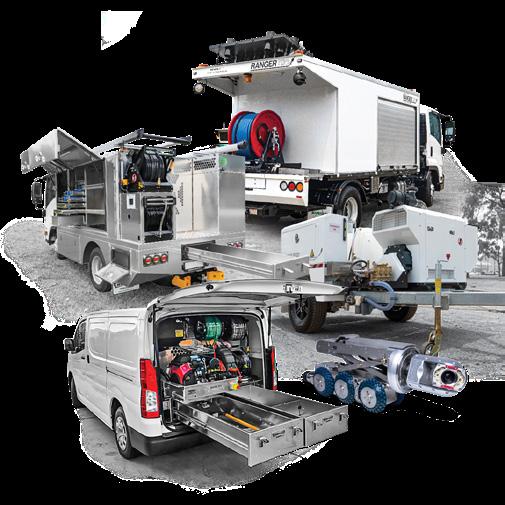
For large-scale pipe maintenance work, the best options are truck-mounted jetters. The jetter is incorporated into the truck body build, leaving ample space for storage for other tools and equipment. Enviroline’s PTO-driven truck jetters remove the need for another power source saving on fuel, weight, and extra maintenance cost. Truck-mounted jetters also often include luxuries such as remote control, hydraulic controlled hose reels, numerous engine protection and safety shut off features. The heavy-duty T100 PTO Truck will deliver a flow of 260lpm and pressure up to 2250psi, suitable for 100mm–1500mm pipes. This will tackle the worst of the blockages in large pipes.
HEAVY-DUTY JETTING TRAILERS
These water jetting units are designed primarily for water authorities and councils, to clear sewer and storm water lines up to 600mm in diameter. The main advantage is that they can easily be towed by a 4x4 ute or small truck. These units come with a range of performances available from 75–125 L/min and 2300–4000 PSI and are driven by a reliable HATZ turbo-charged four-cylinder engine.
FLEET SOLUTIONS
Enviroline has delivered a range of cutting-edge, highperformance jetting units to Councils, Water Authorities, Civil Contractors and Plumbers over the past 20 years into all states in Australia, NZ and various Pacific Islands.
Lately, Enviroline supplied six jetting trucks and seven jetting trailers to Urban Utilities, who delivers drinking water, recycled water and sewerage services to more than 1.4 million people in Southeast Queensland. They found the Enviroline T80 trucks and Ranger jetter trailers the best option to solve their pipe maintenance needs.
The team at Enviroline Group explained that its mission is crystal clear: to deliver cutting-edge, competitive solutions to the civil and municipal industries. Passion, excellence and unwavering commitment to innovation form the bedrock of the company’s ethos, propelling Enviroline Group towards its goal of becoming the preferred suppliers and market leaders.
For all your water jetting and pipe maintenance needs, trust Enviroline Group—where expertise meets excellence, every single time.
UTILITY • MAY 2024 WWW.UTILITYMAGAZINE.COM.AU 78 INSPECTION, CCTV & CONDITION ASSESSMENT |
For more information, visit www.enviroline.net.au
The Water Jetting and Pipe Maintenance Specialists
Fleet Solutions: Jetting Trucks, Vans, Trailers.









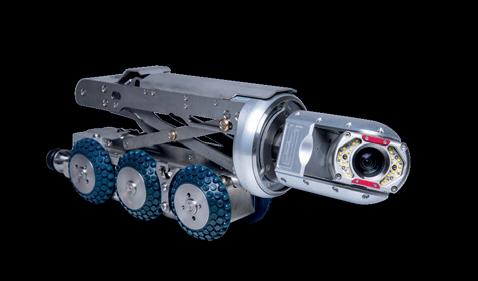
Whether you need a trailer fitted out for serious stormwater work, or a whole fleet of customised trucks for a state-wide Water Authority, Enviroline Group has the range, knowledge and services to deliver a solution tailored just for you.
From SA Water to Singleton Council to the Shire of Kojonup, we work with local, state and federal government authorities, water authorities and major civil contractors across Australia to provide expert advice, tailored commercial equipment, servicing, repairs, parts and accessories.

The water jetting specialists
T80 PTO Jetting Truck
Ranger R50-D Jetter Trailer
V20 Van Jetting Kit
1800 816 830 52 Vallance St, St Marys NSW 2760 enviroline.net.au
IBOS Camera Crawler
EST. 1972
T30 PTO Jetting Truck

UTILITY • MAY 2024 WWW.UTILITYMAGAZINE.COM.AU 80
TERRITORY GENERATION’S SECOND DARWIN-KATHERINE BESS PROJECT ENERGY STORAGE
POWER MOVE:
In July 2020, the Northern Territory Government released the Northern Territory Climate Change Response: Towards 2050 report, which laid out the impacts of climate change in the Territory and detailed the government’s plan to achieve net zero emissions by 2050. To establish the foundations required to deliver this goal of an enduring and effective climate change response, the Territory Government introduced the Darwin-Katherine Electricity System Plan.

UTILITY • MAY 2024 WWW.UTILITYMAGAZINE.COM.AU 81
ENERGY STORAGE
Northern Territory households and businesses continue to invest in solar power, with rooftop solar PV installations growing by an average of 45 per cent each year since 2010. While this is great news from a renewable energy perspective, the increase in solar energy in the grid does present a challenge to maintaining security and reliability in the Territory’s power system.
To make up for energy shortfalls when the sun isn’t shining, the Territory currently relies on provision of a gasfired spinning reserve – a solution that is both expensive and a big contributor to carbon emissions through the use of gas. The Territory Government has said that the connection of large-scale solar projects to the grid presents challenges for system security and reliability, and while the technologies do exist to effectively manage these challenges, investors are looking for cost efficient ways to do so in order to ensure the lowest possible energy prices for Territorians.
To help chart a course towards its goal of net zero emissions by 2050, the Territory Government released the Darwin-Katherine Electricity System Plan. The Darwin-Katherine area is a key focus for renewable energy uptake due to its population and climate. According to the plan, the DarwinKatherine Interconnected System (DKIS) provides electricity to 150,000 Territorians, including residential homes and a diverse range of small, medium and industrial-scale businesses.
A UNIQUE ENERGY SYSTEM
In 2021, about 88 per cent of energy was met by thermal generation. The generators connect to the electricity network, which transports the electricity to households and businesses. In 2021, approximately nine per cent of underlying energy was supplied by small-scale solar generation, and three per cent by large-scale solar generation.
The Darwin-Katherine electricity system is unique, and quite different from most other power systems in Australia. These unique challenges impact the suitability of some types of renewable energy generation. Some of the key factors that contribute to these challenges of renewable energy
generation and storage in DarwinKatherine include:
• It is a small standalone grid, delivering the equivalent of only one per cent of total energy generated in the National Electricity Market. Economies of scale are notoriously difficult to achieve.
• Due to geographic remoteness, the Darwin-Katherine electricity system is not interconnected with other regional networks, such as Alice Springs or Tennant Creek, meaning that fit-for-purpose, bespoke solutions are necessary.
• The operating environment is harsh and subject to weather volatility, particularly cyclones and monsoonal periods when the sun does not shine. Demand needs to be met despite the extreme weather, which can potentially also affect system security.
• Significant natural resource opportunities exist, including low-cost solar. However, there are current limitations with viably accessing alternative renewables (such as the wind, tidal, hydro, hydrogen and biofuels).
• There has been significant reform to the electricity market over the last decade, including structural separation of generation, networks and retail, and regulatory reform.
The Darwin-Katherine Electricity System Plan acknowledged that continuing reform will impact the deliverability of renewable energy goals, and noted the need to ensure that strategic policies and actions are complementary.
DELIVERING SOLUTIONS
To help address these challenges, one of the key deliverables detailed in the system plan was the 35MW Darwin-Katherine Big Battery Energy Storage System (DK BESS), to be delivered by Territory Generation at the Channel Island Power Station.
The $45 million DK BESS is designed to provide power system services, including spinning reserve, equivalent to a Frame 6B gas generator. 192 batteries, each weighing 3.5 tonnes, have been installed for the DK BESS. For pre-commissioning testing, a
temporary power supply was installed on eight Hitachi Energy modules – each comprising a bank of batteries, a set of inverters and a step-up transformer. The temporary power supply, in combination with an AC/DC power converter, charged and discharged the battery modules to test all their functions before being connected to the 11kV switch room.
With the construction and precommissioning phases now complete, the DK BESS is closer than ever to achieving full operation. Territory Generation is continuing to work with key stakeholders to begin rigorous testing, with power system modeling and connection agreement negotiations well underway. Full operation of the DK BESS is expected in 2024.
Territory Generation CEO, Gerhard Laubscher, said, “The successful installation of all batteries and progression to pre-commissioning is a significant step forward for the DK BESS.
“We recognise commissioning is a complex and time intensive process, and we are working closely with all stakeholders to support the fastest possible progression of these activities.
“The DK BESS is key to unlocking flexibility in our generation fleet. Once commissioned, it will be online continuously, helping to stabilise the impacts of solar and support the integration of more into the DarwinKatherine grid,” Mr Laubscher said.
The Territory Government has estimated that having the DK BESS online and available to reduce reliance on gas generation would result in cost savings of around $9.8 million annually, as well as eliminating approximately 58,000 tonnes of carbon emissions each year. The government also projected a payback period of five years from connection to the grid.
TWO IS BETTER THAN ONE
With the DK BESS successfully achieving key project milestones, Territory Generation recently announced that it is progressing works on a second large-scale BESS project for Darwin-Katherine, the DK BESS 2. Together, the two BESS projects are set to fulfill the Darwin-Katherine Electricity System Plan requirements for the installation of up to 105MW of
UTILITY • MAY 2024 WWW.UTILITYMAGAZINE.COM.AU 82
ENERGY STORAGE
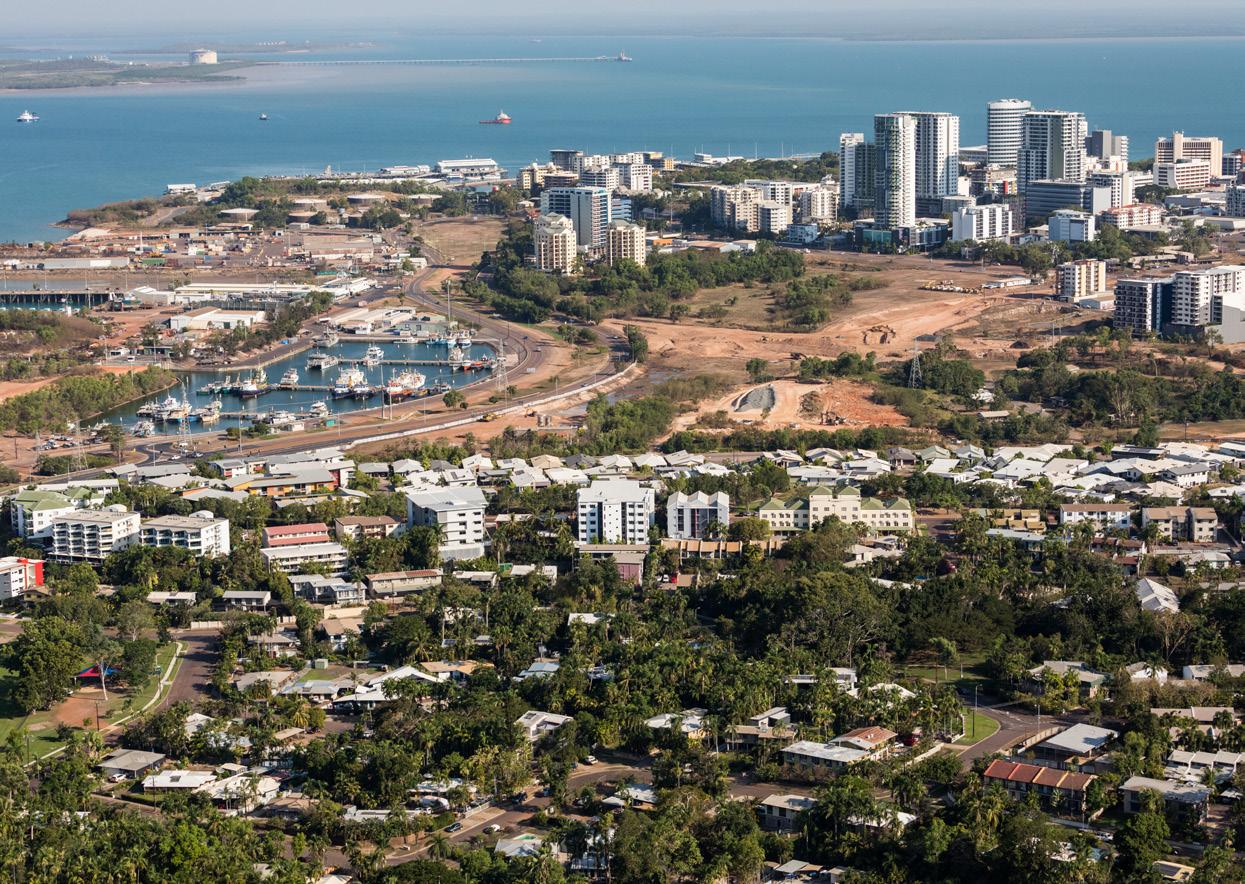
high-specification batteries, enabling further uptake of both small and largescale solar PV installation.
The DK BESS 2 will involve the deployment of large-scale batteries distributed across multiple locations throughout the DKIS. Unlike the original DK BESS, which has been built at one site, the DK BESS 2 battery system will be spread around the grid in order to further strengthen network resilience.
The distributed network of batteries is designed to assist in ensuring system security and enable more solar energy penetration by providing essential frequency and voltage control services
The DK BESS 2 will add to capability demonstrated by the first DK BESS.
Commissioning of the DK BESS 2 is targeted from 2026 onwards.
Northern Territory Chief Minister, Eva Lawler, said, “The DK BESS and DK BESS 2 are an important part of our transition to a renewable energy future.
“We are able to invest in our power grid because we own our assets like Territory Generation, Jacana, and Power and Water. By owning our assets, we can keep power prices low. Battery technology will play a significant role in our target of reaching 50 per cent renewable energy consumption by 2030.”
Northern Territory Minister for Renewables and Energy, Kate Worden, said, “The DK BESS 2 project will secure our energy supply for Territorians and stabilise our grid as we move towards integrating more renewable energy into our power use.
“As we move towards a future where renewable energy will play a greater part in our power supply, the DK BESS and DK BESS 2 projects will facilitate a major port of this change.”
The Expression of Interest assessment for the DK BESS 2 has been performed and is now closed,
with a shortlist of proponents selected for the next phase.
Territory Generation said it is currently investigating other renewable generation and long-term storage solutions that will work in collaboration with both DK BESS projects to further advance the government’s renewable energy targets.
Territory Generation CEO, Gerhard Laubscher, said, “Territory Generation’s battery energy storage system projects will play a critical role in advancing renewables in Darwin-Katherine and other power systems across the Northern Territory.
“Adding more battery energy storage systems to Territory Generation’s portfolio will not only enable more renewables and efficient generation dispatch throughout the energy transition, but also fosters the evolution of various technological innovations and further support grid resilience.”
UTILITY • MAY 2024 WWW.UTILITYMAGAZINE.COM.AU 83
ENERGY STORAGE
POWERING THE FUTURE:
NaNiCl BATTERIES REVOLUTIONISING
UTILITY MANAGEMENT
The transition to renewables is the largest transformation the NEM has undergone in recent history. As a result, Australian utilities are facing the mammoth challenge of keeping up with electricity demand while integrating new renewable energy sources into the grid. Here we discuss how advancements in battery technology can help navigate these challenges.

UTILITY • MAY 2024 WWW.UTILITYMAGAZINE.COM.AU 84
ENERGY STORAGE | Sponsored editorial
As Australia's energy landscape undergoes a profound transformation towards sustainability, utility companies are tasked with integrating renewable energy sources while ensuring reliable power delivery. In response to this industry change, Decon Corporation, a longstanding leader in the electrical and telecommunications industries, is navigating this transition with its innovative Smart Power Cell powered by Sodium-Metal Chloride (NaNiCl) batteries.
EMBRACING SUSTAINABILITY BEYOND INFRASTRUCTURE
With more than five decades of experience shaping Australia's electrical and telecommunications landscape with the manufacture and supply of innovative products and solutions, Decon is now channelling its expertise towards championing a cleaner future. The company’s commitment extends beyond providing reliable energy solutions; as an active member of the Clean Energy Council, Decon advocates for sustainable practices within the industry.
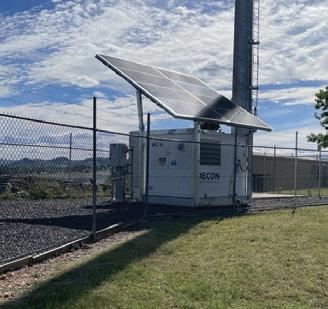
A MODULAR POWERHOUSE FOR CLEAN ENERGY INTEGRATION
At the core of Decon's commitment to clean energy lies the Smart Power Cell, a versatile and portable off-grid power system designed to seamlessly integrate NaNiCl batteries with renewable energy sources such as solar and wind. In scenarios where renewable resources are depleted or during extended outages, the Smart Power Cell seamlessly transitions to a
backup diesel generator, guaranteeing uninterrupted power supply.
The Smart Power Cell's exceptional performance is underpinned by the innovative NaNiCl batteries at its core. Unlike traditional lithium-ion batteries, NaNiCl batteries offer several key advantages that make them ideal for clean energy storage. These batteries are renowned for their enhanced safety features, as sodium metal is less prone to thermal runaway, mitigating the risk of overheating. Additionally, NaNiCl batteries boast a longer lifespan and can withstand a wider range of temperatures compared to lithium-ion counterparts, ensuring durability and reliability in diverse environmental conditions.
The Smart Power Cell's significance extends beyond its role in clean energy integration. It has been widely adopted by major telecommunication carriers for enhanced disaster resilience, with more than 80 units deployed nationwide at remote or disaster-prone telecommunication sites. These deployments ensure that in the event of a power outage or disaster scenario, local residents and emergency services personnel maintain vital communications – a factor often crucial in matters of life and death.
The deployment of Smart Power Cells at strategic telecommunication sites ensures that even during the most challenging circumstances, communication lines remain open. Whether it's coordinating rescue efforts during natural disasters or providing crucial updates to affected communities, the Smart Power Cell plays a pivotal role in ensuring that communication infrastructure remains operational when it matters most.
THE FUTURE IS AC: EXPANDING APPLICATIONS AND EMPOWERING PROGRESS
With the support of government initiative, Decon has also developed an AC version of the Smart Power Cell. This advancement broadens its potential applications; it has the potential to empower remote communities with off-grid power solutions, provide reliable
backup power for critical infrastructure, facilitate sustainability initiatives at events and festivals, and enable electric vehicle charging stations in remote areas.
The Smart Power Cell, epitomises a significant leap in energy storage technology. By embracing this innovative solution today, utility companies can not only meet their immediate needs but also secure their role in shaping a sustainable future for generations to come.
Recognising the unique requirements of utility companies, Decon prioritises collaboration. By working closely with partners, they have been able to develop customised Smart Power Cell configurations tailored to optimise energy management and enhance grid stability according to specific needs.
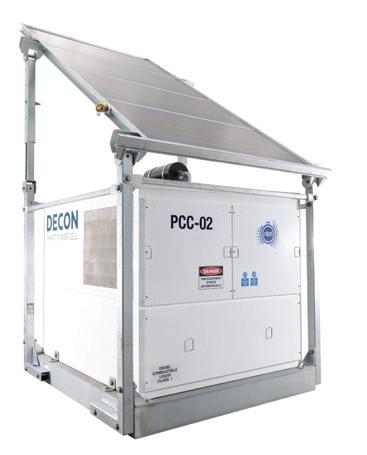

UTILITY • MAY 2024 WWW.UTILITYMAGAZINE.COM.AU 85
Sponsored editorial | ENERGY STORAGE For more information, visit www.deconcorp.com.au
STANTHORPE'S SMART WATER NETWORK: A BLUEPRINT FOR WATER SECURITY

In the heart of Australia's drought-prone landscape, Stanthorpe has faced its fair share of water woes. However, a groundbreaking initiative spearheaded by the Southern Downs Regional Council and Unitywater is changing the narrative.
What began as a response to the town's water supply crisis in 2020 has evolved into a pioneering smart water network that is not only safeguarding precious water resources but also saving both money and water for the community.
A GAME CHANGING STRATEGY
Since its installation in June 2024, the smart water network in Stanthorpe has been a game-changer. By leveraging a network of smart sensors and meters strategically placed throughout the town, more than 32 million litres of water have been saved, and more than $90,000 in costs have been avoided. These impressive numbers underscore the effectiveness of modern technology in addressing age-old challenges.
Rhett Duncan, Executive Manager Customer Delivery at Unitywater, emphasises the significance of this innovative approach.
“The smart water network enables real-time monitoring of water usage across four suburb-sized district metered
areas, and using the Takadu Central Event Management system we can combine communication and data analysis information together to quickly identify and address leaks,”
Mr Duncan said.
Unitywater and Detection Services Established the 4 District Metered Areas, installing flow meters and data loggers into SDRC water network. This was to enable the identification of any potential leaks quickly.
Volumetric flow meters use electromagnetic induction to measure liquid velocity at the entry point of each district metered area to capture the flow entering a suburb.
“This data is compared against actual customer consumption measured through smart meters at each property connection, with any difference indicating a potential leak that is then investigated.
“Being able to act quickly has helped us retain more than 13 Olympic swimming pools of precious water supplies within the local network and delivered big cost savings for the people of Stanthorpe.”
UTILITY • MAY 2024 WWW.UTILITYMAGAZINE.COM.AU 86 SMART METERS
SUCCESSFULLY DETECTING AND REPAIRING LEAKS
One of the standout success stories of the smart network is the rapid detection and repair of a significant leak on Minna Street.
Buried beneath layers of earth and worsened by blasted rock, the leak was losing approximately 20 litres per minute. Thanks to the network's vigilance, the leak was promptly repaired, potentially saving the affected Southern Downs Regional Council community up to $12,000 annually.
The benefits of the smart water network extend beyond leak detection and prevention. By harnessing the power of data transmitted via the network to a monitoring team at Unitywater, the council can proactively manage water resources round-the-clock. This real-time monitoring not only enhances the accuracy of water billing but also fosters community engagement in water-saving practices.
Every hour, data from the Stanthorpe water network is sent across the 5G network to a monitoring team based on the Sunshine Coast, who monitor it 24/7 and let Southern Downs Regional Council know when they’ve got a leak so they can fix it faster than ever before.
The introduction of this technology has delivered real benefits to the Southern Downs Regional Council, primarily the ability to immediately identify and investigate abnormally high flow events to determine if the source is a leak.
IMPROVING WATER SECURITY
This trial is a testament to Southern Downs Regional Council’s commitment to water security for residents, Granite Belt growers, and tourism operators in Stanthorpe and its surrounding villages. From a dire position in drought, Stanthorpe now has one of the smartest water networks in Australia with the ability to provide real-time water monitoring at both the customer and treatment plant levels, providing transparency and awareness to the community.
This comprehensive approach to water management is not only securing Stanthorpe's water future but also setting a precedent for sustainable water management practices across Australia. With its smart water network leading the way, Stanthorpe is proving that innovation and collaboration with Unitywater are the keys to overcoming water challenges of today.
Lessons from Stanthorpe's experience can inform future initiatives addressing water scarcity. By embracing technology, collaboration and data-driven insights, communities can build resilience and adaptability in the face of water supply uncertainty. Ultimately, the transformative power of innovation in water management offers hope for a sustainable future.
As the world grapples with the growing challenges around increased climate events, initiatives like the smart water network in Stanthorpe exemplify the power of innovation in addressing pressing environmental concerns. By harnessing the collective expertise of individuals, organisations, and governments, we can develop solutions that safeguard our most precious resources for generations to come.

UTILITY • MAY 2024 WWW.UTILITYMAGAZINE.COM.AU 87 SMART METERS
SMARTER LEAK DETECTION:

Barwon Water is trialling leak detection technology in Apollo Bay to improve customer experience, reduce wastage and ensure more efficient use of water. It’s part of a broader approach to ensure water security for its communities.
UTILITY • MAY 2024 WWW.UTILITYMAGAZINE.COM.AU 88
SMART METERS

SAVING APOLLO BAY’S WATER
UTILITY • MAY 2024 WWW.UTILITYMAGAZINE.COM.AU 89
SMART METERS
The Barwon Water Smart Networks project saw the installation of digital meters with integrated vibration sensors that simultaneously detect leaks on customer properties as well as in its own network.
The initial trial of 300 devices targeted the Marengo area of Apollo Bay with the aim of helping Barwon Water find and fix network leaks that would ordinarily go undetected.
WHY APOLLO BAY?
The Apollo Bay area was selected for the trial because it has the highest rate of water loss across the network, with 24 per cent of water lost before it reaches customers. An estimated 23 million litres can be saved annually across the entire Apollo Bay system.
Barwon Water Smart Networks Section Leader Travis Juffermans said that the water for the area is from the Barham River.
“During summer periods, the river flows reduce, after which we can no longer take water.” Mr Juffermans said.
“The population in Apollo Bay increases over the summer period due to increased visitors to the area. This puts more pressure on the water supply.”
Mr Juffermans also explained that the Apollo Bay area made for an interesting trial location because of its coastal, sandy soil, which means leaks are not visible on the surface.
PROJECT OUTCOMES
Narrowing in on leak location
Over the course of the trial, Barwon Water was able to greatly reduce the area that operators need to search when attempting to locate a leak, by providing accurate readings throughout the system.
“Prior to the trial, our operators would need to search through 55km of pipe to try and find a leak which often required night works and network shutdowns causing disruptions to our customers. With the vibration technology, we are shrinking that down to an area of 50m or less and avoiding unnecessary shutdowns and working at night.” Mr Juffermans said.
Analysis over time
Throughout the trial, Barwon Water was also able to locate three additional leaks that wouldn’t have been found otherwise. These were monitored to determine how quickly they were growing, and if other leaks were also occurring in the area.
While traditional leak audits represent a picture of leakage at a given point in time, the daily collection and analysis of vibration data provides a view of how network leakage is changing over time.
Operational efficiencies
Mr Juffermans said that the traditional methods of detecting leaks, such as water balance or District Metering Areas (DMA), can identify that leaks exist with a general zone, but further investigation is then required to locate the leak.
“The trial gave us the ability to accurately analyse leakage in a way that you just can’t do with traditional approaches.”
The vibration data collected by the digital meter shows patterns and trends over time that help provide a better understanding of the network's leakage. Using this insight will enable Barwon Water’s leak detection crews and repair crews to be deployed more effectively. This is valuable in cases where there are small leaks on a main that are not historically financially viable to fix using traditional approaches.
Tackling customer-side leaks
Gathered data enabled Barwon Water to identify properties with possible emerging leaks that were below the normal trigger threshold for continuous flow leak alerts.
The data also shows a trend change over time, providing greater detail than only flow-based information. This enables the utility to better understand customer leakage and proactively inform customers if they had a growing leak on their property.
“Continuous flow analysis is a proven method for identifying customer leaks. With the addition of vibration sensor data, it has allowed us to detect even smaller leaks and determine if the customer’s leak is changing” Mr Juffermans said.
The future role of data in leak detection
“The case for digital metering is strong, most utilities are currently working through moving into scaled deployments or full deployments.”
Mr Juffermans said that he believes the challenge for this technology going forward will be building analytical tools that are able to filter and analyse the data and automate prioritisation to maximise value from the data”.
“As the analytics improve, the benefit of deploying the technology more broadly will be greater.”


UTILITY • MAY 2024 WWW.UTILITYMAGAZINE.COM.AU 90 SMART METERS

SAVING THE DAY IN LEETON (AND THE BEER)

IDigital water meters play a critical role in protecting utilities when unexplained water loss occurs. On a recent occasion in Leeton, New South Wales, digital meters were also able to identify a huge leak causing a threat to one of the town’s greatest icons – its main street pub.
t was a bustling Saturday night at the Wade Hotel on the main street of Leeton, a town located in the Riverina region of New South Wales, Australia. During a routine keg change a staff member ventured down to the cellar and found the entire basement flooded up to knee height and water was surging in through a water seepage pipe.
Panic set in over the threat of the most un-Australian outcome in Leeton’s history – a pub with no beer! Luckily the compressors and equipment in the basement were installed on concrete shelves, which rested just above the water level, inches from disaster.
Upon investigation, it was found that the sump pump in the basement had been operating non-stop for 24 hours, emptying water, but it had now failed.
The cellar was designed with a 32mm pipe hole in the basement wall, which was designed to let natural ground
water seep into the basement to avoid build up behind the wall, which would cause structural damage. Normally after rainfall, this would be a trickle of groundwater, but tonight it was streaming in from behind the wall at full speed through that 32mm pipe.
This was definitely not normal, and since it hadn’t rained there could only be one explanation. This was a water leak, and a big one, which was now flooding the basement. With the failed sump pump, the basement was gradually filling up with water and would soon flood the pub, ruin the equipment, and potentially cause major structural damage to the iconic Wade Hotel. Perhaps worst of all, the pub staff couldn’t change the keg, cutting patrons off from their supply of liquid gold.
So the Leeton Shire Council water team set to work to search for the source of the leak – but where to start?
UTILITY • MAY 2024 WWW.UTILITYMAGAZINE.COM.AU 92 SMART METERS | Sponsored editorial

The pub has a digital water meter installed, so staff checked Taggle Systems Customer Portal, but no issues showed up at the property. This indicated it was highly likely a water main issue, especially with that amount of water. One of the main town reservoirs sits within 500 metres of the pub, and five different water mains all cross within 100m of the pub. There is also an irrigation main running down the main street right outside. Any of these could be the source of a major leak of this nature – but which one, and where to start looking?
Outside, above ground, everything was calm, there were no signs of water anywhere so council staff got to work. First, they checked all the stop valves pits for signs of water on the mains and irrigation lines, figuring that any burst would be obvious at one of the stop valves. However, after an exhaustive search nothing was found. They tested the water in the cellar for chlorine and found it chlorine-free, which meant that it was most likely the irrigation main. They isolated the main street irrigation main but water kept flowing in as strong as ever.
After an exhaustive effort over five hours, the leak remained elusive. In desperation the council backhoe driver offered to start digging, but even then, he needed to know where to start digging.
Luckily, the sump pump in the pub was able to be restarted and keep up with the inflow, allowing the kegs to be changed. The council team were able to retreat to sleep and wait for Monday to restart the search, with additional leak detection equipment being organised.
Come Monday morning there was still no indication of any surface water, and the mystery of the huge leak remained unsolved. The backhoe driver was told to get ready to dig.
Digging up the streets to find and fix a water main leak could cost anywhere between $15,000 and $100,000, depending on the size and location of the leak, and how many “false digs” would be required.
Back at the office, staff logged into Taggle’s Aqualus Water system to review if the digital water meter network could share any insights. From the residential and commercial leak report it was immediately obvious that a nearby property had a major leak of over 2000 litres per hour! This was not a mains leak after all, but a huge leak at a commercial property on their incoming service line.
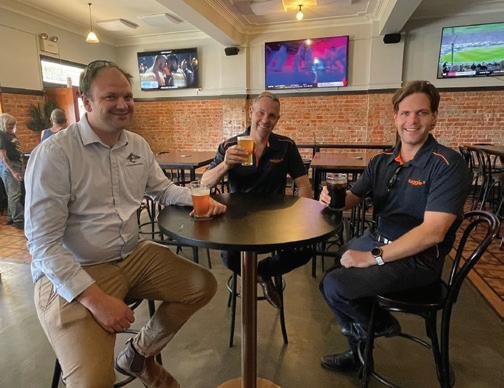
The team went directly to site, and equipped with acoustic leak detection tools, they found the leak was under the property car park. Over 2000 litres per hour was gushing underground down the rock sheet, and straight to the pub basement wall, where it found the seep hole and rushed in.
The property owner also noted that he had just received a leak notification SMS from the system, so he was happy to see council there to help fix it.
The team immediately isolated the property, and stopped the water flow, and then with the agreement of the owners, the team went to work, and dug up the car park to fix the leak.
Crisis averted, and the beer was saved!
Without digital water meters the leak may not have been found for some time, putting extreme pressure on the sump pump in the basement and putting the precious beer at risk. The leak was quantified at 166,770 litres total over three and a half days. Had it not been found so quickly, that amount of water would have led to infrastructure and equipment damage within the pub before too long.
Gerard Simms, Information Technology Manager at Leeton Shire Council, noted that when installing the digital water meters in Leeton, they had many examples where the data they received was able to be used to solve many problems, and save costs across the network.
But, he added, “I never thought our digital water meters would also save the beer! Cheers to that Taggle!”

UTILITY • MAY 2024 WWW.UTILITYMAGAZINE.COM.AU 93 Sponsored editorial | SMART METERS
CREATING THE ULTIMATE AVK VALVE SOLUTION
Looking for a valve solution that perfectly fits your needs? Look no further! AVK Australia is excited to share its suite of value-add offerings under the new PLUS Solution range banner.


To explore and build your Ultimate Valve Solution with PLUS value-added options, visit one of AVK’s solution stations at the AVK Australia stand (J13) at OzWater in Melbourne from April 30 to May 2.
At Ozwater, look for the large AVK sign that says, 'Build your customised valve solution here'. AVK’s product experts will guide visitors through the process of creating a valve solution that is customised to meet their specific needs.
AVK offers 16 different options for user applications, including various gate/seat types, actuation methods, gearboxes, extension spindles and materials. They also offer coatings, extended warranties, gland flange options and more.
AVK also offers a variety of material options to meet specific application needs. Options include stainless steel 431 or 316, Duplex, and Inconel for extreme conditions. Additionally, AVK has in-house FBE coating capabilities that allow us to control coating thickness according to individual requirements. Valve solutions come in a wide range of sizes, from DN50-2000++ and in pressure ratings from PN10-PN40, covering multiple connection types.
Ozwater visitors to the AVK stand will also have the opportunity to view the Belzona coating, extension spindle, actuation, and other PLUS options on the display. Additionally, the large DN600 metal seated gate valve will showcase some PLUS options, an educational experience and great photo opportunities.
Customers can book personalised tours at Ozwater to see the new products on offer, including the Recoil Check valve. This valve is a detailed cut-away, so you can visually see its many features.

UTILITY • MAY 2024 WWW.UTILITYMAGAZINE.COM.AU 94 EQUIPMENT | Sponsored editorial
If you’d like to book a catch up with the AVK team at Ozwater, contact marketing@avkau.com.au
S E R I E S 7 5 6
B U T T E R F L Y V A L V E
S U I T A B L E F O R
D R I N K I N G W A T E R
R o b u s t c o n s t r u c t i o n w i t h
d r i n k i n g w a t e r a p p r o v e d
E P D M s e a l , I P 6 8 g e a r b o x
D N 1 5 0 - 1 2 0 0 P N 1 6
O p t i o n s : E x t e n s i o n s p i n d l e s L o c k i n g d e v i c e P L U S m o r e


NEW PRODUCTS STAND J13




DISCOVER OUR EXTENSIVE RANGE OF HIGH-QUALITY PRODUCTS AT OZWATER #ASKAVK
Optimising small-volume CHEMICAL HANDLING

In today’s fast-paced industrial environment, the storage and handling of chemicals demand innovative solutions that ensure safety, efficiency, and environmental protection. Polymaster’s Enclosed Intermediate Bulk Containers Bund represents a significant leap forward in addressing these needs, particularly for businesses involved in water treatment and chemical handling in small volumes.
The challenges of chemical storage and dispensing are multifaceted, ranging from safety and environmental risks to operational inefficiencies. Traditional methods often fall short in addressing these issues comprehensively.
However, Polymaster’s Enclosed Intermediate Bulk Containers (IBC) Bund, constructed from high-grade polyethylene and designed with weather-resistant, purposebuilt enclosures, offers a revolutionary solution.
Jason Egan, National Sales Manager – Engineered Solutions at Polymaster, said the Enclosed IBC Bund offers a number of technological advancements and benefits for large business owners and civil engineers.
“Our Enclosed IBC Bund is specifically designed to tackle the complex issues businesses face with chemical storage and dispensing. Its all-weather polyethylene construction not only ensures durability but also addresses the critical aspect of safety by preventing chemical spills and unauthorized access,” Mr Egan said.
The product’s design facilitates easy forklift movement, simple connection to a 250 litre per day tank, and eliminates OH&S issues associated with IBC handling, thus enhancing operational efficiency.
One of the key features of the Enclosed IBC Bund are its rainwater-resistant doors, which hold chemical spray inside and prevent rainwater ingress. This design aspect is crucial for maintaining the purity of stored chemicals and preventing environmental contamination. Additionally, the bund’s lockable doors and viewing windows ensure security while allowing easy monitoring of chemical levels.
“Our product can accommodate a fully customised dosing system or an off-the-shelf dispensing kit, ensuring it meets the specific needs of our customers,” Mr Bund said.
“This adaptability, combined with features like venting on two sides, a vent and low-level alarm, and a continuous chemical dosing capability with a 250 litre per day tank, makes it an essential tool for modern businesses.”
Safety standards are a paramount concern, and the Polymaster Enclosed IBC Bund exceeds AS3780-2008 requirements, offering peace of mind to businesses regarding compliance and safety. The ease of installation, with wide-opening doors for forklift access, further adds to its appeal, simplifying the process of chemical handling.
Polymaster is committed to delivering solutions that not only enhance operational efficiency but also safeguard the environment and human health. The Enclosed IBC Bund is a testament to this commitment, offering a secure, efficient, and environmentally friendly solution for chemical storage and dispensing.
Businesses seeking to optimise their chemical handling processes while adhering to safety and environmental standards are encouraged to explore the benefits of the Polymaster Enclosed IBC Bund. For more information and to discover how this innovative solution can be integrated into your operations, visit the Polymaster Enclosed IBC Bund website.
UTILITY • MAY 2024 WWW.UTILITYMAGAZINE.COM.AU 96
For more information on Polymaster’s Enclosed IBC Bund and how it can assist your business, head to www.polymaster.com.au/enclosed-ibc-bund
WITH
ENCLOSED IBC BUND, BUSINESSES CAN TAKE A SIGNIFICANT STEP TOWARDS A SAFER, MORE EFFICIENT, AND ENVIRONMENTALLY RESPONSIBLE INDUSTRIAL LANDSCAPE. EQUIPMENT | Sponsored editorial
POLYMASTER’S

Discover Polymaster’s Advanced
Solutions for Small-Volume Chemical Handling
TACKLING CHALLENGES DURING WASTEWATER PRESSURE MAIN REALIGNMENT

Kwik-ZIP® HDXT-103 spacers were installed to facilitate the slip-lining of a MSCL Wastewater pressure main into a RC Jacking pipe running under a rail line for the Gosnells Main Pumping Station Wastewater Pressure Main Realignment project.
Rob Carr Pty Ltd was tasked with slip-lining the wastewater pressure main at the Gosnells Pumping station. In order to facilitate this project, the team employed the use of Kwik-ZIP® HDXT-103 spacers to speed up installation and extend the life of the new pipe.
WHY USE SPACERS?
Slip lining is a pipe refurbishment method that uses trenchless technology to push a new pipe through the existing pipe. The space between these two pipes is then grouted to secure the new pipe and increase its resilience to external hydrostatic loads. Spacers can be used during this process to protect the carrier pipe and to make installation easier. In some instances and dependent on the pipe materials being used spacers also assist to mitigate against corrosion.
The Gosnells Main Pumping Station Wastewater Pressure Main Realignment project opted for Kwik-ZIP® HDXT-103 spacers to facilitate the slip-lining of a MSCL Wastewater pressure main into a RC Jacking pipe running under a rail line, and the spacers’ simple and efficient installation process does not require any special tools nor is there any requirement to pre-wrap the pipe.
Marie Piette, Project Manager – Rob Carr Pty Ltd said that “The MSCL pipes insertion is making good progress despite a challenging environment, with production efficiency notably enhanced by the simplicity of installation of the Kwik-Zip spacers.”
A SEAMLESS INSTALLATION
As the new pipe is pushed into the existing pipe, there is a risk that abrasion can cause damage to the new pipe,
however, spacers help prevent this damage by creating clearance between these two pipes.
The runners on kwik-ZIP spacers also have a very low coefficient of friction, which facilitates a quick and easy insertion.
Integrated rubber grip pads under collars also prevent slippage and help to fix the pipe in position.
SHARING THE LOAD
Kwik-ZIP® spacers are designed with a load sharing suspension system that allows heavy loads to be shared across multiple runners. This reduces point loading and increases the overall load capacity of the spacer, which in turn can also increase the lifespan of the new pipe.
This system also has a suspension and dampening effect, which reduces the transfer of potentially damaging vibration and movement from the existing pipe to the new pipe.
All Kwik-ZIP® spacers are designed to meet the requirements of WSAA Product Spec # 324 (Casing Spacers), and the company’s large range of spacers caters for a wide range of ID / OD combinations, which provides flexibility to deal with project alterations.
For further information on kwik-ZIP® products and to discuss your specific project requirements please contact us at sales@kwikzip.com
UTILITY • MAY 2024 WWW.UTILITYMAGAZINE.COM.AU 98
EQUIPMENT | Sponsored editorial
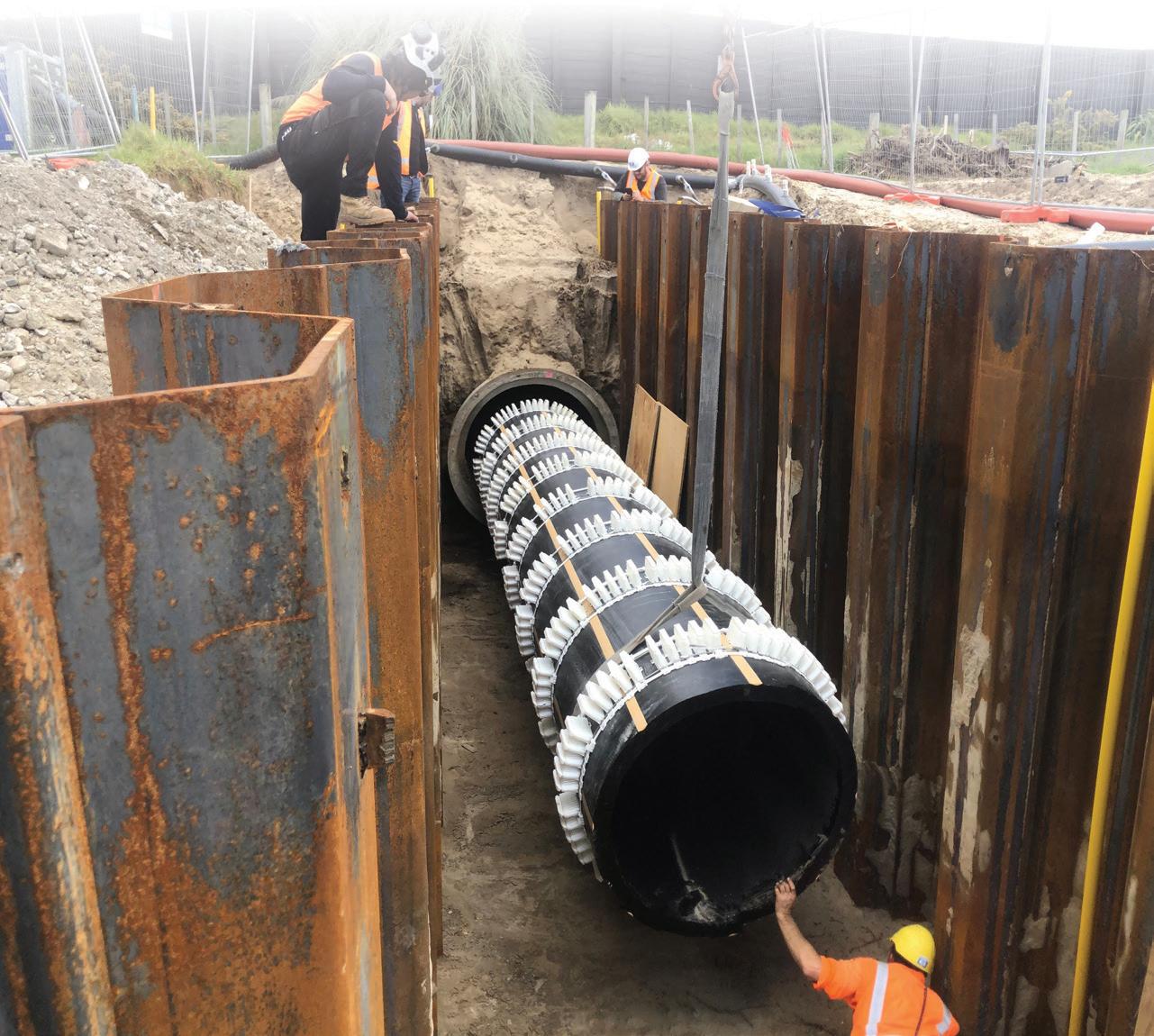

Is your pipe spacer compliant? Call us for details on ordering P (08) 9725 4678 sales@kwikzip.com www.kwikzip.com kwik-ZIP casing spacers successfully appraised by WSAA HDX and HDXT KWIK-ZIP’S HDX & HDXT CASING SPACERS COMPLY WITH WSAA PRODUCT SPEC #324 - CASING SPACERS; REFER WSAA PRODUCT APPRAISAL REPORT #1523
HDD TOOLING CHANGING THE GAME

Horizontal directional drilling (HDD) is a vigorous process that constantly changes and adapts to suit a range of applications across utilities and infrastructure. Operators looking to get the most from their equipment need to partner with suppliers that offer the best in tooling and back-up support.
Selecting the right HDD tooling is a critical step in the HDD process, with incorrect choices costing valuable time and increasing the likelihood of errors and project delays.
From drill rods and connection options, to housing, vise jaws and rod wipers – contractors that want to secure the best results for their projects ensure they employ the best equipment on the market.
Jobs change and sometimes the unexpected happens. At such times, contractors need tooling to help them adapt immediately.
THE LATEST IN HDD TOOLING
In line with its commitment to providing customers with the latest innovations in HDD equipment, Vermeer’s Ultra X3
drilling system is a unique, non-torqued spline connection system, offering compatibility with a wide range of pilot bit and pullback configurations.
The needs of tomorrow’s job sites are quickly evolving, the need to do more with less. Vermeer’s Ultra X3 drilling system’s interchangeable pilot and pullback tooling puts it miles ahead of the competition. The system has the ability to ream directly off the transmitter housing and can eliminate the expense of starter rods and adapters in certain applications.
Specifically designed for utility-sized rigs digging in most ground conditions, the drilling system improves the operator’s ability to move from one drill to another and maintain familiarity with the HDD tooling.
UTILITY • MAY 2024 WWW.UTILITYMAGAZINE.COM.AU 100 EQUIPMENT | Sponsored editorial


The Ultra X3 has a strong spline connection capable of handling the torque of reaming diameters up to ten inches (25 cm) directly off the transmitter housing in most conditions. This versatile housing unit comes in three sizes and is available for rigs up to 40,000 pounds (18,143kg).
The Ultra X3 Drilling System reduces the size of the exit pit required for jobs – thus removing the time required to dig an exit pit reducing disruption and rehabilitation of exit pits – optimising jobsite efficiency and further adding to its ingenuity. Since the Ultra X3 doesn’t require the housing be removed for most pullbacks, HDD crews can change over from pilot to pullback in a smaller space with less repetitive lifting. No specialist tooling required, simply remove two high capacity dowl pins and change the tooling.
EXPERTS IN TOOLING
Offering in-depth knowledge and expertise, Vermeer HDD tooling specialists are available at local dealerships and can give customers the lowdown on what’s going on with their machines, the ground conditions, their mud mix or the tooling they need to complete the next job.
It is important to the company that the parts and pieces of HDD tooling produced meet high standards. As such, Vermeer is one of the only manufacturers in the industry to invest in not only building its own metallurgy lab but also staffing it with experienced metallurgists.
Vermeer Australia prides itself on its informed and experienced team of experts, and its tooling specialists are no exception, with a focus on tooling and a commitment to working with customers to help them select the most suitable tooling for ground conditions, drill size and type, and other considerations.
UTILITY • MAY 2024 WWW.UTILITYMAGAZINE.COM.AU 101 Sponsored editorial | EQUIPMENT
For more information on Vermeer products and services, call 1300 VERMEER or visit www.vermeeraustralia.com.au
Centraliser technology plays a vital role in ensuring successful trenchless installations. However, traditional casing spacers have often held water and wastewater projects back from achieving optimal efficiency and reliability.
Riteline Centralisers, and its parent company OptionX Group, set out to change that by creating centralisers that provide unparalleled support to the carrier pipe.
OptionX Group CEO and Founder of Edge Underground, Stuart Harrison, said it has been a project of collaboration with the industry.
“Riteline Centralisers have been developed using real-world field data and feedback. The end result is a product that addresses long standing challenges within the industry and meets the unique demands of horizontal drilling projects.”
ENDORSED BY INDUSTRY
In late 2023, Riteline was successfully appraised by the Water Services Association of Australia (WSAA), marking a significant moment for the sector.
“Contractors and operators can confidently use Riteline Centralisers on their projects, knowing they have been through the necessary tests and third-party analysis,” Mr Harrison said.
“The WSAA appraisal serves as a benchmark for quality within the industry. It signifies that Riteline Centralisers have met the highest strength, reliability, and quality assurance standards.”
Riteline Centralisers offer exceptional versatility, accommodating pipes ranging from 100mm in diameter, with no upper limit. The ability to make incremental adjustments on site eliminates the need to purchase specific sizes, saving time and reducing stock wastage.

“As each centraliser is individually attached to the pipe, the risk of catastrophic failure is reduced,” Mr Harrison said.
“Traditional centralisers that surround the pipe can fail when they snag on an obstacle in the bore, which can cause an entire ring of centralisers to move, compromising the installation.”
COMPREHENSIVE TRENCHLESS SOLUTIONS
Riteline Centralisers can be used for all pipe materials, including steel, ductile iron, GRP, FRP, concrete, PVC and PE for pressure and non-pressure pipelines. The Flex Series is exclusively designed for grouted applications, whereas the Rigid Series suits both grouted and ungrouted installations and incorporates supports that provide a high load-bearing capacity.
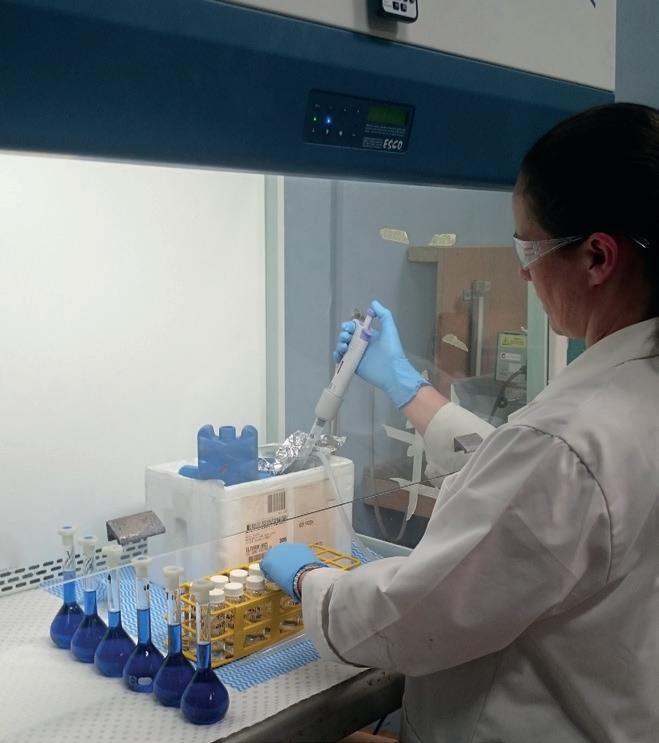

UTILITY • MAY 2024 WWW.UTILITYMAGAZINE.COM.AU 102
EQUIPMENT | Sponsored editorial
Analysis. Optimisation. Solutions. Find out more at www.researchlab.com.au Research Laboratory Services (RLS) provides highly advanced, specialist laboratory and consulting support services to water authorities and industry. The practical solutions we propose are proven in our Melbourne laboratory through scalable application studies and in-field pilot work. RLS provides the link between universities (theoretical evaluations), commercial laboratories (data generation) and consulting engineering firms (design). For more information visit riteline.com.au
INNOVATIVE CENTRALISERS ELEVATE INDUSTRY STANDARDS



WHEN ACCURACY MATTERS



optionxgroup.com.au CREATING X-FACTOR OPTIONS FOR GROUNDBREAKING SUCCESS 1300 522 533 | info@optionxgroup.com.au | optionxgroup.com.au PRECISION PERFECTED – CHOICES EXPANDED DISCOVER THE SUPERIOR ALTERNATIVE TO CENTRALISERS AND CASING SPACERS YOU’VE BEEN WAITING FOR – RITELINE. After nearly a decade of development, Riteline offers a game-changing solution that YOUR TRUSTED WSAA APPRAISED OPTION FOR ENSURING YOUR PRODUCT PIPE FINISHES ON THE RIGHT LINE! w. riteline.com.au 2023ASTT NEWTECHNOLOGY AWARDFINALIST WSAA Appraisal Details: PA Number: PA 2314 Product category: Casing Spacers Standard: WSA PS 324 Casing Spacers Hundreds of thousands of units successfully installed 100% AUSTRALIAN MADE, DESIGNED, OWNED, & MANUFACTURED Nine years of development and in-field testing
Edge Underground is a precision microtunnelling contractor that operates in Australia and the USA. With a focus on innovative technology and expertise, Edge Underground designs and enhances the performance of trenchless equipment. Full factory backing here in Australia means solutions can be created when they’re needed most. MICROTUNNELLING • PIPE JACKING • THRUST BORING LASER TUNNEL BORING • BOX CULVERT JACKING • CANOPY TUBES EXCLUSIVE AUSTRALIAN OPERATOR OF THE AWARD-WINNING, INDUSTRY-LEADING, ADAPTX TECHNOLOGY!
DURABLE DRAINAGE SYSTEMS FOR UTILITY DEMANDS
hen it comes to surface water drainage, robust and adaptable solutions are imperative for minimising the risk of infrastructure damage or failure.
Unlike traditional grated systems, Swarm Aqua® offers a seamless blend of strength and functionality without compromising on aesthetics. Its versatility allows for installation in various locations, making it a go-to solution for diverse terrain and load requirements.
TRIED AND TESTED
Swarm Aqua® is a proven product of choice for distribution yards, which are frequented by heavy-duty vehicles. In one particular project, simplicity was the key driving factor behind the decision to implement Swarm Aqua® in lieu of conventional systems.
With a singular size and type across all areas, the project minimised disruption to ongoing operations while eliminating the hassle of deciphering complex assembly instructions. The system's 'push to connect' mechanism also removes the need for intricate fixing methods and on-site assembly.
STRENGTH AND VERSATILITY
Featuring a lightweight yet durable design, Swarm Aqua® offers unparalleled strength and resilience. Swarm Aqua® channels are designed to be installed within a concrete surround and completed at surface level with a range of finishes. When installed in concrete, Swarm Aqua® channels can cater for loadings of up to G900kN. For block paving and asphalt installations, Swarm Aqua® is rated for up to E400kN loading. Size options

range from 150mm to 375mm wide, with a choice of iron top or steel slot.
The system’s drainage channels are suitable for any application and surface finish from a residential driveway through to a major distribution centre. By integrating Swarm Aqua®, companies can ensure long-term durability, minimise disruptions to operations and mitigate the risk of losses associated with infrastructure damage. Visit
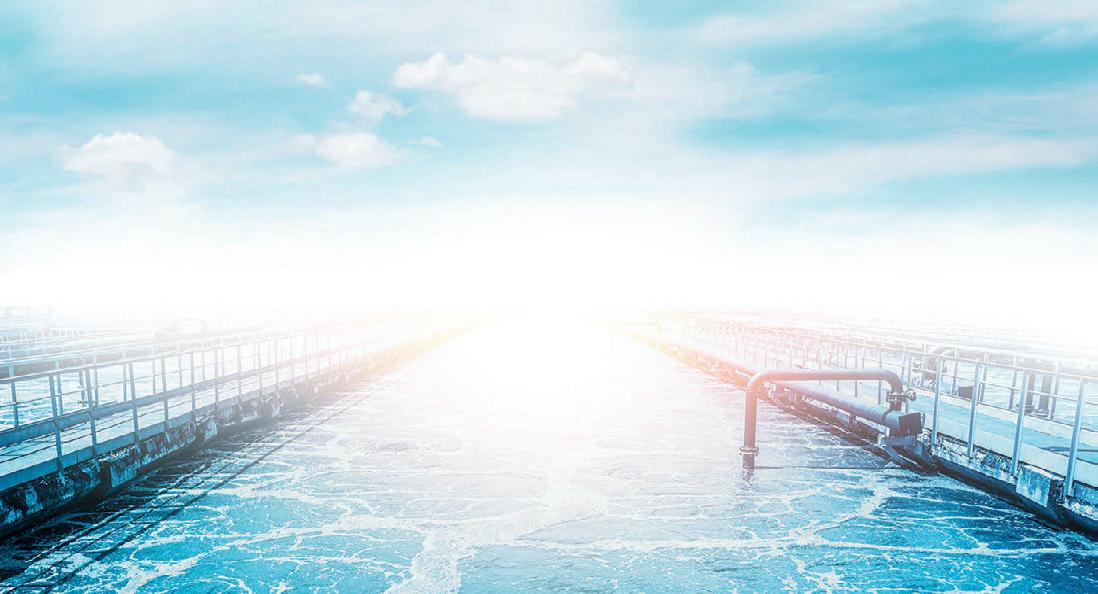


UTILITY • MAY 2024 WWW.UTILITYMAGAZINE.COM.AU 104 EQUIPMENT | Sponsored editorial
Aerzen Australia Pty Ltd. Email: sales-au@aerzen.com Phone: +61397087702 www.aerzen.com/wastewater How efficient is your aeration? Up to 30 % efficiency increase Up to 40 % CO2 reduction Less than 2 years amortisation Performance³ - The new generation The innovative Roots, Screw and Turbo Blowers Visit us at OzWater‘24 Stand C31 W
ejco.com/global or email au.info@ejco.com to find out more


Visit ejco.com to learn more about the innovative products by EJ. QLD | 07 3216 5000 NSW | 02 9757 3862 VIC | 03 9792 5144 WA | 08 9209 2930 au.info@ejco.com The innovative Swarm Aqua drainage system direct from the UK and available soon at EJ around the Asia Pacific. Effective and durable drainage systems that will also save you time and money (less reo & less concrete) on the installation.
When is HDD a better option than open cut installation?
When it comes to the installation of underground assets, such as pipelines or conduits, utilities have a range of options they can choose from.
Open-cut installation methods, involving the excavation of long trenches, were once the standard. However, Horizontal Directional Drilling (HDD) has emerged as a superior alternative in some cases, one that offers compelling advantages in numerous situations.
Open cut pipe and conduit installation is the more traditional installation method, dating all the way back to the 1800s. Trenchless technology and HDD is a much more recent innovation, emerging as a new and exciting option in the 1970s.
Both offer a range of benefits, and for any pipe or conduit installation, project owners should weigh the pros and cons for each before locking in a decision.
Let's examine when HDD shines over traditional techniques.
COST CONSIDERATIONS
While at first glance, HDD may seem to be a higher cost option, it often becomes a more cost-effective solution overall as it can lead to:
• Reduced labour and remediation: HDD minimises the need for extensive excavation, material disposal and backfilling, leading to lower labour, plant and material expenses. It also results in far less surface disruption and therefore less remediation effort.
• Social costs: Open-cut methods can cause substantial inconveniences like traffic disruptions, business closures, noise and dust pollution. HDD greatly reduces these social costs, adding to its overall cost-effectiveness.
SPEED OF INSTALLATION
In many cases, HDD significantly outpaces open-cut methods in terms of completion time. This is particularly true when laying utilities under obstacles such as highways, railways or bodies of water like rivers, lakes or wetlands. HDD can also go deep without the need for complex trench protection and shoring. With HDD, by drilling under the obstacle, project managers can bypass these challenging situations saving valuable time and resources.
DISTANCE CONSIDERATIONS
Over long distances, open cut can be a more cost-effective installation method – but if the route is in a congested urban environment, or the path crosses numerous other buried assets with limited available space, HDD is often the better option. As mentioned, HDD can go deep under assets or no-go zones without disruption so it's important to note that
the bottom-line cost of an installation isn’t the only – or even the most important – factor to be considered when weighing up the options.
ENVIRONMENTAL IMPACT
HDD stands out as the environmentally responsible choice for:
• Minimal surface disruption: HDD disturbs minimal topsoil and vegetation compared to open cut, leading to less ecological impacts.
• Preserved landscapes: HDD’s ability to navigate beneath sensitive areas protects rivers, wetlands, heritage, and other valuable landscapes that would otherwise be damaged by open-cut trenching.
GROUND CONDITIONS
The type of soil and underlying geology can significantly influence the choice between methods.
• Challenging soils: Rock terrain or unstable soils can make open-cut extremely difficult or in some cases, impossible. HDD shines in these conditions, allowing drilling through hard rock using specialised tooling and stabilising ground formations with the use of specific biodegradable drilling fluid designs.
• Optioneering: By researching the options early and engaging subject matter experts, asset owners and project managers can easily avoid many of the pitfalls encountered when installing pipelines and conduits in complex environments. Knowing the capabilities of HDD, such as depth of cover required or presence of rock and water before tendering works, can make all the difference to delivering a project on time and within budget.
CONCLUSION
HDD proves to be a superior option over open-cut installation of pipelines and conduits in a wide range of scenarios. While it’s not a universal solution, HDD’s advantages in cost-efficiency, speed, environmental friendliness and its adaptability to different ground conditions make it a compelling choice.
As projects prioritise sustainability, minimal disruption and cost effectiveness, HDD becomes an increasingly attractive solution for asset owners and modern utility installation.
Important Note: The best installation method always depends on a thorough assessment of your project-specific requirements, local conditions and current regulations. But in general, installing pipes and conduits in busy urban environments; or when multiple environmental features are to be avoided and speed is critical; HDD will provide significant benefits
About the expert, Anthony Doherty
Widely regarded as an industry expert, Anthony began drilling in 1994, and has overseen HDD installations since the technology first arrived in Australia. Of particular note, Anthony was the first person to undertake the HDD installation of polyethylene pipeline for the Australian water industry in 1995. With his extensive history and experience in the Australian HDD industry, Anthony has used his knowledge to develop several innovative patents for equipment that are still in use today. Anthony founded AHD Trenchless in 2009, and since that time he has built the company into an undisputed leader of HDD technology in Australia.
UTILITY • MAY 2024 WWW.UTILITYMAGAZINE.COM.AU
106
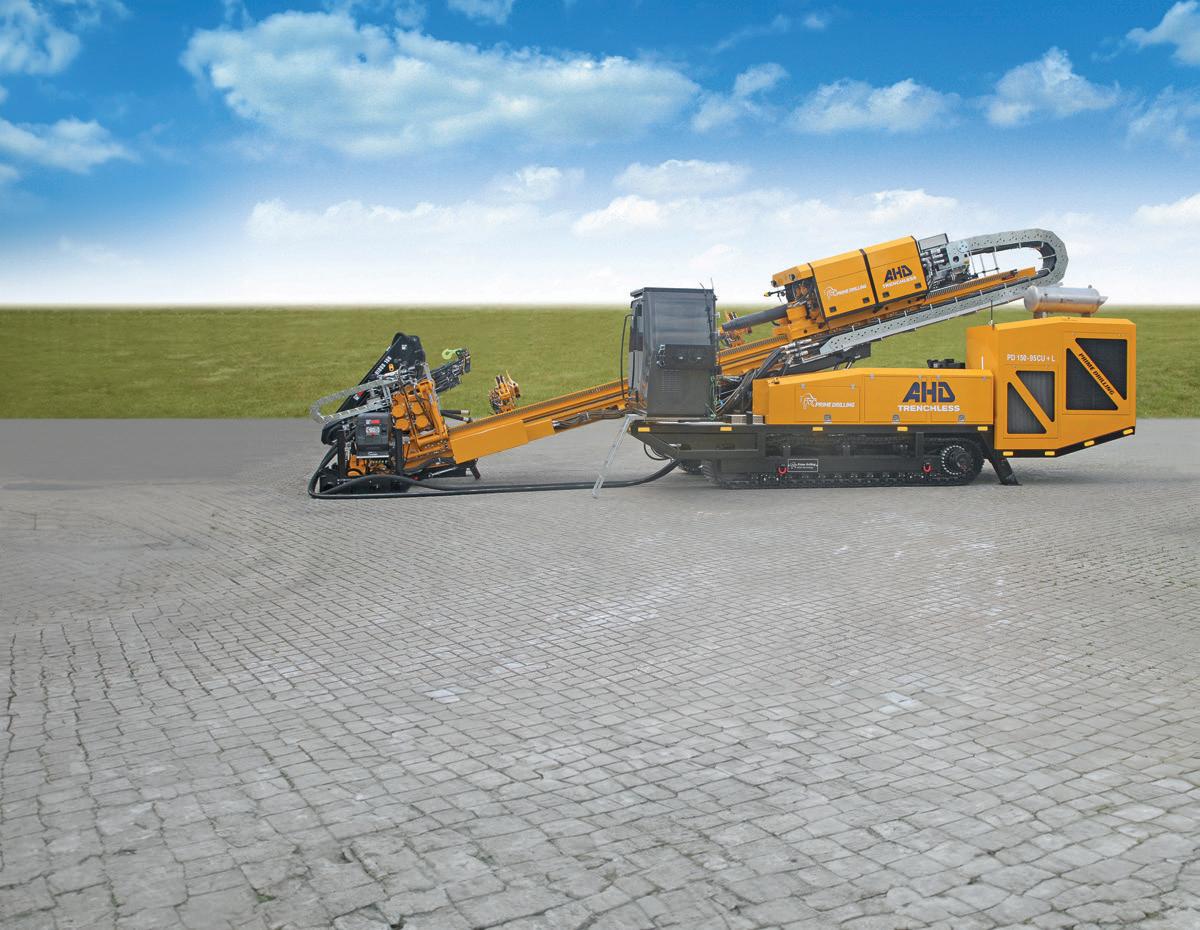
For accurate, sustainable and efficient pipe and well installation
Horizontal directional drilling (HDD) is the least disruptive method of pipeline installation for the utility sector.
It’s a better whole-of-life cost installation method with a minimal footprint to protect the surrounding environment. When your Asset needs to go under a river, highway or rail-line, AHD have got you covered.
AHD Trenchless is Australia’s most experienced HDD contractor –visit www.ahdtrenchless.com.au to learn how we can help you, or call 0418 399 062.
EDITORIAL SCHEDULE & ADVERTISERS INDEX
AUGUST 2024
EVENT DISTRIBUTION
IRRIGATION AUSTRALIA CONFERENCE AND EXHIBITION
MAJOR FEATURES
WATER NETWORKS
ASSET MANAGEMENT
SMART GRIDS
GAS PIPELINES
NOVEMBER 2024
EVENT DISTRIBUTION
WIOA NSW ALL ENERGY 2024
MAJOR FEATURES
WATER MANAGEMENT
RENEWABLES
RETAIL, BILLING & CRM CUSTOMER ADVOCACY
FEBRUARY 2025
EVENT DISTRIBUTION
WIOA VIC WIOA SA
MAJOR FEATURES
WATER OPERATIONS
CYBER SECURITY
SOLAR
ENERGY NETWORKS
MAY 2025
EVENT DISTRIBUTION
SALES DEADLINE 21 JUNE 2024
BATTERIES WASTE MANAGEMENT IRRIGATION
SALES DEADLINE 13 SEPTEMBER 2024
HORIZONTAL DIRECTIONAL DRILLING (HDD)
TRANSFORMERS AND SUBSTATIONS IOT AND SCADA
SALES DEADLINE 6 DECEMBER 2024
SEWER REHABILITATION
DISTRIBUTED GENERATION CUSTOMER EXPERIENCE
SALES DEADLINE TBC
OZWATER WIOA QLD LOCATE POWER+UTILITIES
MAJOR FEATURES
OZWATER
DEMAND MANAGEMENT
MAPPING, GIS & SURVEYING
SUSTAINABILITY
INSPECTION, CCTV & CONDITION
ASSESSMENT
ENERGY STORAGE
SMART METERS
SECTION 108 UTILITY • MAY 2024 Access Detection 55 Aerzen Australia 104 AHD Trenchless 106–107 AMS Instrumentation & Calibration 10 Aqua Analytics 76–77 AVK Australia Holding 94–95 Burkert Fluid Control Systems 62–63 CAPS Australia IFC Century Yuasa 13 DECON Technologies...............................................69, 84–85 Denso (Australia) 22–23 EJ Australia 104, 105 Enviroline Group 78–79 FMT-Field Machine Tools 43 Global Pipeline Equipment 17 GRUNDFOS 9 Harcor 51 Interflow 64–65 Iota Services 91 Kallipr 74–75 Kwik-Zip 98–99 Lanco Group 8 nbn OBC Nexans 66–67 NHP Electrical Engineering Products 58–59 Option X Group 102,103 Pezzimenti Trenchless 12 Polymaster 96–97 Projex Group 11 Research Laboratory Services 102 Reveal 56–57 RIDGID Australia 15 Russell Fraser Sales 72–73 Savco Vegetation Services 18–19 Steel Mains 7 Taggle Systems 92–93 Tonkin + Taylor 36–37 Toolkwip Pumps 14 Urban Utilities 24 VEGA Australia Ltd 70–71 Vermeer................................................................25, 100–101 WIOA IBC Xugo 68 INTERESTED IN WORKING WITH UTILITY MAGAZINE? SCAN TO DOWNLOAD OUR MEDIA KIT.
2024 QueensLAND water industry operations
Conference and Exhibition 24 & 25th July, 2024
Sunshine Coast, Queensland

Join your peers at our QLD Water Industry event fostering information exchange among operational roles in water, wastewater, and recycled water sectors. Our Conference and Exhibition offers a platform for water professionals to update skills, network with peers, and explore cutting-edge technical advancements.


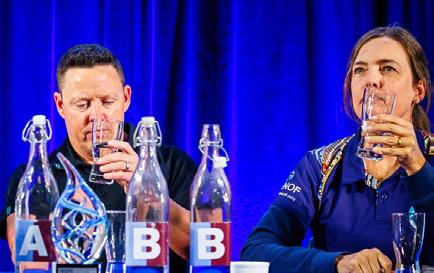
EVENT INCLUDES
• An Operationally focussed event program spanning two days which includes 18+ Paper Presentations, Poster Presentations, a Keynote speaker and WIOA Members forum
• QLD Women of Water Breakfast
• IXOM Water of Origin Competition
• 2024 QLD Awards Dinner
• QLD Main Tapping Competition
• Free Visitor Admission to the Expo Hall with over 119 exhibitors showcasing their latest innovations, services and products
• Competitions, entertainment, freebies and charity raffle Join our attendance waitlist, email us at info@wioa.org.au






PROUDLY SPONSORED BY
Sponsorship opportunities are available, for more information email Glenn Alford at glenn@wioa.org.au FOR MORE INFORMATION VISIT WIOA.ORG.AU



nbn is committed to driving positive change for Australia. We are continually implementing actions across diversity, inclusion, safety, governance, and sustainability including achieving Near-Term Science-Based emissions reductions and Net-Zero emissions no later than 2050.
We are focused on delivering positive and sustainable outcomes for Australia now and into the future. Make nbn part of the plan
Find out how nbn can do more for your build Visit nbn.com.au/OurImpact
Made to be sustainable

 JEMENA’S NEW MANAGING DIRECTOR
JEMENA’S NEW MANAGING DIRECTOR




















































































 By Terry Chapman, APA General Manager, Project Delivery
By Terry Chapman, APA General Manager, Project Delivery











































































































































































